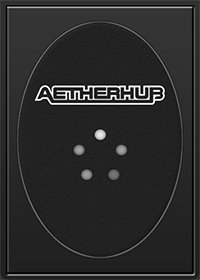Ravnica Allegiance Limited Ratings
The AI ratings are gathered with from the MTGA Assistant deck tracker. Pro ratings are provided by Nizzahon Magic. The Pro ratings and comments are made before the set officially releases while the AI ratings are dynamically updated with new data all the time.
- 5.0 The absolute best you can get.
- 4.5 Incredible bomb, but not unbeatable.
- 4.0 Good rare or top-tier uncommon.
- 3.5 Top-tier common or solid uncommon.
- 3.0 Good playable that always make the cut.
- 2.5 A solid playable that rarely gets cut.
- 2.0 A good playable, but is sometimes cut.
- 1.5 Filler card but sometimes gets cut.
- 1.0 Not good filler and often gets gut.
- 0.5 Almost Unplayable and mostly sideboard material.
- 0.0 Not playable at all.
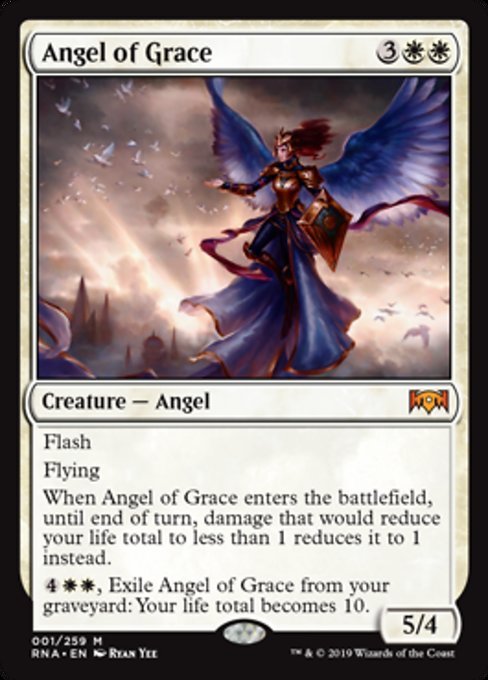
Angel of Grace
AI Rating: 5Pro Rating: 5.0
Once Flash creatures get this big, flashing them in and killing something becomes much easier. Add the rest of the text on this thing and it clearly becomes a straight-up bomb, something it was already pretty close to being with key words and stats alone! The fact that she can make it so you don’t die for a turn will come up from time to time. There will be times where you flash this in to save you and maybe trade, and then put your life back up to 10 on your turn. That’s not the ideal scenario for her, certainly, you’d rather she stay in play – but she can do some good work in a variety of situations, and help you come back from the brink of losing.
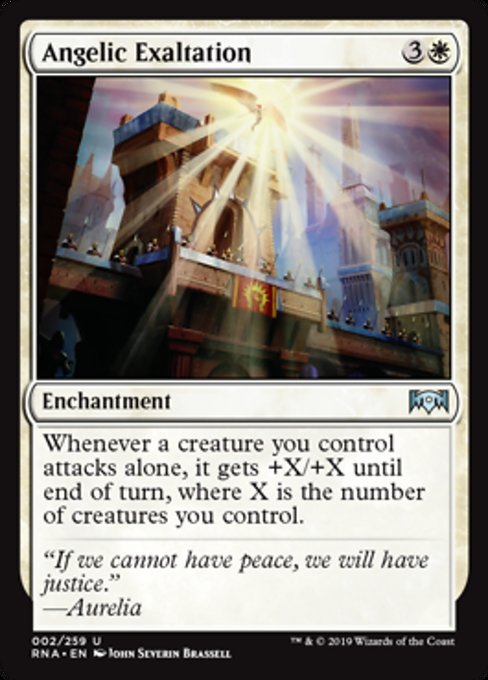
Angelic Exaltation
AI Rating: 2.8Pro Rating: 1.0
This costs a lot of mana for something that doesn’t add a body to the board, and while it does effect it as soon you attack alone with something, it requires further set up beyond that to really be relevant.
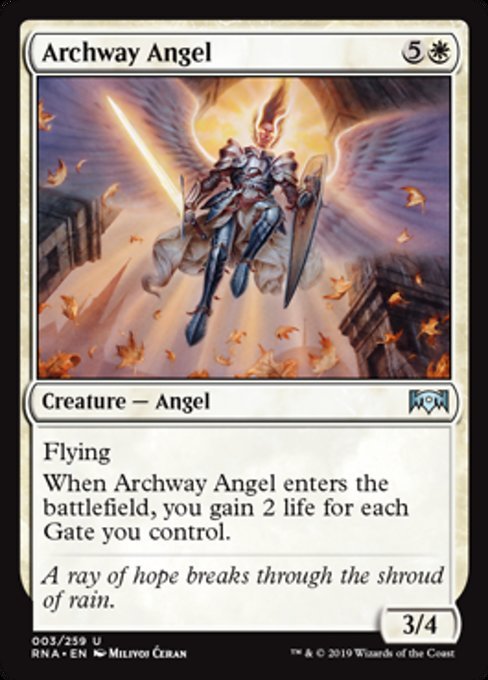
Archway Angel
AI Rating: 3.4Pro Rating: 3.5
Gate decks are pretty real in this format, and Archway Angel is one of the best payoffs, as it can come down, giving you a significant body, and gain you enough life to stabilize in many cases.
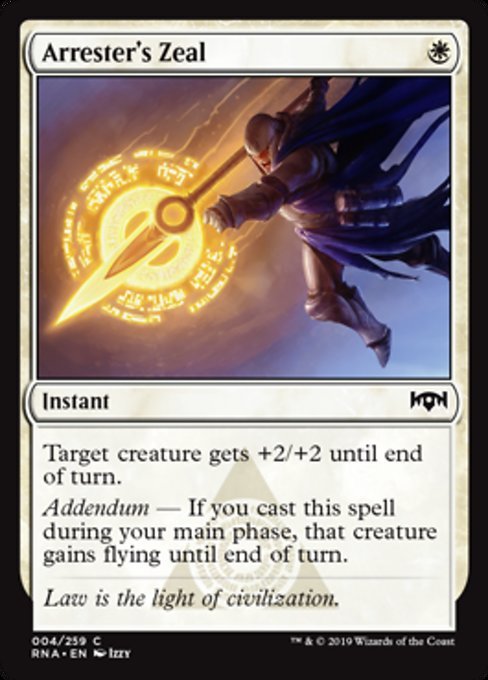
Arrester's Zeal
AI Rating: 1.6Pro Rating: 1.5
This is a decent trick that has the upside of letting you do lethal in the air sometimes.
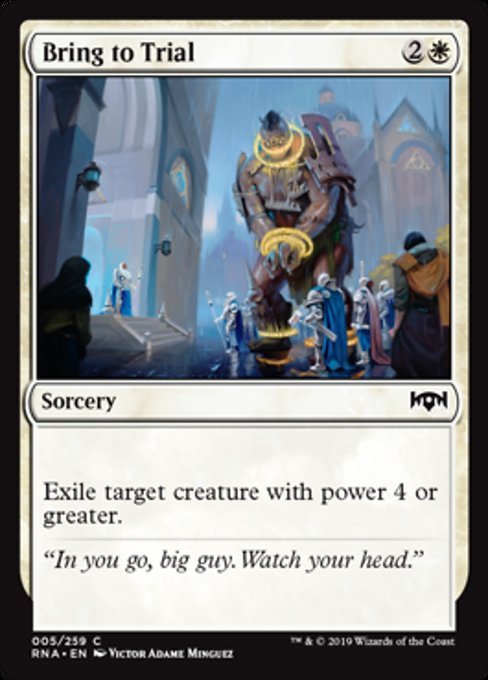
Bring to Trial
AI Rating: 1.7Pro Rating: 1.5
As usual, there aren’t really enough big creatures in this format for this to be anything special. Its not a disaster if you run one, but it is definitely better out of the sideboard.
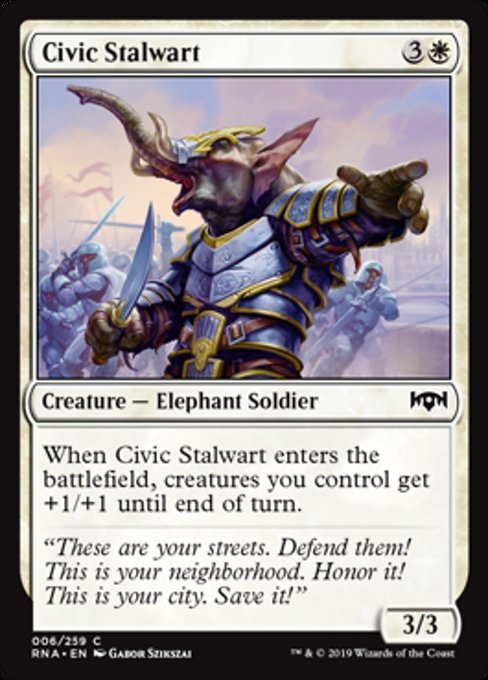
Civic Stalwart
AI Rating: 1.6Pro Rating: 2.5
A Hill Giant that pumps your whole board is always pretty decent, as it allows you to add to the board and also significantly improve your attacks.
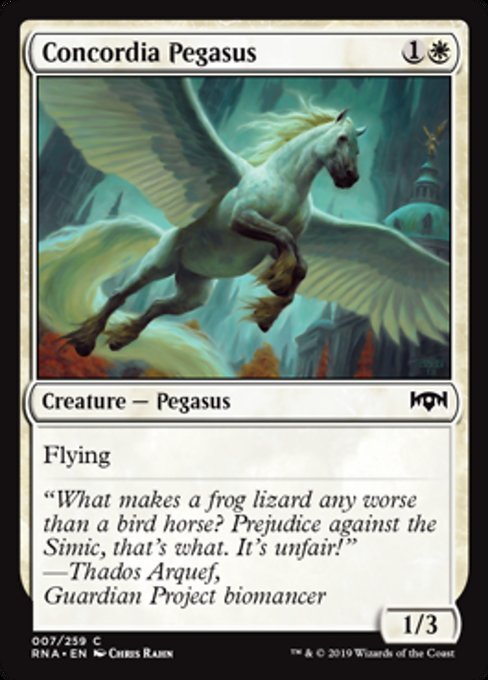
Concordia Pegasus
AI Rating: 2.2Pro Rating: 1.5
This is a French Vanilla flyer with decent stats. Most of the time you hope you don’t play it, but it isn’t a disaster if you do.
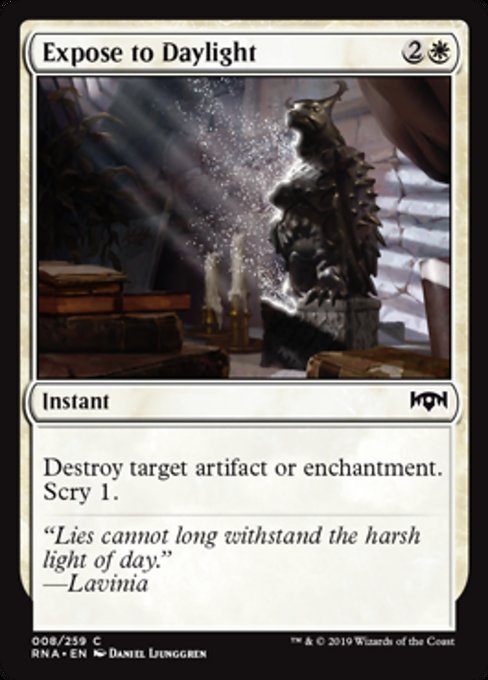
Expose to Daylight
AI Rating: 0.9Pro Rating: 0.5
This is mostly a sideboard card in this format. There just aren’t quite enough targets.
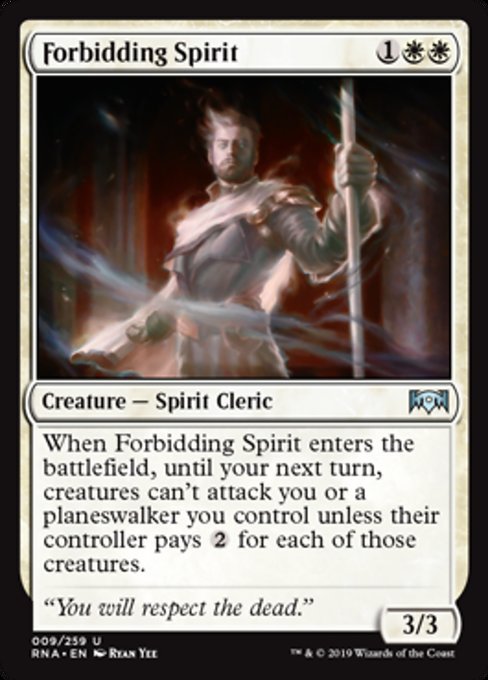
Forbidding Spirit
AI Rating: 3Pro Rating: 3.0
The ETB ability doesn’t always do something here, but its still a 3-mana 3/3 with upside, and the times where the ability does cause your opponent to have problems are pretty nice.
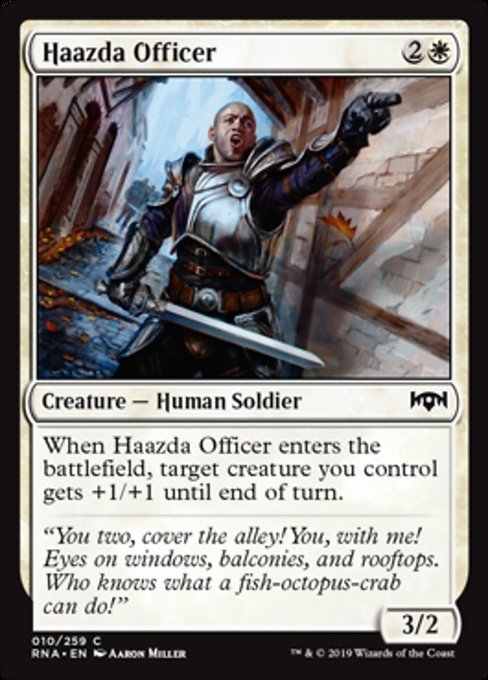
Haazda Officer
AI Rating: 1.3Pro Rating: 2.0
The ETB ability doesn’t always do something here, but its still a 3-mana 3/3 with upside, and the times where the ability does cause your opponent to have problems are pretty nice. 10 – Haazda Officer – 2.0 This adds a reasonable body to the board while buffing a creature, theoretically allowing you to attack more effectively the turn it comes down. That said, +1/+1 isn’t always enough to make that happen.
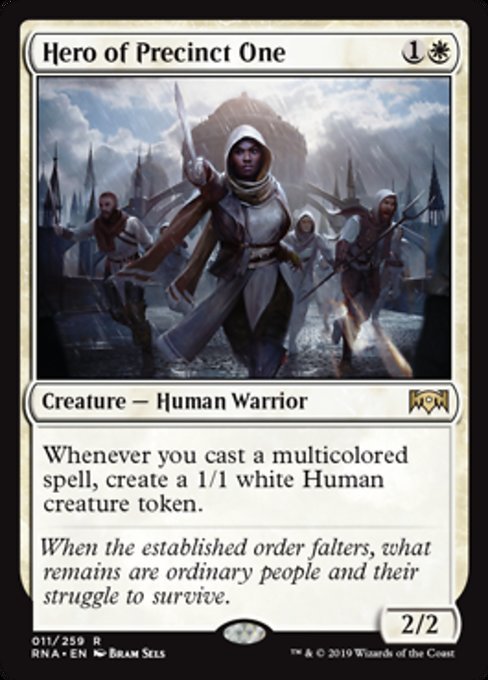
Hero of Precinct One
AI Rating: 4.9Pro Rating: 4.5
There are a ton of multicolored cards in this format, so it really isn’t that hard to build a deck where Hero of Precinct One feels like Young Pyromancer in Modern or Legacy. It will spit out a ton of tokens in no time. Even just getting one feels great, and it will frequently do far more than that!
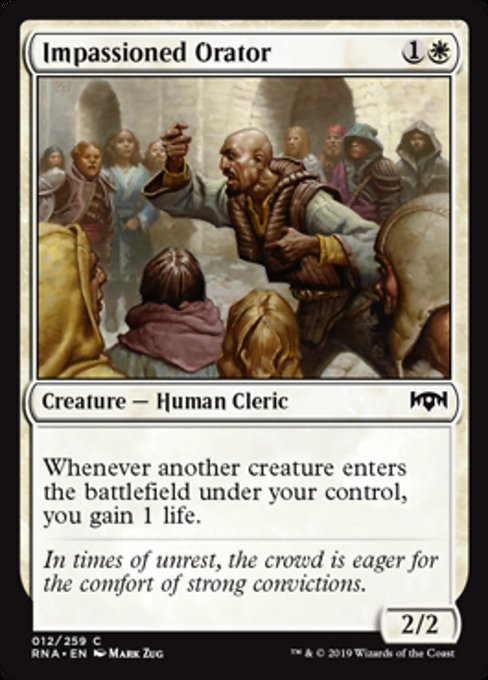
Impassioned Orator
AI Rating: 2.1Pro Rating: 2.5
The incidental life gain this provides really adds up over the course of a game, and is nice upside to have on a 2-mana 2/2.
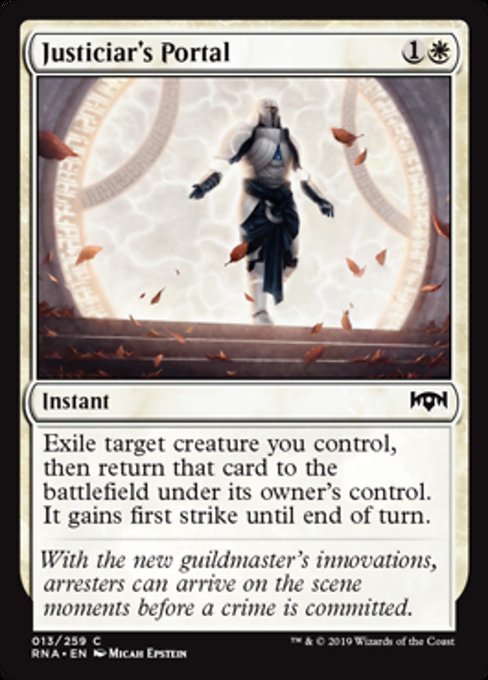
Justiciar's Portal
AI Rating: 1Pro Rating: 0.5
As usual, this kind of card is a little too situational to be worth using. Blinking just doesn’t do enough often enough, even when you add first strike to the mix.
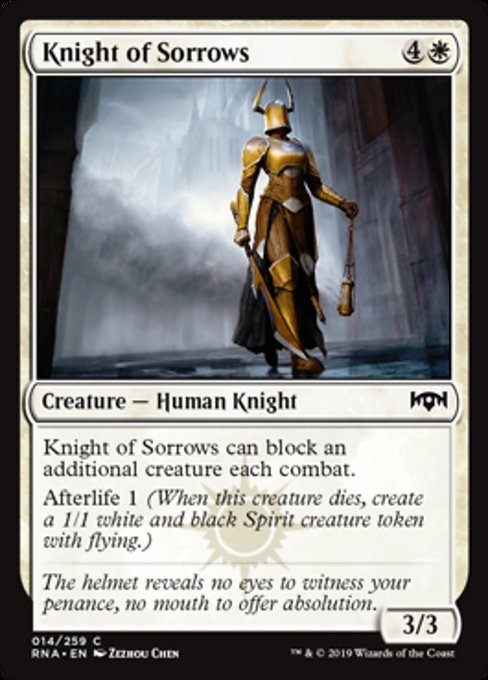
Knight of Sorrows
AI Rating: 1Pro Rating: 1.5
Afterlife is always nice, but this has such inefficient stats when it comes down that it still feels incredibly clunky.
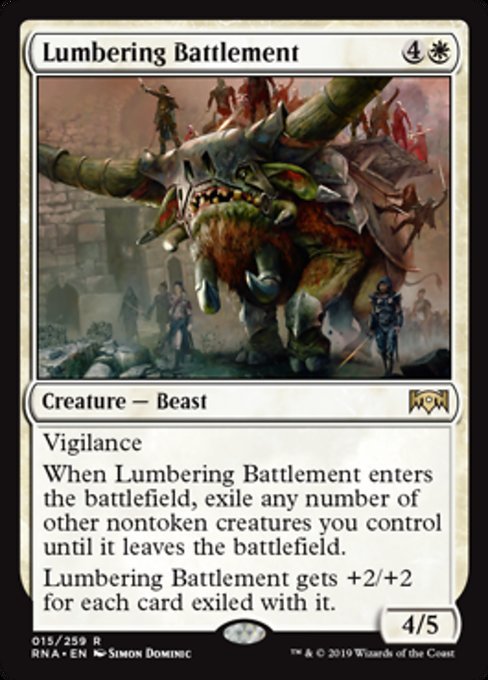
Lumbering Battlement
AI Rating: 4.3Pro Rating: 3.5
A 5-mana 4/5 with Vigilance is a good starting point, and this comes with the ability to buff itself with your other creatures. It isn’t always worth doing, but the fact that the creatures all come back when the Battlement dies does soften the blow.
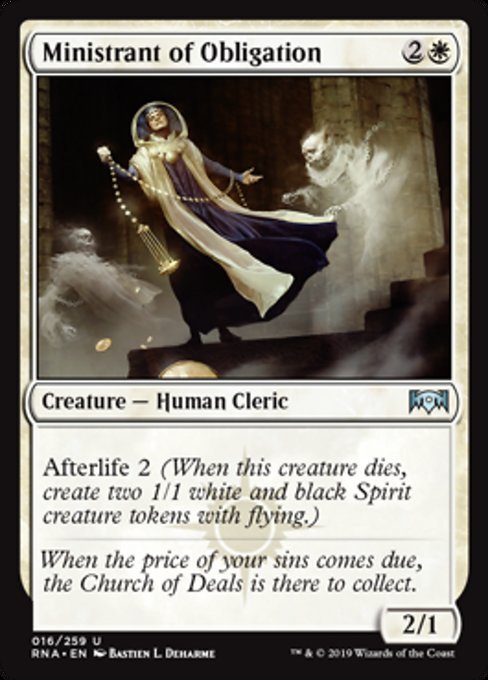
Ministrant of Obligation
AI Rating: 4.5Pro Rating: 4.0
This is just an amazing rate. A 3-mana 2/1 can trade decently enough, and if you can do that and leave two 1/1 flyers behind, you’re going to feel pretty great.
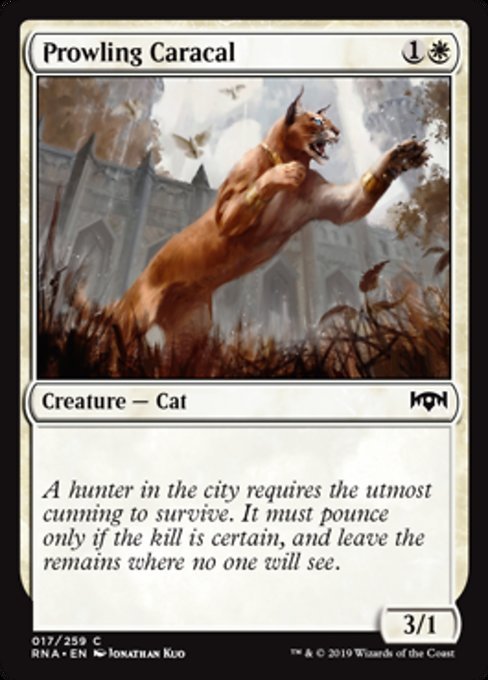
Prowling Caracal
AI Rating: 1.1Pro Rating: 1.5
This is a vanilla 2-mana 3/1. If you’re in an aggro deck and don’t have enough two drops, you’ll probably play it.
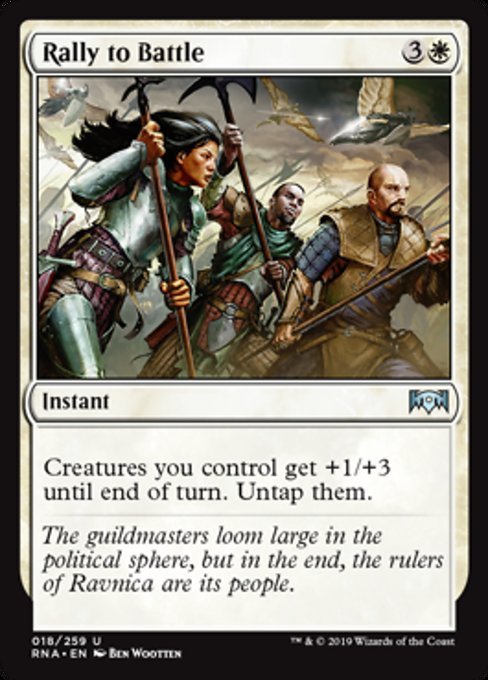
Rally to Battle
AI Rating: 1.2Pro Rating: 1.0
This is too expensive for a mass pump effect that only boosts power by 1. You can try to use it to ambush your opponent, but if that’s your main plan with something like this, you’re going to be pretty disappointed, because it becomes far more situational when that’s the case.
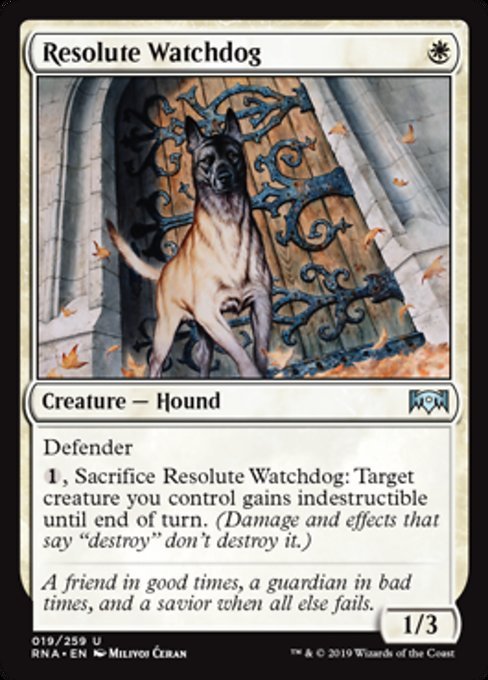
Resolute Watchdog
AI Rating: 2.8Pro Rating: 2.0
This can come down and block reasonably well in the early game, and being able to make a better creature indestructible is decent upside.
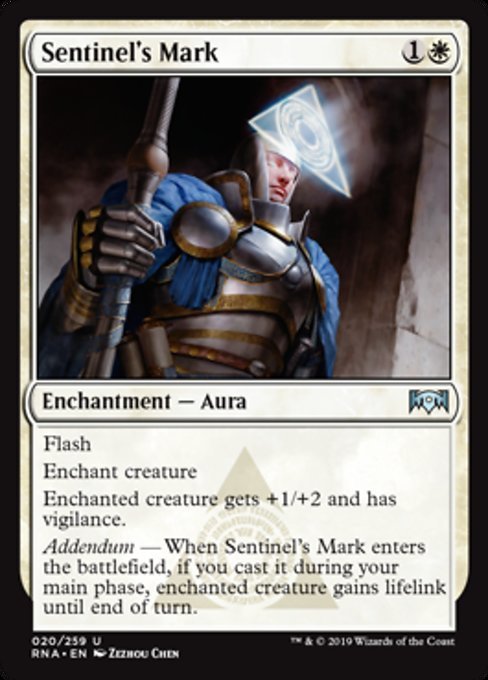
Sentinel's Mark
AI Rating: 2.6Pro Rating: 2.5
This thing really overperforms. If you can flash it in and use it like a combat trick, that tends to feel pretty good, and if you play it during your main phase for Addendum, it also feels pretty nice.
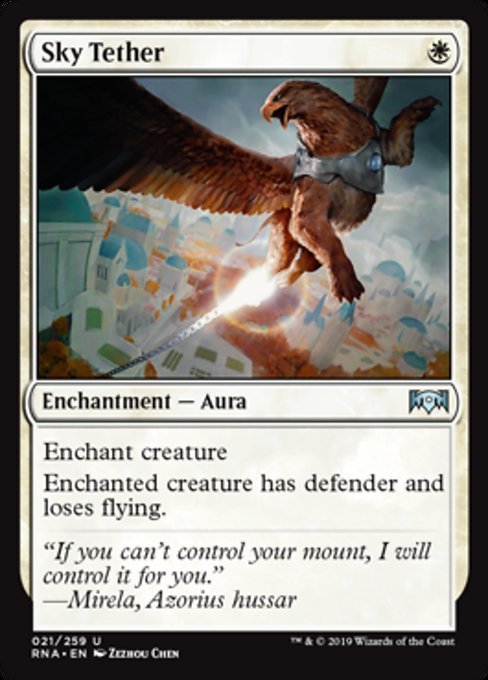
Sky Tether
AI Rating: 3.5Pro Rating: 2.5
If your deck has a lot of fliers this can be pretty good. If it doesn’t, it can be pretty mediocre, because the creature you put it on can still do everything apart from attack.
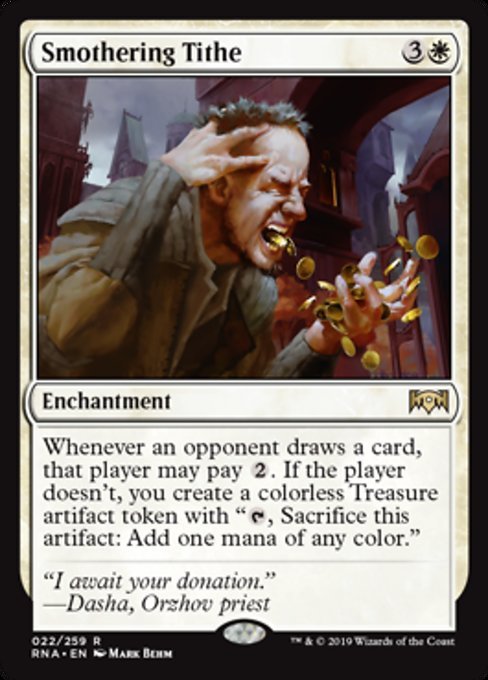
Smothering Tithe
AI Rating: 3Pro Rating: 0.0
This is an EDH staple of course, but its terrible in Limited. You don’t end up having enough stuff to use the treasure on, and its an Enchantment that doesn’t do anything at first.
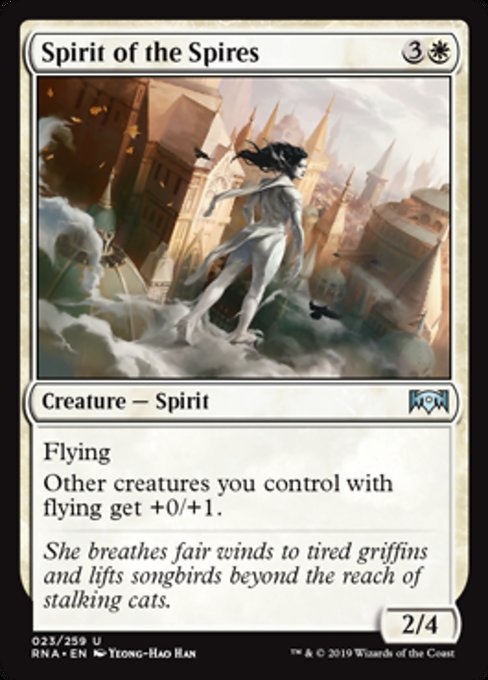
Spirit of the Spires
AI Rating: 3.5Pro Rating: 2.5
This has decent stats and okay upside, especially if your deck has a decent number of fliers.
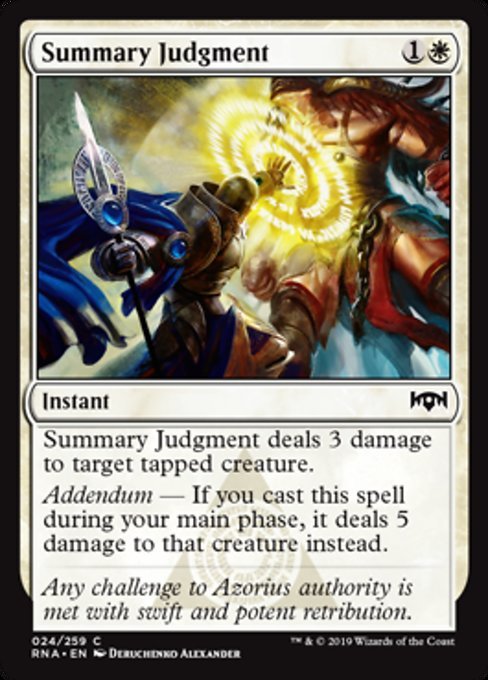
Summary Judgment
AI Rating: 3.6Pro Rating: 2.5
Its conditional, but its also pretty efficient. Its more efficient if you use it during your main phase, but if you can kill a creature before it hits you with the 3 damage, that’s obviously a little bit better.
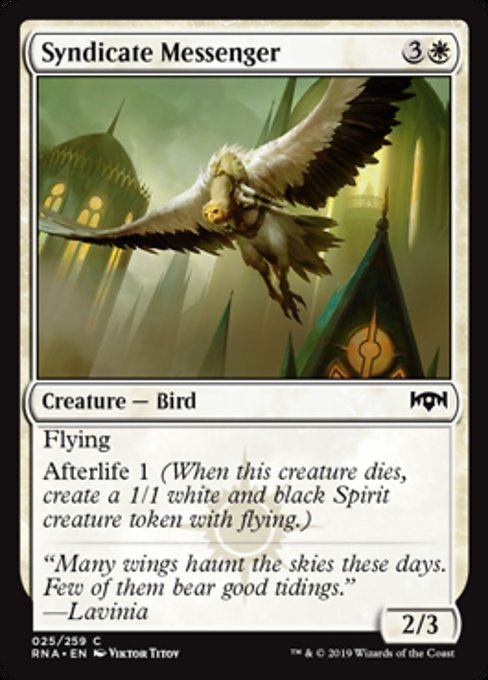
Syndicate Messenger
AI Rating: 3.2Pro Rating: 2.5
This has almost-passable stats, so adding Afterlife 1 to the card is pretty nice! Like a lot of them, it can trade and then leave behind a token, which feels pretty good.
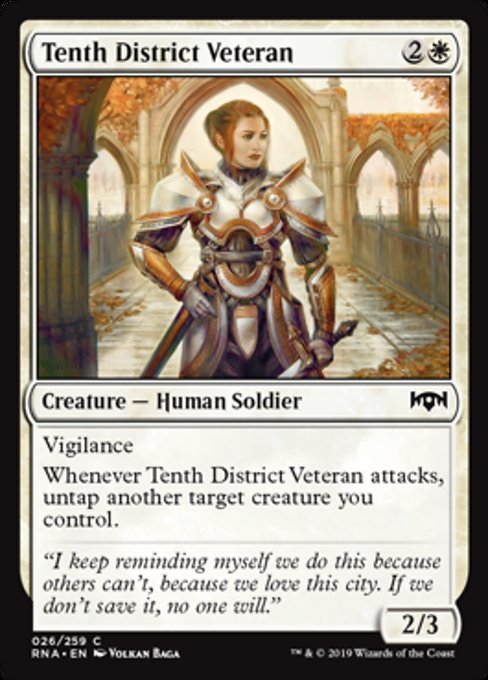
Tenth District Veteran
AI Rating: 1.6Pro Rating: 1.5
This has mediocre stats and a pretty mediocre ability. Untapping one of your other creatures just doesn’t make a huge difference most of the time.
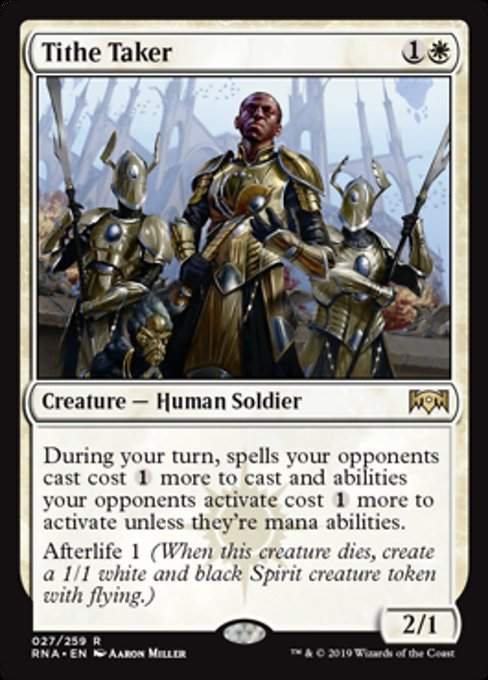
Tithe Taker
AI Rating: 5Pro Rating: 3.5
Most of this card’s value simply comes from being a 2-mana 2/1 with Afterlife 1, but making it harder for your opponent to interact with you on your turn is nice.
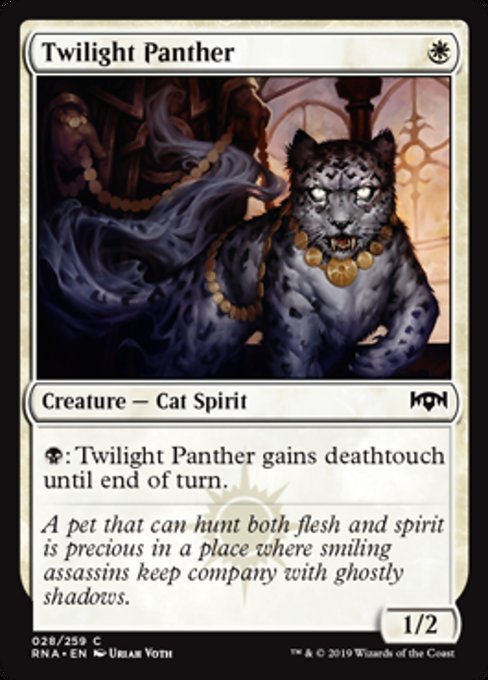
Twilight Panther
AI Rating: 2.1Pro Rating: 2.5
If you’re in Black/White, this plays like most one mana death touchers. It can trade for anything, and that’s always nice.
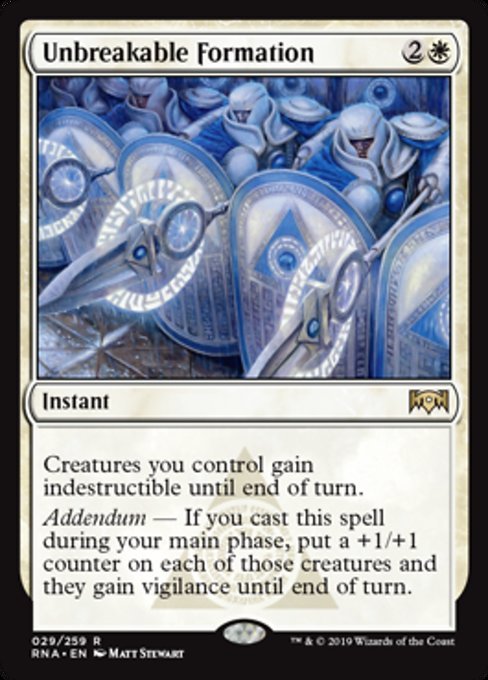
Unbreakable Formation
AI Rating: 3.8Pro Rating: 4.0
This is way better when you cast it for the Addendum bonus. Permanently buffing your whole board is a huge deal, and obviously vigilance + Indestructible makes it so that you can just swing with everything with almost no consequences. Sometimes you’ll cast it just for indestructibility to save your creature(s) or something, but that isn’t nearly as powerful most of the time.
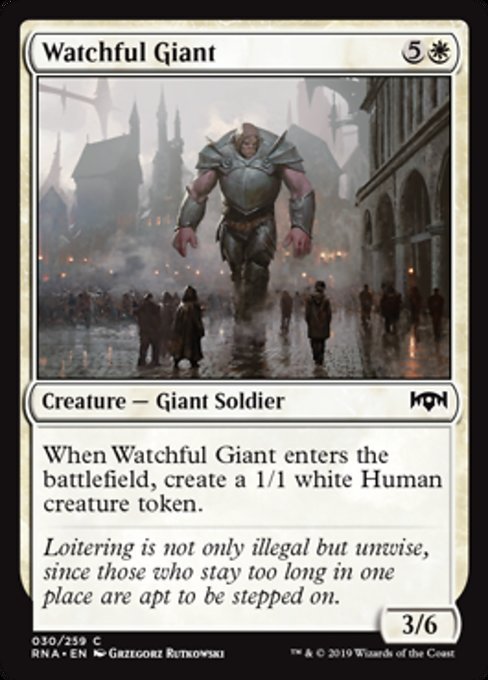
Watchful Giant
AI Rating: 1.2Pro Rating: 1.0
This doesn’t really give you enough for the mana you spend on it. The two bodies are nice I guess, but neither of them is that significant.
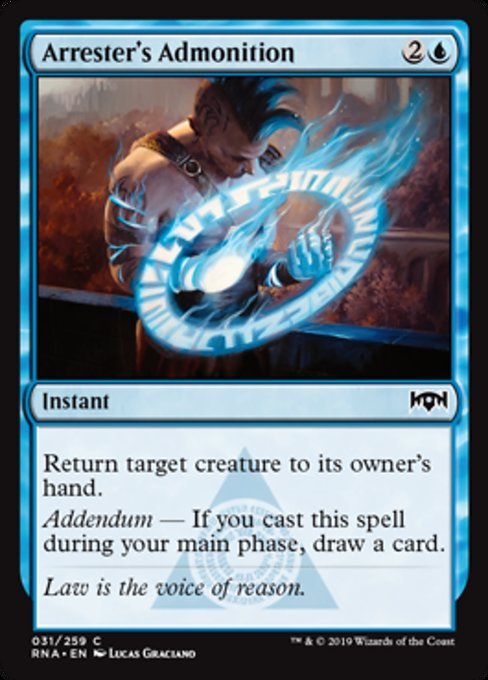
Arrester's Admonition
AI Rating: 3Pro Rating: 3.0
Casting this with the Addendum feels pretty good, as you end up breaking even on cards and getting some pretty good tempo, and you can of course cast it without the Addendum in a pinch – like if your opponent is trying to use a combat trick or something.
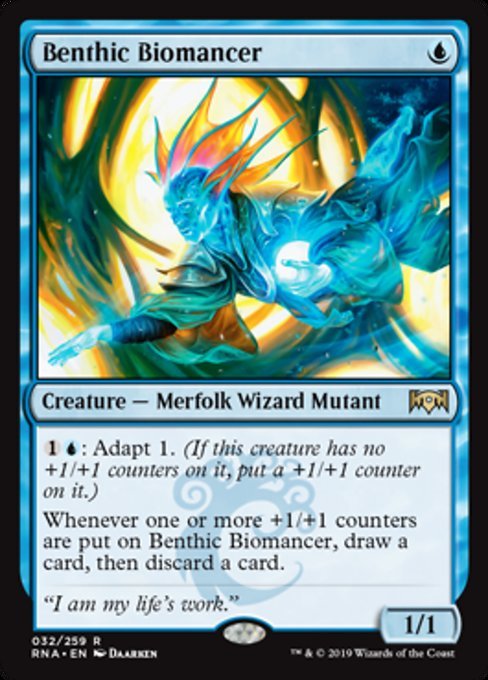
Benthic Biomancer
AI Rating: 4.3Pro Rating: 2.5
At worst, this is a 3-mana 2/2 that lets you loot. That’s not an amazing card, but that’s sort of the baseline here. If you find other ways to put counters on it, you can keep on looting!
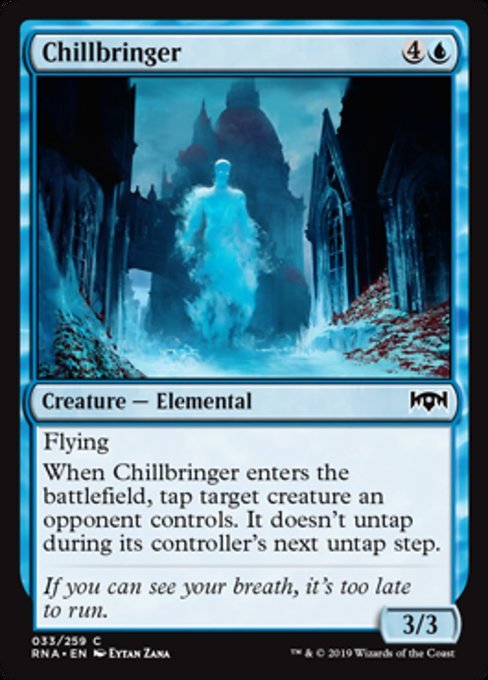
Chillbringer
AI Rating: 3.9Pro Rating: 3.5
Creatures that come down and have an immediate effect on the board are great, and Chillbringer freezes a creature down while giving you a pretty real flying body. This is an excellent Common, even as a five drop, you’d be happy to play as many as four of these. They just tend to swing the common in your favor way more often than your typical Common.
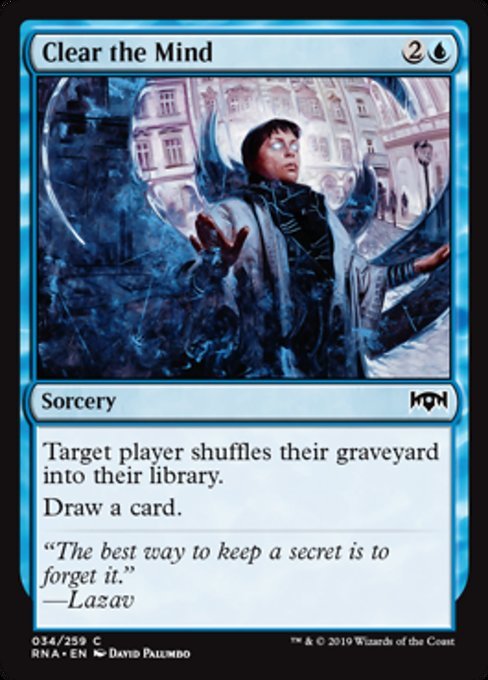
Clear the Mind
AI Rating: 2.2Pro Rating: 0.0 // 2.5
This card would be an F in most formats, but this format actually has real enough control decks that you can end up in a deck where Clear the Mind is sort of your win condition, since it keeps you from milling yourself out, while your opponent won’t be so lucky. You do generally need at least two of them to keep things going, but you’d be surprised how real of a strategy it is in this format.
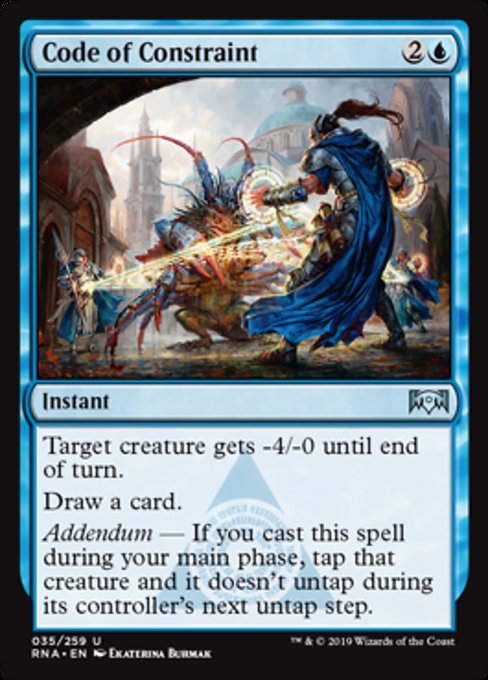
Code of Constraint
AI Rating: 2.7Pro Rating: 2.0
This is another card that gets an impressive boost from the Addendum, as it straight up freezes a card down. It is a little weird that the other effect basically doesn’t matter if you do the Addendum, so this card mostly feels like a split card with two options, and the Addendum option is way better. Adding “draw a card” to both effects is pretty nice in the right deck.
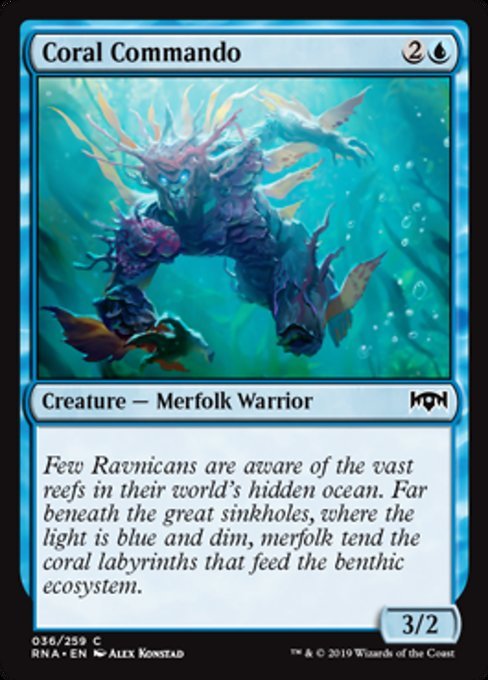
Coral Commando
AI Rating: 0.5Pro Rating: 1.0
This is an unimpressive vanilla creature that you’ll really only run if you’re desperate.
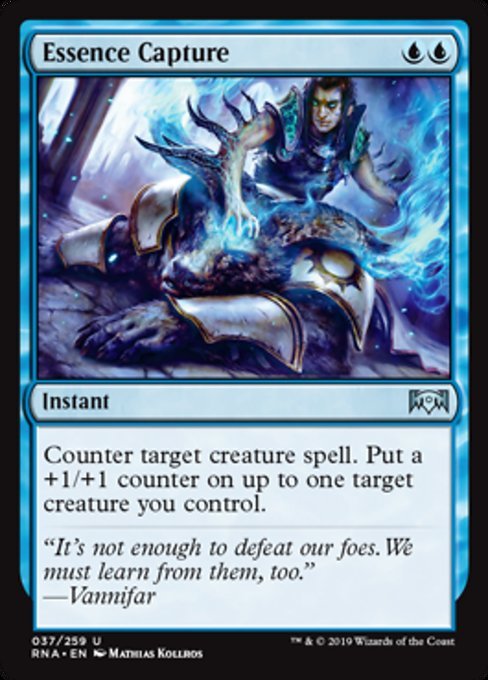
Essence Capture
AI Rating: 3.4Pro Rating: 2.0
Because this is two mana, it’s a pretty reasonable counterspell, even if it does only hit creatures. Limited decks have tons of creatures, so it works out, and adding the counter even has a bit of synergy within the Simic deck.
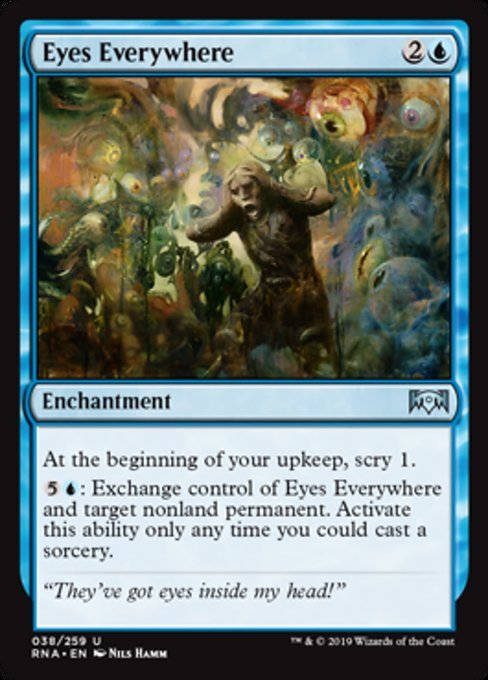
Eyes Everywhere
AI Rating: 1.7Pro Rating: 1.0
This isn’t really worth it. The Scry isn’t enough, and playing a silly mini-game with it to steal your opponent’s stuff is rough. If your opponent has no way at all to produce Blue mana it definitely gets a little more interesting, but this format has such good mana that I wouldn’t count on them not having it.
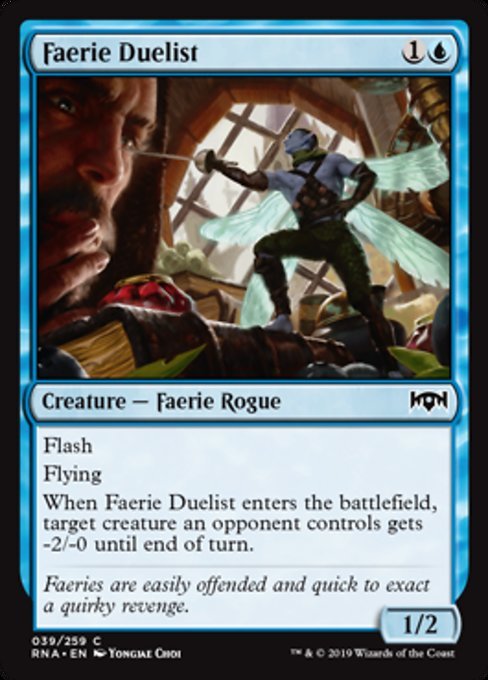
Faerie Duelist
AI Rating: 2.9Pro Rating: 3.0
This is a big overperformer. It can really alter combat in your favor, both during your turn and your opponents, while adding a pretty decent body to the board. It’s a great common.
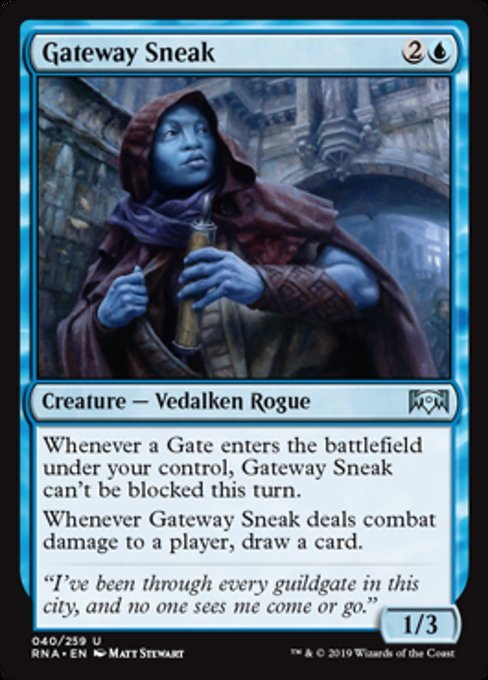
Gateway Sneak
AI Rating: 2.9Pro Rating: 3.0
Gate decks are real in this format, and this is a pretty powerful payoff, as getting in with this just nets you so much value. If you’re drawing more cards, you’re also more likely to find more Gates, too, which is likely to power many of your other cards.
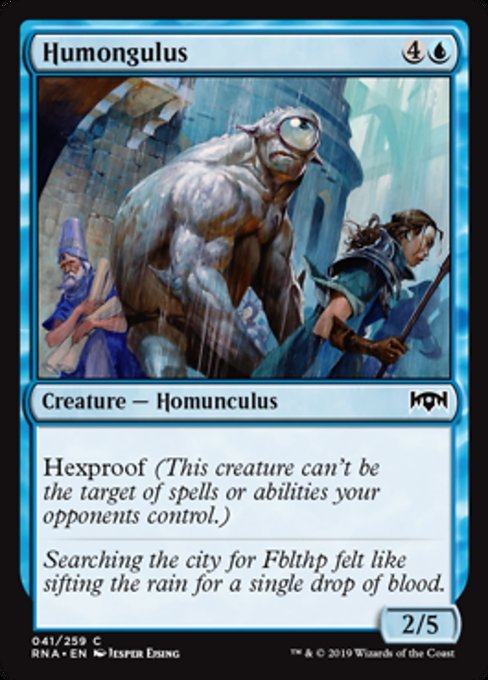
Humongulus
AI Rating: 0.8Pro Rating: 1.5
You mostly only play this if you can really take advantage of Hexproof. You can do this with +1/+1 counters and Auras and stuff like that. Otherwise, it is just sort of an inefficient blocker.
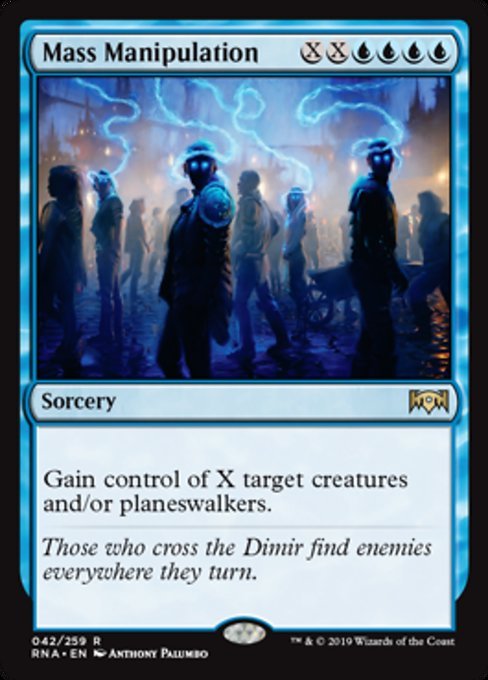
Mass Manipulation
AI Rating: 4.4Pro Rating: 4.5
This costs quadruple Blue mana, which can be a little rough, but it also utterly reshapes the board. Even just casting it for six is often game breaking, and if you get to 8 the game is completely over. That’s a lot of mana, but not an unusual amount in this format.
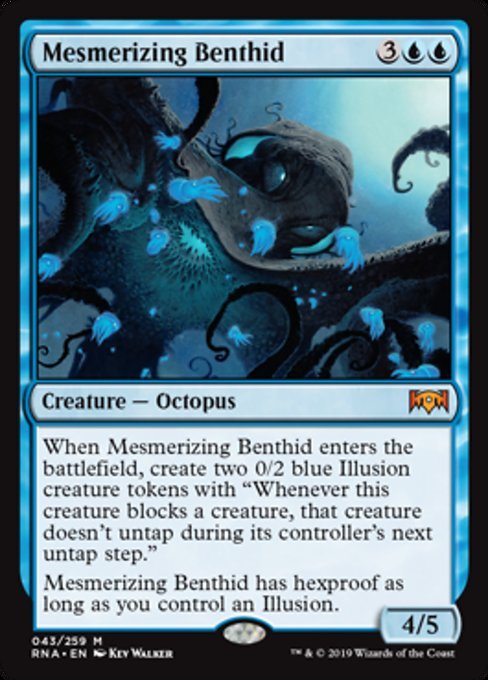
Mesmerizing Benthid
AI Rating: 4.8Pro Rating: 4.5
This is a very efficient card. You get three bodies for five mana, and the two 0/2s are really annoying tokens, since as long as you have one the Benthid is hexproof and if they have to block, they also keep creatures from untapping, which is pretty nice. It isn’t the kind of card that can really take the game over for you, but it is such an efficient deal that its worth a very high pick.
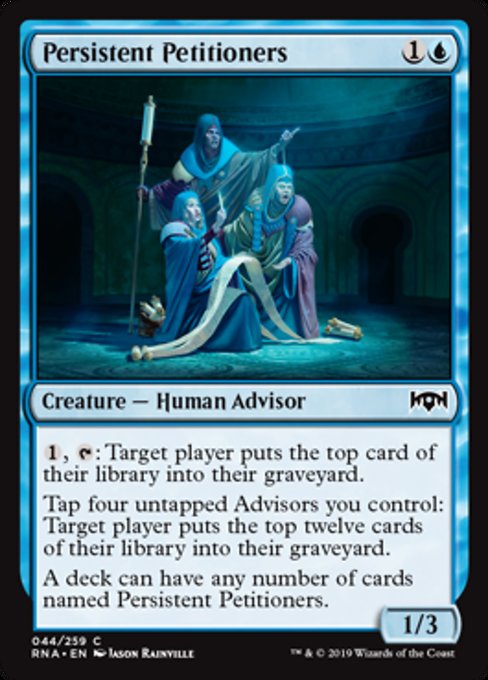
Persistent Petitioners
AI Rating: 1.5Pro Rating: 1.0
You’ll play this if you need a two-mana 1/3, but you aren’t going to assemble a mill deck with this thing.
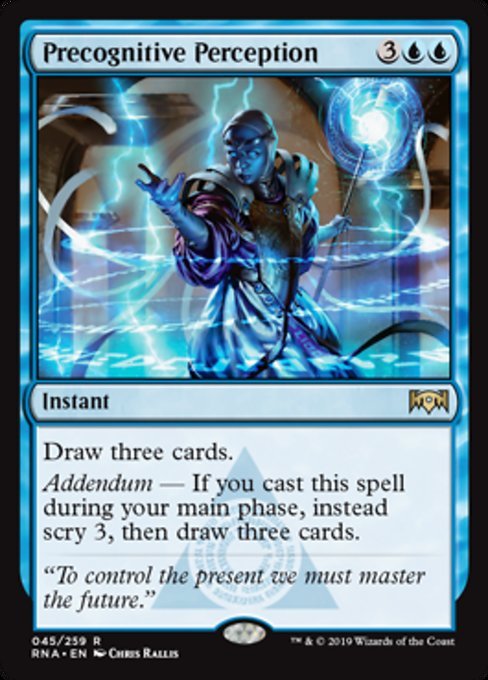
Precognitive Perception
AI Rating: 4.8Pro Rating: 3.5
5 mana to draw 3 at Instant speed is pretty nice, usually really giving you a major advantage, and sometimes you can even use the Addendum version, which gives you some awesome card selection before you draw the cards. Either way you cast it, you’re putting yourself in great position. The one downside is this is a 5 mana card that has no impact on the board.
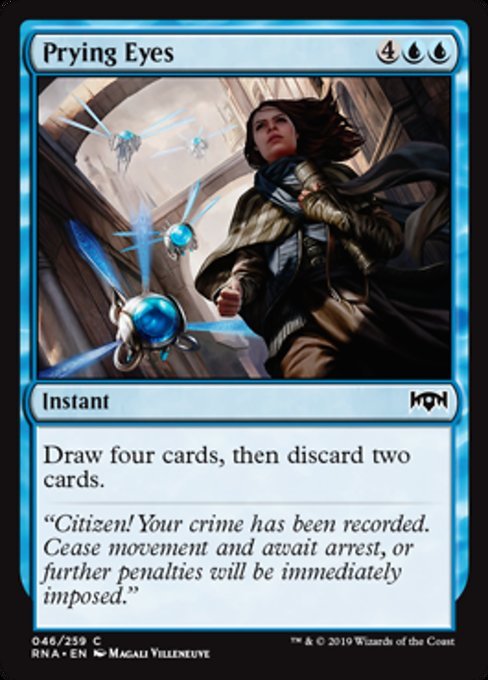
Prying Eyes
AI Rating: 0.8Pro Rating: 1.5
This is way overcosted for a card that only nets you two cards, but it does dig you pretty deep, and if your deck is controlling enough, you can run a copy.
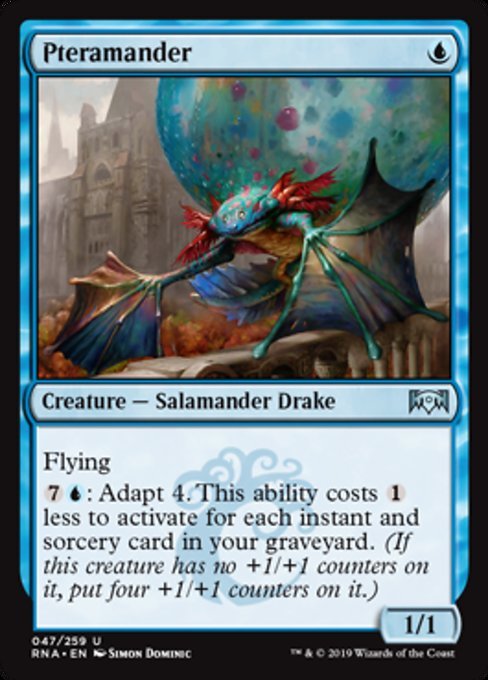
Pteramander
AI Rating: 3.8Pro Rating: 3.5
This starts out as a one mana 1/1 Flyer, which isn’t that exciting – but it does mean it’s a good attacker in the very early game, and then in the later game adapting it becomes increasingly easy, and at that point it basically becomes a dragon that can end the game quickly.
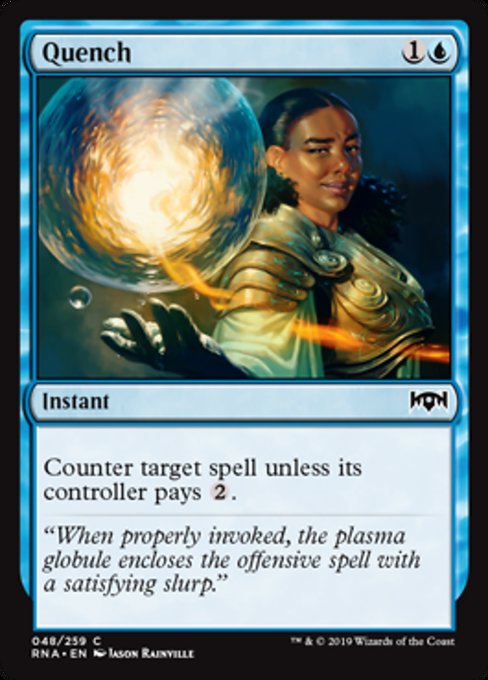
Quench
AI Rating: 1.9Pro Rating: 1.5
This can feel okay in the early game, but because your opponent is more likely to have mana around in the later part of the game, it has a pretty steep drop off.
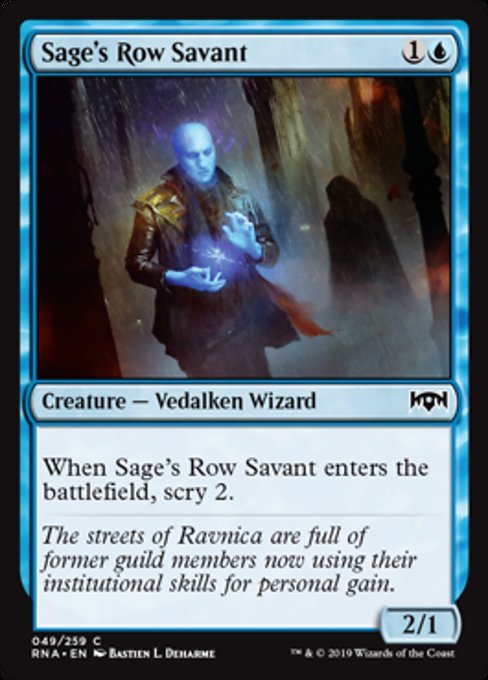
Sage's Row Savant
AI Rating: 2.2Pro Rating: 1.5
This has alright stats and an alright ETB ability, but you’re usually hoping you have a different two drop.
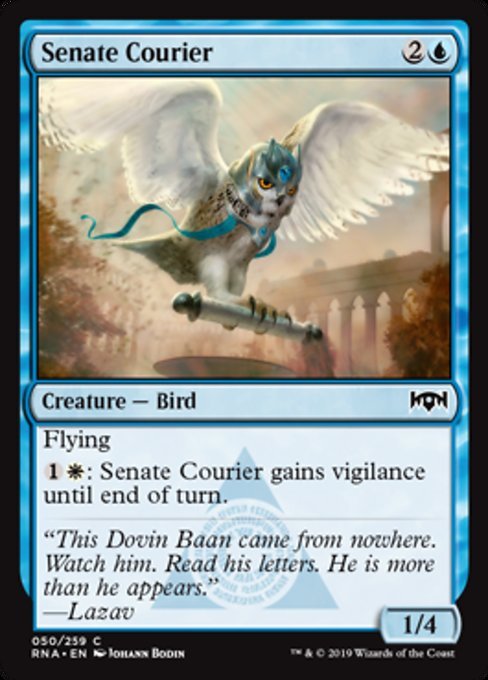
Senate Courier
AI Rating: 2.1Pro Rating: 2.0
This has decent stats, and the ability to gain vigilance actually comes up in the later part of games.
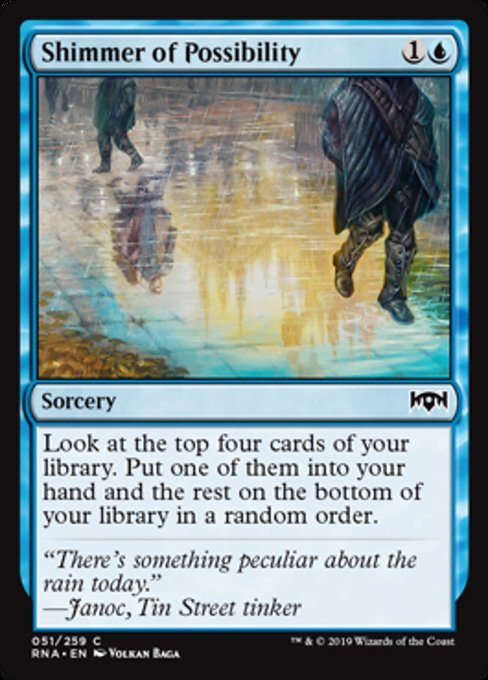
Shimmer of Possibility
AI Rating: 1.5Pro Rating: 1.5
If you’re in the spell deck, this can be worth playing, otherwise casting this isn’t very impactful.
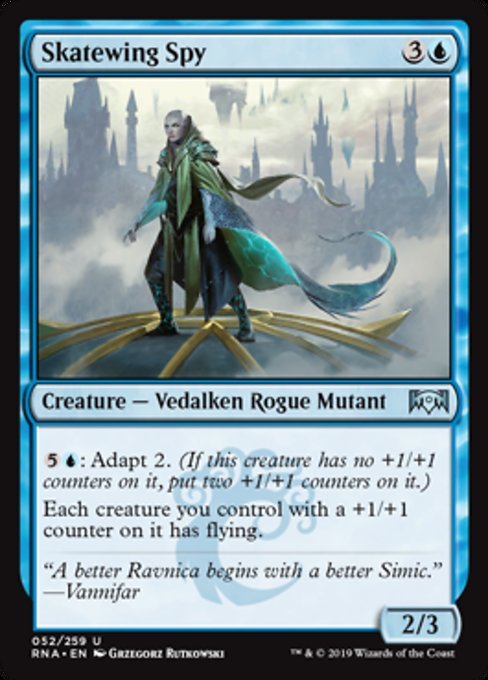
Skatewing Spy
AI Rating: 4.4Pro Rating: 3.0
4-mana for a 3/2 definitely isn’t great, but if your board already has some counters lying around, it will immediately give flying to some of your creatures, and obviously it can eventually adapt and become a Flyer itself. However, if your whole plan is adapting this, it isn’t great. You really need some other +1/+1 counters around for it to feel worth the investment – luckily, that’s not too hard to do if you’re in the Simic deck.
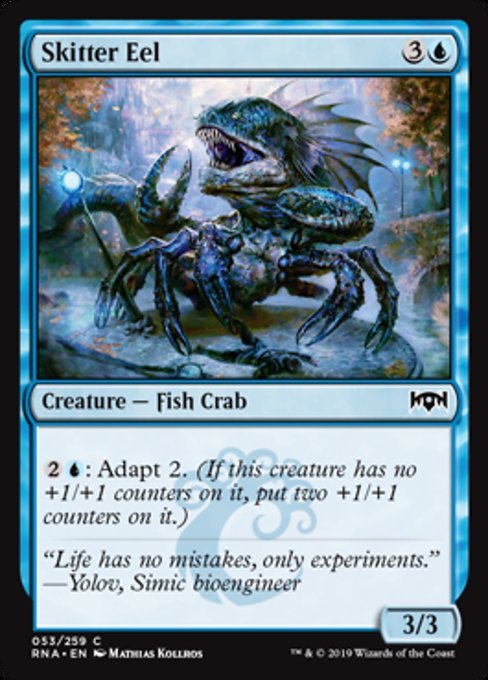
Skitter Eel
AI Rating: 2.2Pro Rating: 2.0
You’ll play this in decks that can really take advantage of +1/+1 counter synergy, but it isn’t that great in other decks, where its just inefficient – both before and after adapting.
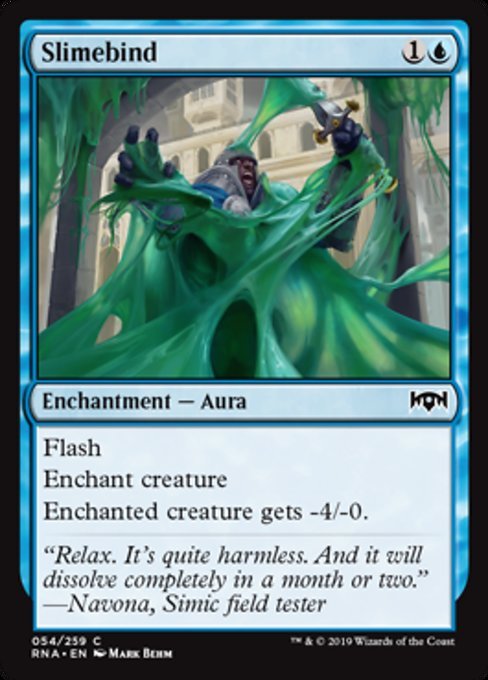
Slimebind
AI Rating: 2.3Pro Rating: 1.5
As always, this kind of removal is super underwhelming. It doesn’t do enough to actually remove a creature, only downgrading it, and it often doesn’t give you a card’s worth of value. If you’re really desperate you’ll play it, though.
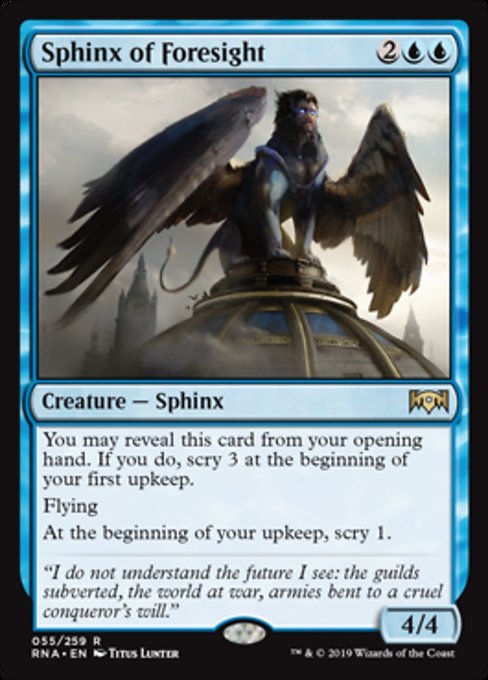
Sphinx of Foresight
AI Rating: 4.9Pro Rating: 4.5
This has great stats, and improves the quality of your draws. Getting it in your opening hand really makes it insane, since it can let you Scry before the game even begins, and that’s something that can give you a very really early game advantage.
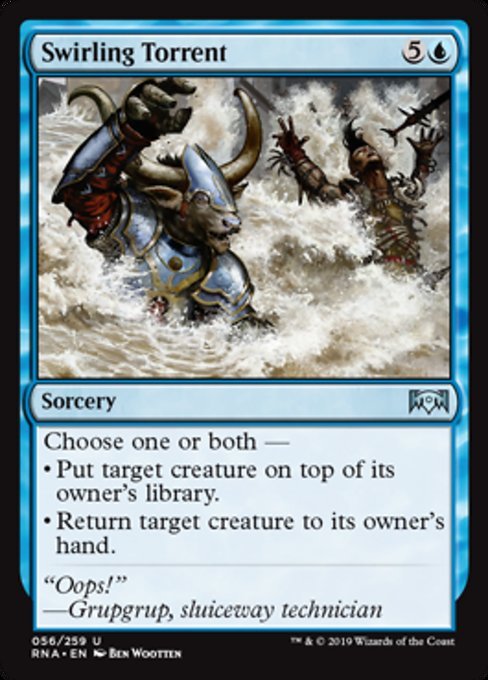
Swirling Torrent
AI Rating: 2.1Pro Rating: 1.5
This can have a big effect sometimes, as it lets you return two things, but it is a very costly card, and the fact it costs so much makes it a lot harder to come out ahead tempo-wise. Its not a bad thing to have a one-of in some decks, as it can really break a game open for you late, but that’s only for more controlling decks.
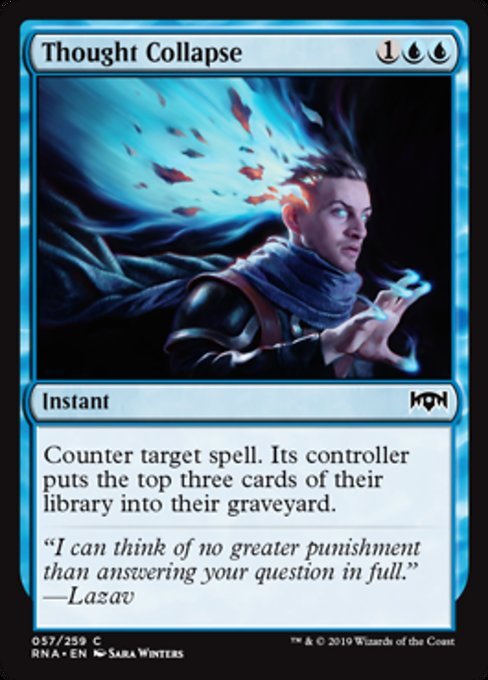
Thought Collapse
AI Rating: 2.3Pro Rating: 1.5
Cancel is never great in Limited, but the mill upside this gives you does matter a little bit in this format.
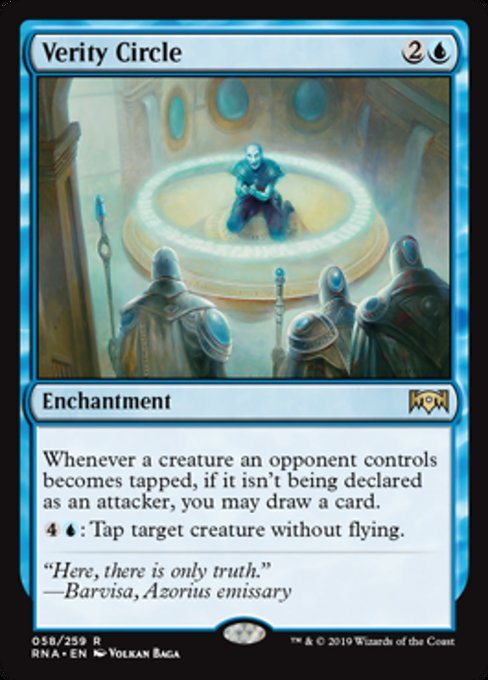
Verity Circle
AI Rating: 3.9Pro Rating: 2.0
This thing is clunky, but it is also a pretty insane late-game value engine, which you can use to lock down opposing creatures and draw a card every turn. It gets even spicier if you combine it with some other tap effects. That said, it is pretty terrible early, and even late the amount of mana it demands can be a little bit too much.
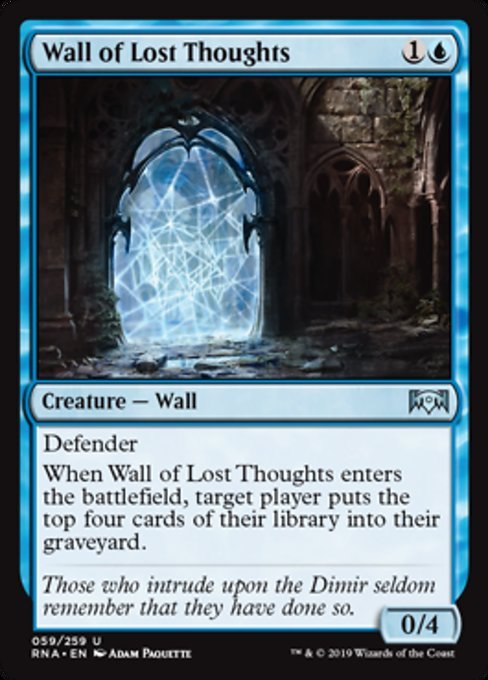
Wall of Lost Thoughts
AI Rating: 2.2Pro Rating: 2.0
Mill is a real strategy in this format, and the Wall isn’t bad in the decks that aim to do that. It slows down aggressive decks and allows you to pick away at the opposing library.

Windstorm Drake
AI Rating: 2.5Pro Rating: 2.5
A 5-mana 3/3 Flyer isn’t great, but this does buff your other flyers, and that does enough to make this a pretty reasonable playable in most Blue decks.
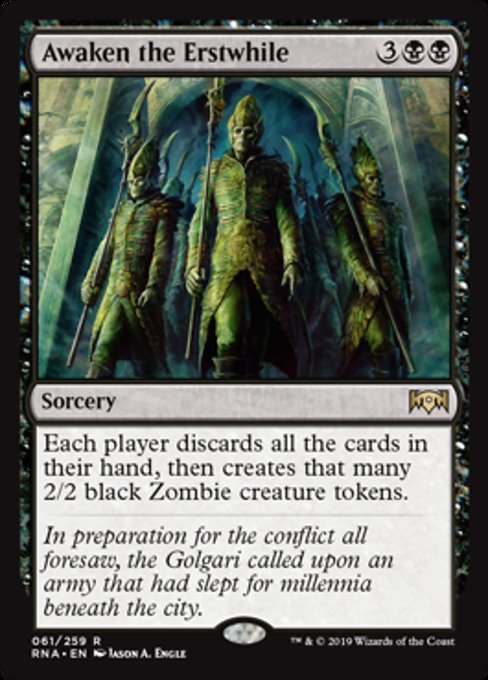
Awaken the Erstwhile
AI Rating: 3.3Pro Rating: 0.0
Yeah, this just needs too many things to work out to ever be worth it. Giving your opponent tokens too is a horrible idea, and you just don’t have that much control over who has more cards in hand.
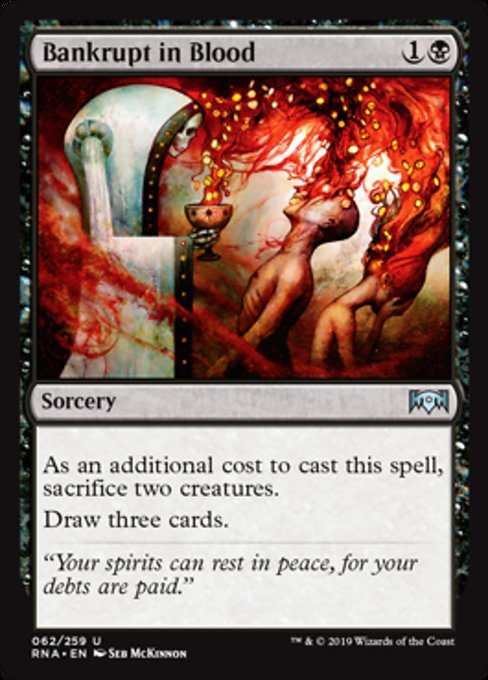
Bankrupt in Blood
AI Rating: 1.7Pro Rating: 2.0
If you have expendable creatures around, this is pretty spicy, but it isn’t something that all decks can take advantage of.
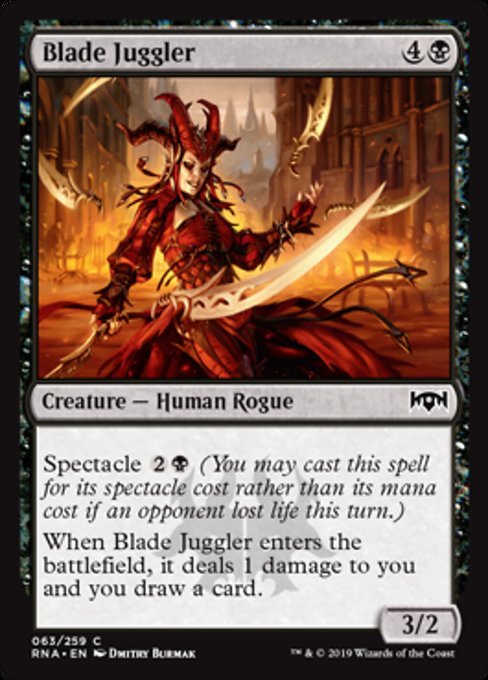
Blade Juggler
AI Rating: 3.3Pro Rating: 3.5
This is pretty good even without Spectacle, and if you can cast it with Spectacle it feels incredible. A 3-mana 3/2 that draws you a card is an amazing rate, and will virtually always give you a 2-for-1.
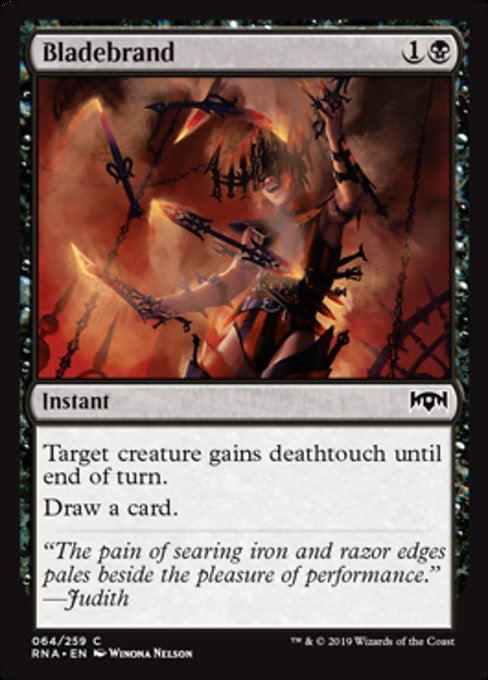
Bladebrand
AI Rating: 2.1Pro Rating: 2.5
This lets any creature trade with anything, while drawing you a card, so you don’t 2-for-1 yourself in the end. Of course, you’re still only 1-for-1ing, and using a kind of risky card. If your opponent destroys the creature you target it can be especially devastating.
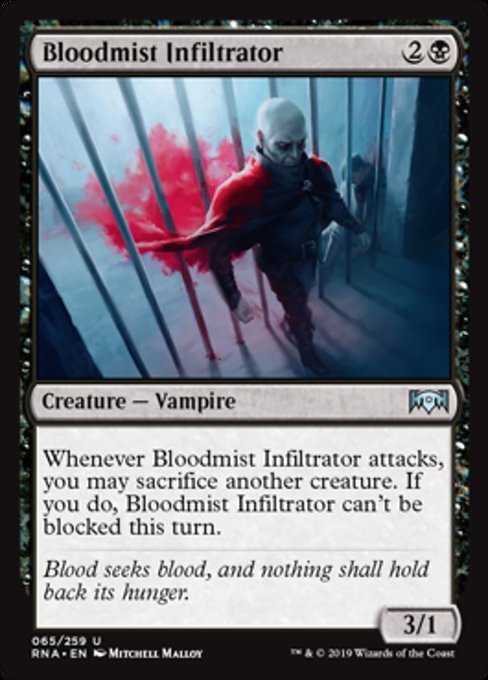
Bloodmist Infiltrator
AI Rating: 1.9Pro Rating: 3.0
This is one of the better sacrifice outlets around, as 3 unblockable damage a turn can really add up. It does die to…pretty much everything, but if your deck is capable of producing fodder for it, it is a pretty formidable creature.
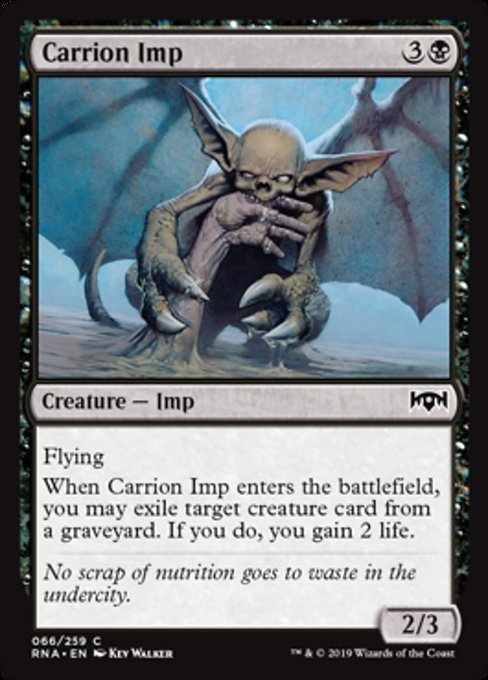
Carrion Imp
AI Rating: 1.4Pro Rating: 2.0
This gives you enough value with the ETB that paying 4 for it generally feels pretty decent. Its too bad it doesn’t drain your opponent like some other versions of this card we’ve seen over the years.
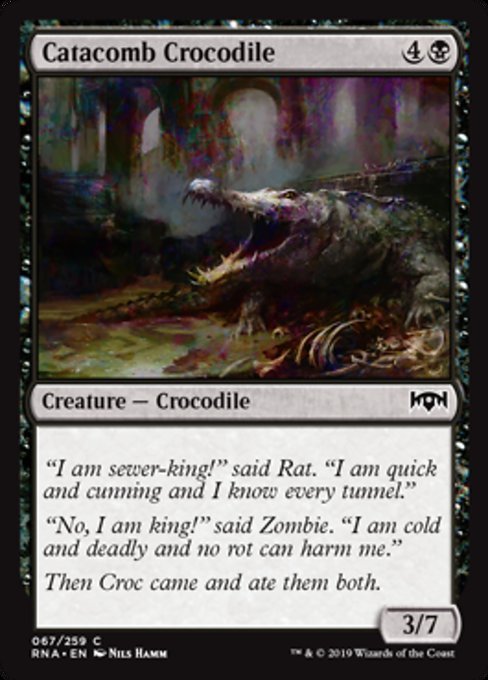
Catacomb Crocodile
AI Rating: 1Pro Rating: 1.0
If you need a defensive vanilla creature…I guess you can have this card, but I’m not sure why you would ever need one of those.
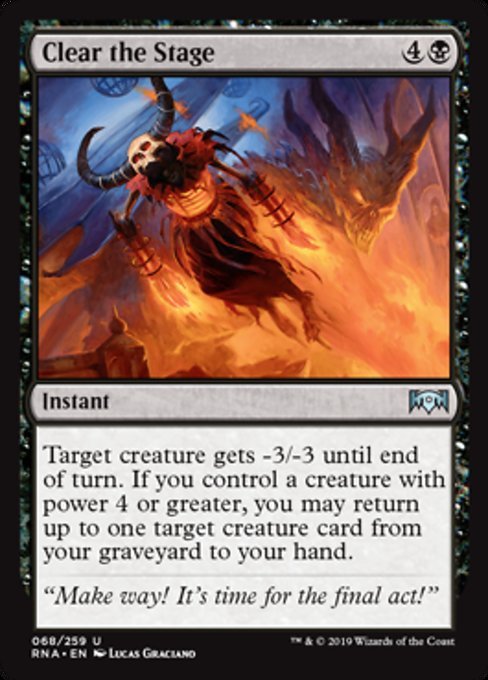
Clear the Stage
AI Rating: 3Pro Rating: 3.0
5-mana for -3/-3 isn’t very good, but if you have a few creatures with 4 or more power in your deck, it becomes pretty impressive, as killing something and getting the best creature back from the graveyard is a big deal.
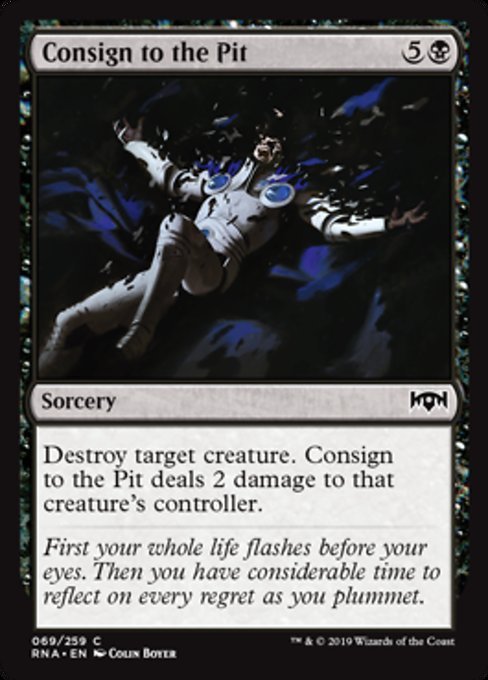
Consign to the Pit
AI Rating: 2.4Pro Rating: 2.5
Its expensive, but it does answer everything, and the two damage you get out of it is decent upside.
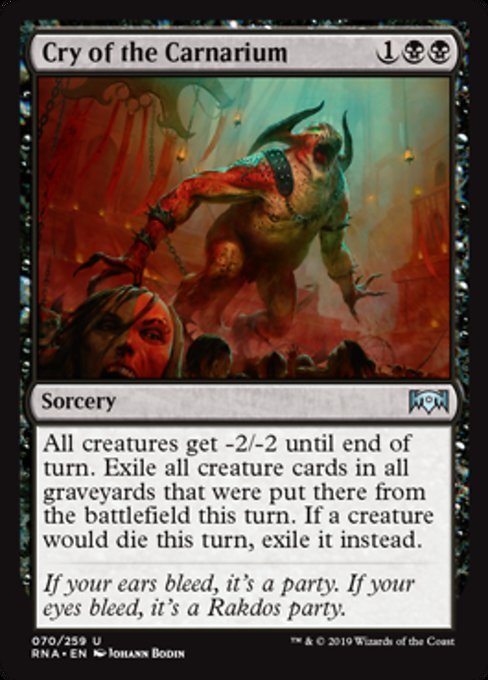
Cry of the Carnarium
AI Rating: 3.2Pro Rating: 0.5 // 3.0
In this format, you can end up in some pretty defensive and controlling decks, and in them, you don’t have very many creatures who die to this. If you’re one of those decks, this thing is a power house, as it can completely derail aggro decks in the early game, virtually guaranteeing you win. But there are lots of decks in this format that shouldn’t be interested in this in the main deck.
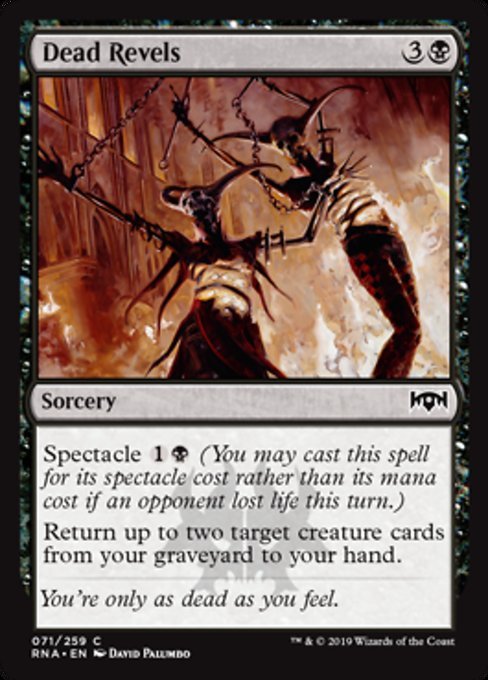
Dead Revels
AI Rating: 2.3Pro Rating: 2.5
As usual, this type of card is something you want one of most of the time in Black. Returning two things to your hand late is a good way to keep the gas going, and because you can get Spectacle going on this, you’ll sometimes even be able to cast the things you bring back right away!
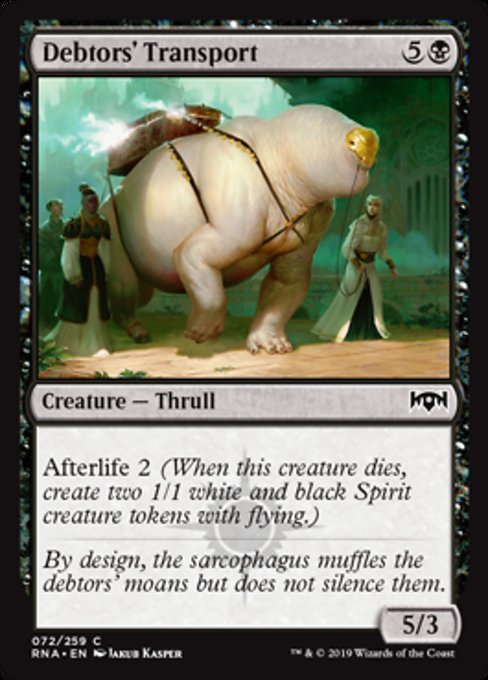
Debtors' Transport
AI Rating: 1.6Pro Rating: 2.0
While Afterlife 2 is pretty nice, the cost and base stats of this are bad enough that it isn’t that exciting. It can definitely trade and leave some bodies behind, which is fine, but it isn’t a very impressive card.
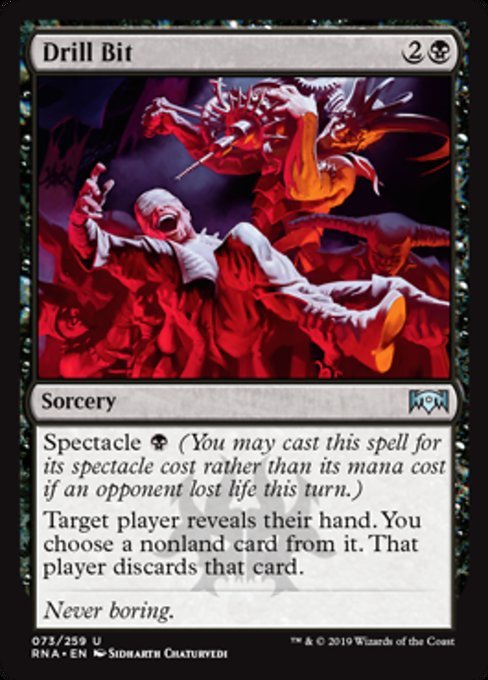
Drill Bit
AI Rating: 2.2Pro Rating: 1.0
Most spells that are just 1-for-1 discard effects aren’t great in Limited. If you could always cast this for a single Black mana it would be pretty nice, but it will cost 3 mana way too often to be worth it in most cases.
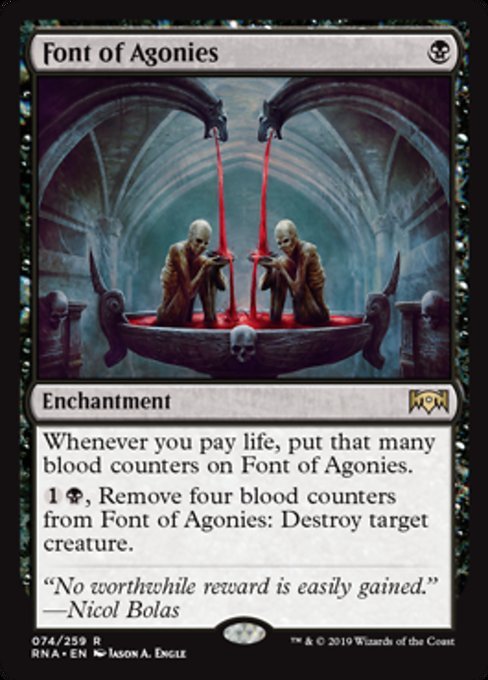
Font of Agonies
AI Rating: 1.2Pro Rating: 0.0
You can’t really get this card going in this format, there aren’t enough ways to pay life.
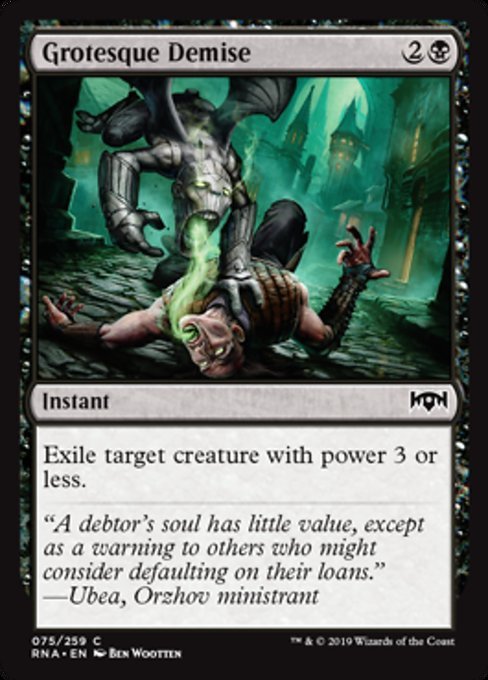
Grotesque Demise
AI Rating: 3.7Pro Rating: 3.5
This efficiently deals with a whole lot of creatures in the format, and with many of them, you even get to trade up.
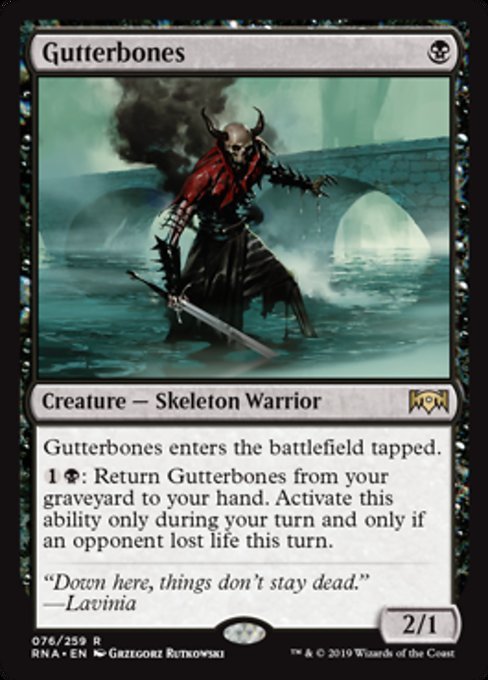
Gutterbones
AI Rating: 4.2Pro Rating: 3.0
This being recursive can be pretty nice late, as it can almost be a free attacker. And, early, it can chip in for a few damage.
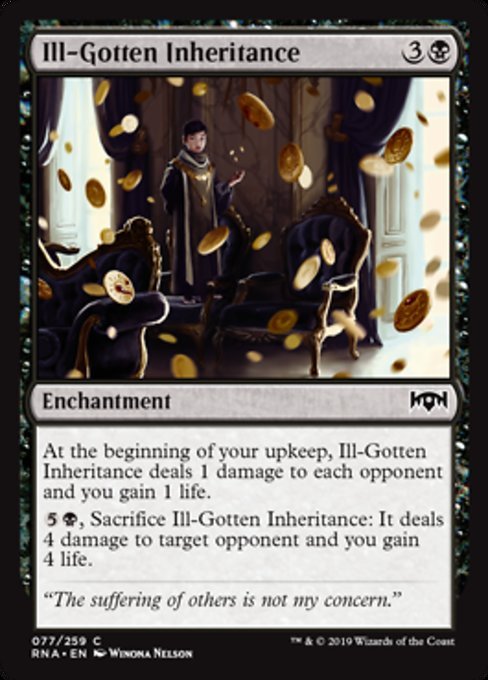
Ill-Gotten Inheritance
AI Rating: 3.7Pro Rating: 2.5
This card is a major overperformer, and another card that can really help control decks do their thing in this format. It looks like an Enchantment that doesn’t do enough up front, but the life drain it provides really makes it hard for your opponent to take you down. Basically, it will help you stabilize, and then gradually turn into your win condition in many games. Now, sometimes not adding to the board can be a real reliability against aggro decks, but this still does good work most of the time.
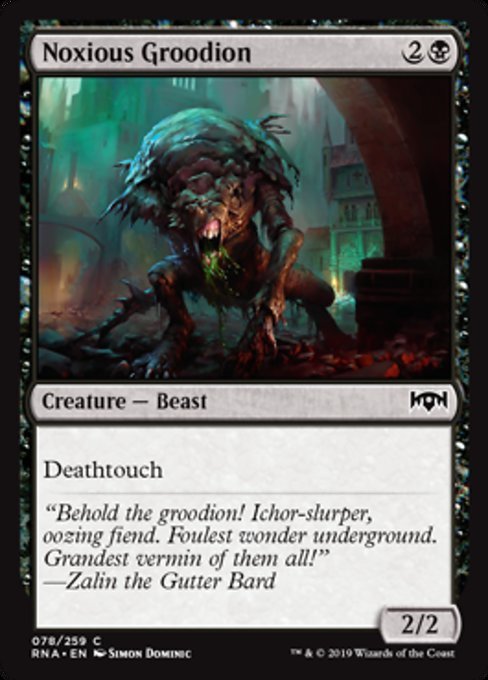
Noxious Groodion
AI Rating: 2.1Pro Rating: 2.0
This trades with everything as most death touchers do. Costing three mana does mean it is harder to trade up with it consistently, but it can still trade with everything.
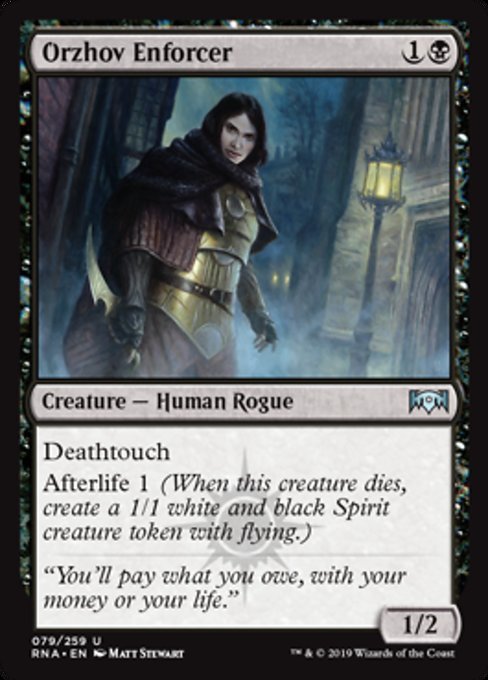
Orzhov Enforcer
AI Rating: 4.5Pro Rating: 3.5
Now THIS is a death toucher. It can trade with anything as a two mana card, and it even leaves behind a very relevant 1/1 Flyer that can really matter all game long.
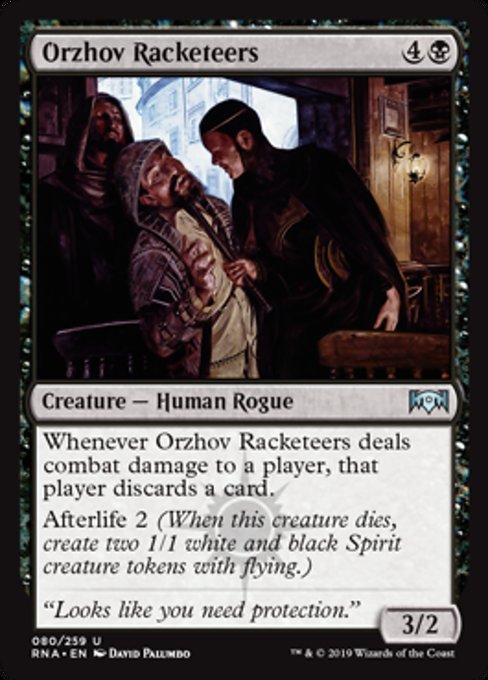
Orzhov Racketeers
AI Rating: 3.3Pro Rating: 2.5
This has some bad starting stats for the cost, but it does have some nice stuff going on. On a base level, you can simply trade this for something and enjoy your 1/1 tokens. But you’ll find yourself in a situation sometimes where your opponent just has to take this, because they don’t really want to give you the flyers, and when they do take it, they have to lose a card, which is pretty nice.
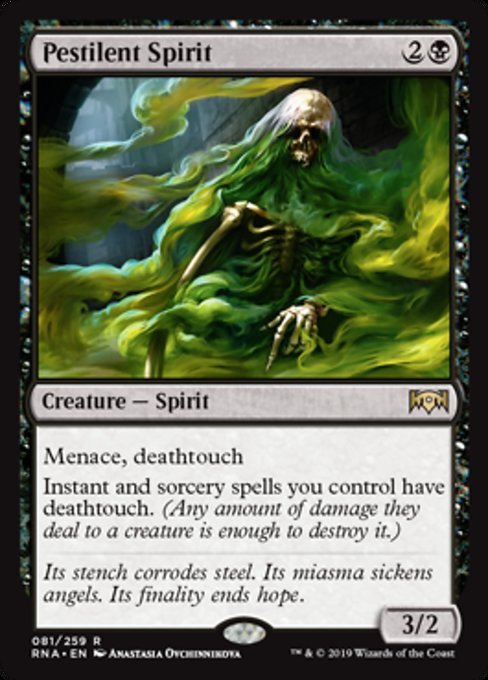
Pestilent Spirit
AI Rating: 4.2Pro Rating: 4.0
Menace and death touch pair really well together, and in a lot of ways just makes Pestilent Spirit unblockable, as your opponent doesn’t really want you to kill two of their creatures a lot of the time. They may eventually end up with some tokens and stuff like that, but it will take awhile. Giving your spells death touch is sweet too, though it mostly only comes up in Red-Black.
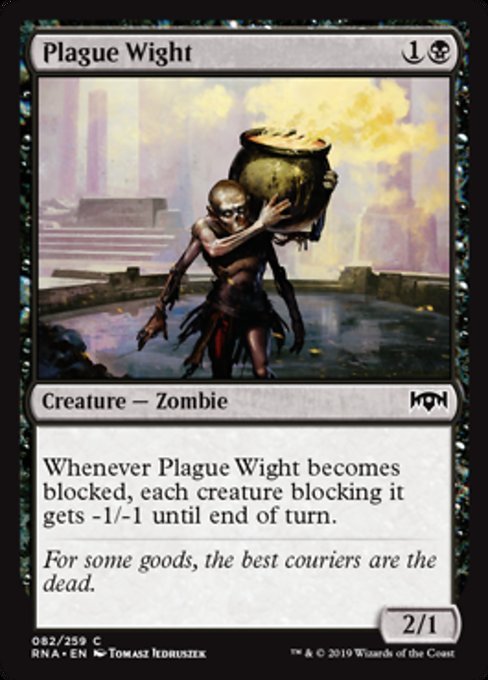
Plague Wight
AI Rating: 2Pro Rating: 2.5
This is a solid little two-drop that is pretty hard for your opponent to block effectively in the early game.
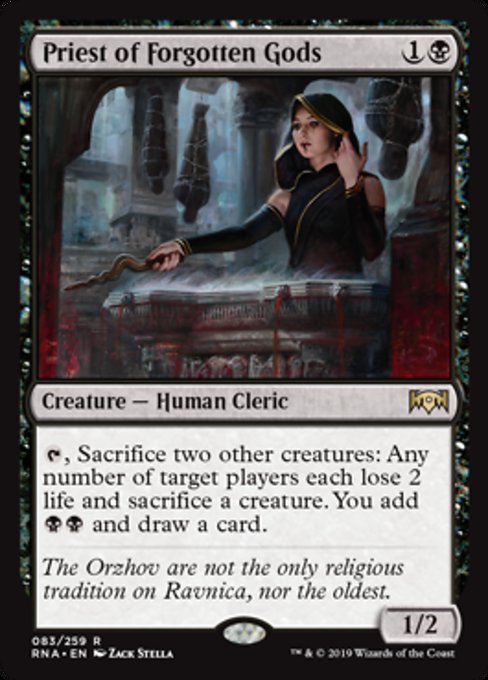
Priest of Forgotten Gods
AI Rating: 4.2Pro Rating: 1.5 // 4.5
If you can get the right deck together, this feels like an absolute bomb. If you have enough creatures with Afterlife and other token makers/expendable creatures, this card just starts to snowball, as it gives you amazing value for giving up two creatures. Your opponent’s life goes down, they lose a creature, and you get mana, AND you draw a card. Even if you can only pull it off once, it is basically always going to be in your favor. However, if your deck doesn’t really end up with the means to activate this consistently, it isn’t very good.
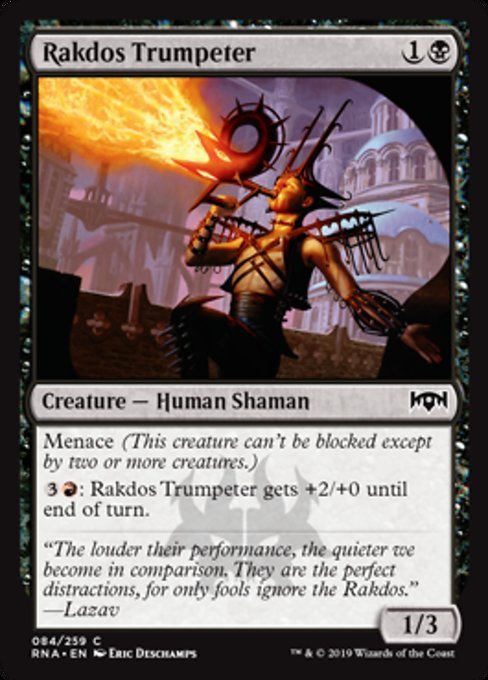
Rakdos Trumpeter
AI Rating: 1.8Pro Rating: 2.5
This little creature can be a real menace for your opponent to deal with. It doesn’t pump itself efficiently, but in the late game it is a pretty nice attacker that your opponent will really hate blocking, and obviously it is hard to block early too – though it doesn’t exactly hit hard.
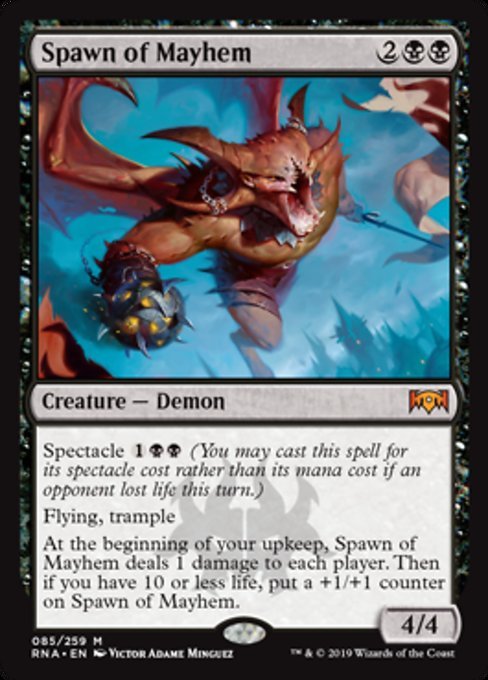
Spawn of Mayhem
AI Rating: 5Pro Rating: 4.0
This is great at 4 mana, and insane at 3 mana. It is going to enable you to win most races, so the fact that hurts both players doesn’t really matter, especially because it starts getting bigger too, making it even more unstoppable.
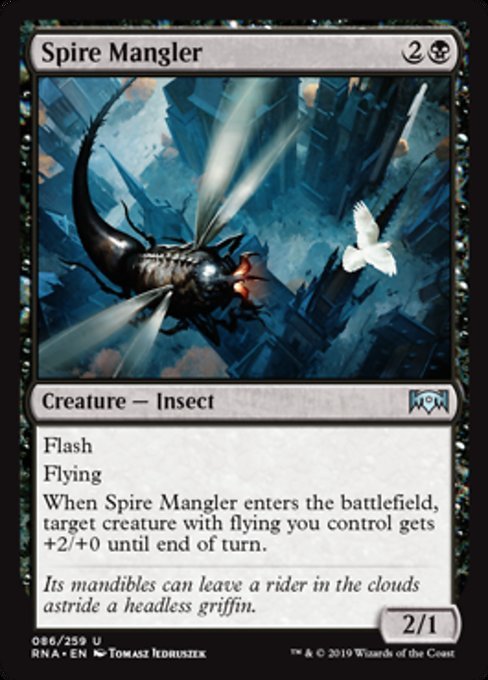
Spire Mangler
AI Rating: 3.4Pro Rating: 2.5
You know, this card looks like it would do a ton, but it is significantly less impressive than it looks. It is a solid card for sure, but you don’t often find a way to really leverage that +2/+0 into much additional value. First, restricting it to flyers really hurts. Mostly, it helps you chip in for more damage, or make a 1-for-1 trade. Keep in mind it can target itself, so if you want to flash it in to kill an attacking X/4, it can do that.
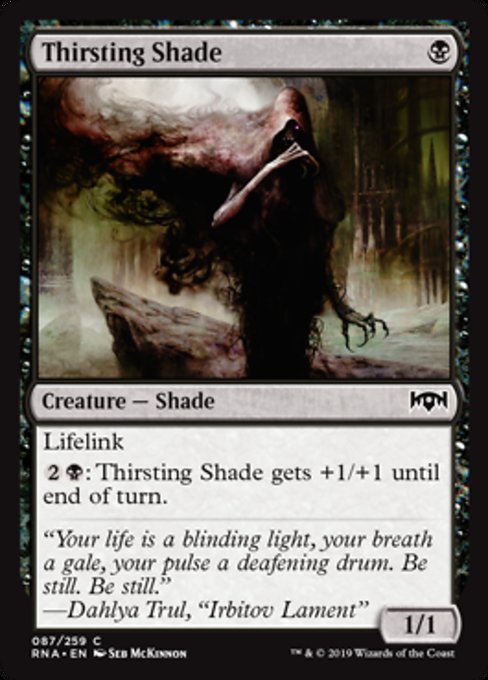
Thirsting Shade
AI Rating: 0.9Pro Rating: 1.5
This thing demands a ton of mana to be relevant, and it isn’t usually going to be worth it. It can pump itself, but on most boards it just isn’t able to attack.
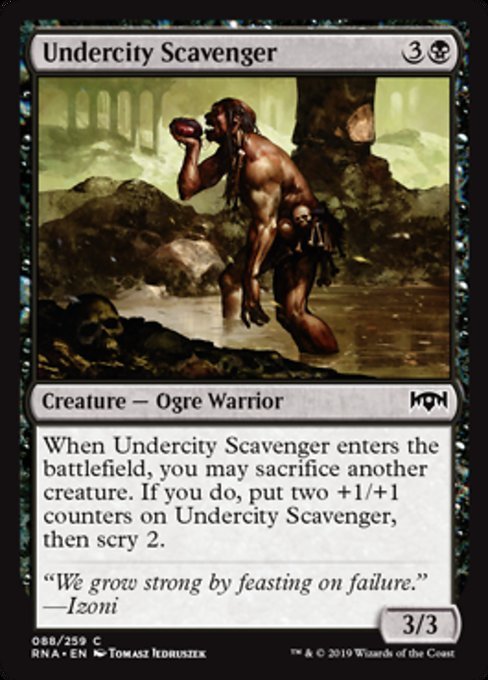
Undercity Scavenger
AI Rating: 2Pro Rating: 2.0
This is a decent sacrifice outlet, as you end up with a 4-mana 5/5 that improves your next couple of draws. It isn’t that impressive, though, and you often won’t really feel like making the sacrifice is worth it.
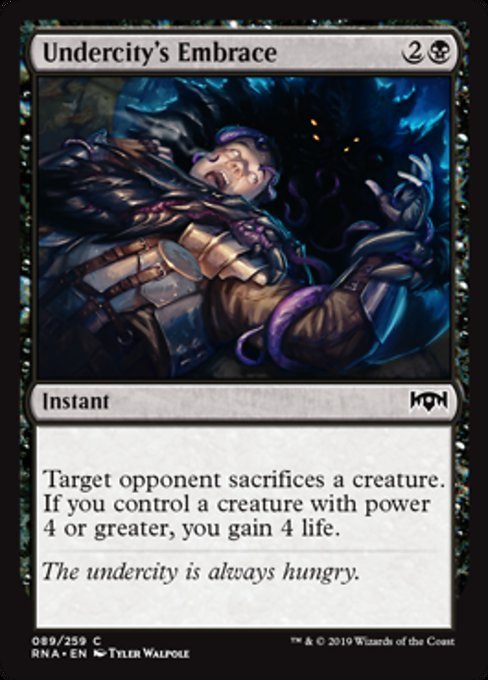
Undercity's Embrace
AI Rating: 1.5Pro Rating: 1.5
Edict effects are always pretty underwhelming in Limited, since board states tend to be pretty clogged up, especially in this format. If you really need removal, and have a decent number of creatures with 4 or more power, it is a decent card, but it is basically never more than that.
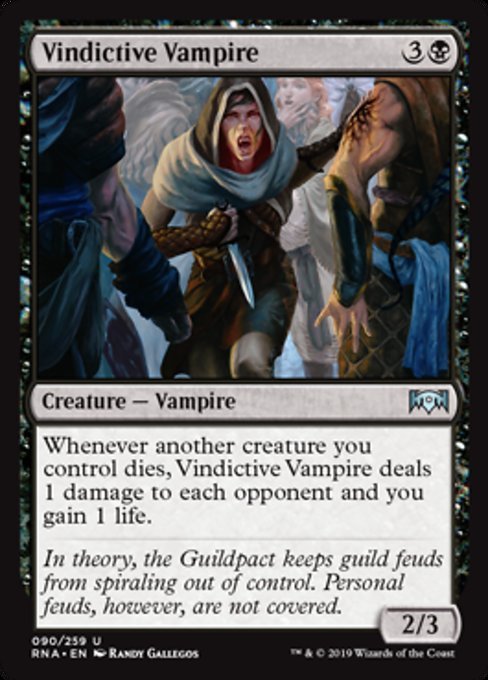
Vindictive Vampire
AI Rating: 3.6Pro Rating: 3.0
This trigger is always strong, as it just really alters combat math for your opponent. It gets even better in a deck with good ways to sacrifice creatures, and the Rakdos deck in this format has enough ways to do that this is pretty sweet.
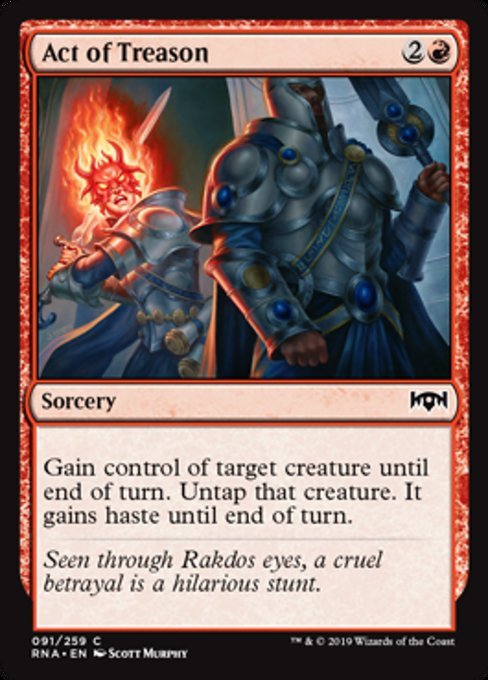
Act of Treason
AI Rating: 1.2Pro Rating: 1.0 // 3.0
As usually, if you’re in a deck with enough Sacrifice outlets, this is really sweet. Stealing an opposing creature, attacking them with it, and then sacrificing it is one of the sweetest feelings there is! But you are going to need to have a few different cards that allow you to cheaply sacrifice a creatures to make it worth it, and it isn’t something you really want in any other deck.
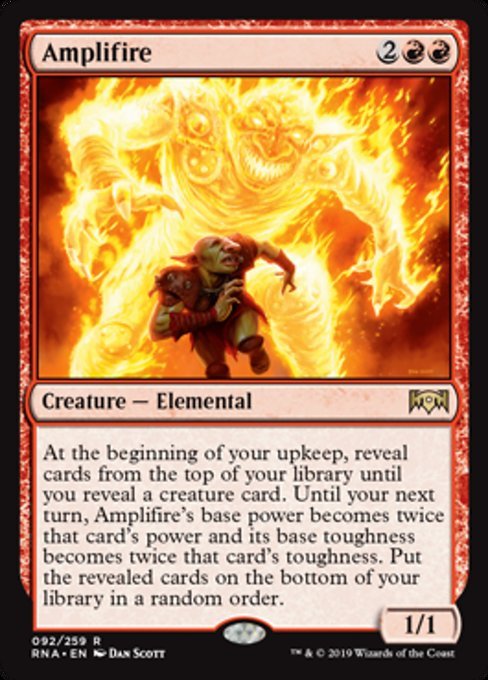
Amplifire
AI Rating: 4.2Pro Rating: 2.0
This thing has a big text box, but mostly this ends up being a pretty mediocre vanilla creature. Sometimes it will get pretty big, but a lack of any sort of evasion doesn’t make that a huge deal in a format with plenty of creature tokens. And the flip side is that sometimes it is really small – and there is always a window where it a very vulnerable 1/1.
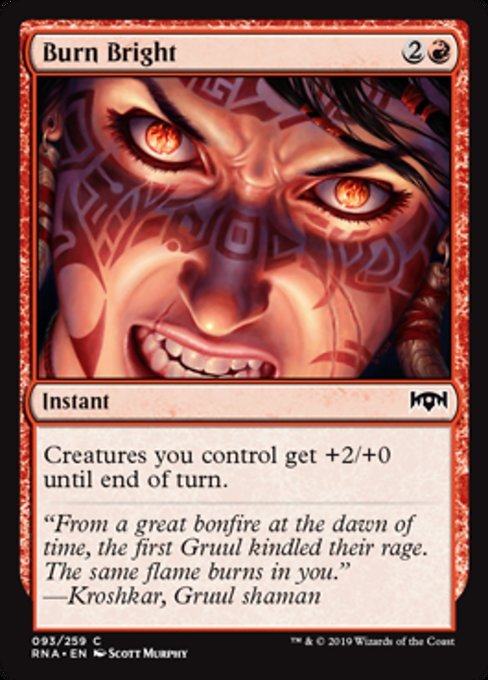
Burn Bright
AI Rating: 0.8Pro Rating: 1.0 // 2.0
If you’re really going wide, this isn’t a terrible inclusion, but only the most aggressive decks are going to be interested in this.
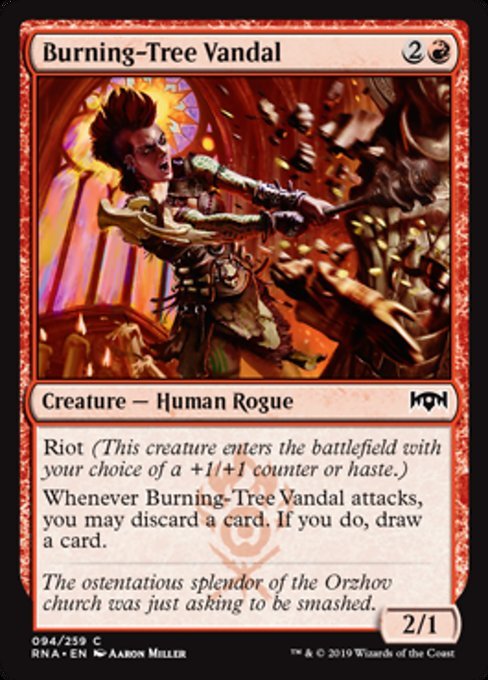
Burning-Tree Vandal
AI Rating: 2.3Pro Rating: 2.0
Rummaging when it attacks is fine, and because of Riot it can do it for you right away sometimes. The option of also making it a 3/2 is pretty sweet.
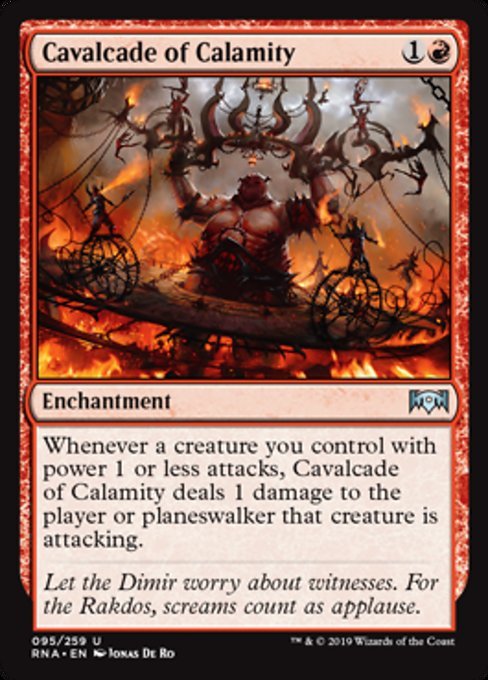
Cavalcade of Calamity
AI Rating: 1.8Pro Rating: 0.0
This card is very sweet, but it is very difficult to consistently build around it in Limited. You just won’t have enough small creatures.
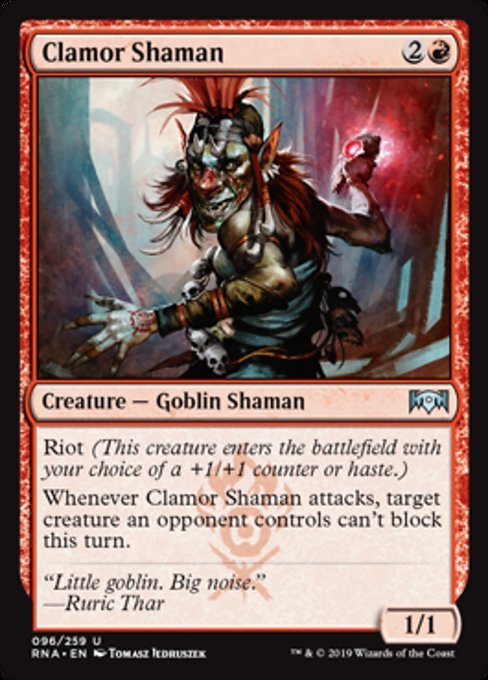
Clamor Shaman
AI Rating: 3.1Pro Rating: 3.5
This thing is incredible if you’re an aggro deck. As always, making something unable to block is a big deal, and can often really open the floodgates on your opponent. Because of Riot, the Shaman can swing right away, and really alter the race. If she can’t attack your opponent does get a window to kill her, but making her a 2/2 and swinging on the next turn still feels pretty good.
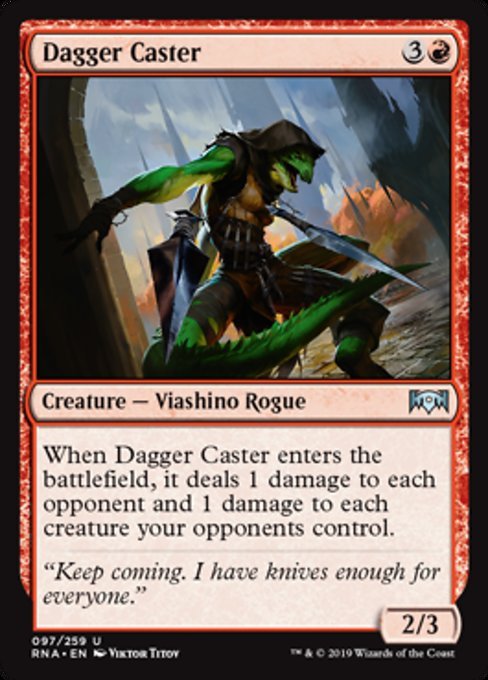
Dagger Caster
AI Rating: 3.7Pro Rating: 2.0
This can sometimes come down and kill some stuff, but most of the time it feels like it just pings the opponent for one damage. It is pretty sweet to combine with Bladebrand, though!
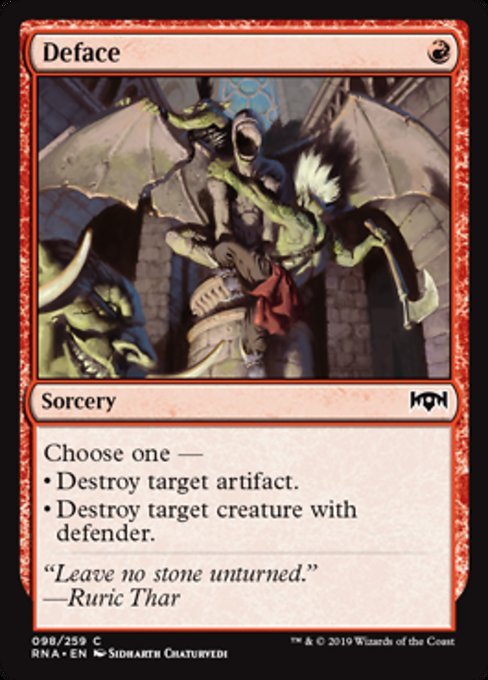
Deface
AI Rating: 0.3Pro Rating: 0.5
There aren’t enough artifacts or defenders in this format for this to be main deck material.
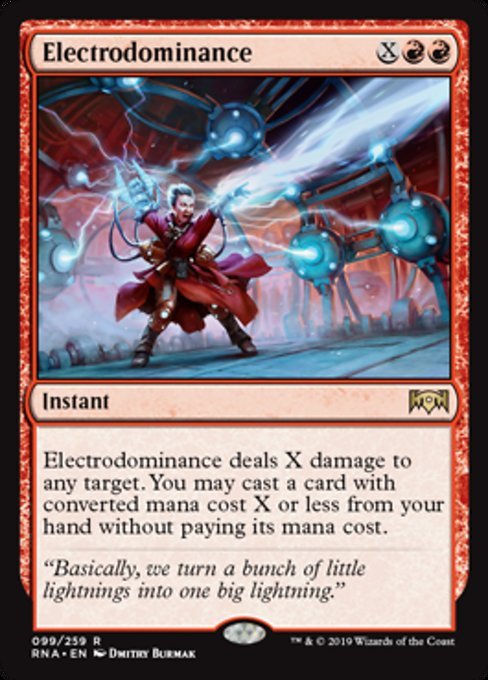
Electrodominance
AI Rating: 4.7Pro Rating: 3.5
So, when you kill something with this, it doesn’t feel very efficient, since you have to pay two Red in addition to X. However, the fact it can target anything – including players, does make it a pretty nice card. Especially because if you have a card in your hand with the right mana value, you can cast it from your hand! Now, that second part sounds really exciting, but most of the time by the time you want to be casting this, you aren’t going to be getting that much value out of that effect. Still, it is upside on a card that is already pretty reasonable, and it is nice that you can use this early to kill an X/2 and play a 2-drop.
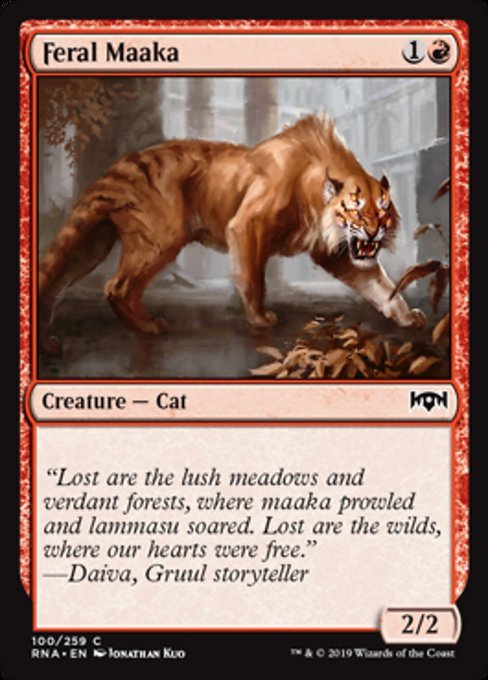
Feral Maaka
AI Rating: 0.9Pro Rating: 1.0
If you need a two drop well..that’s what this is, but you’ll only be playing this in an emergency.
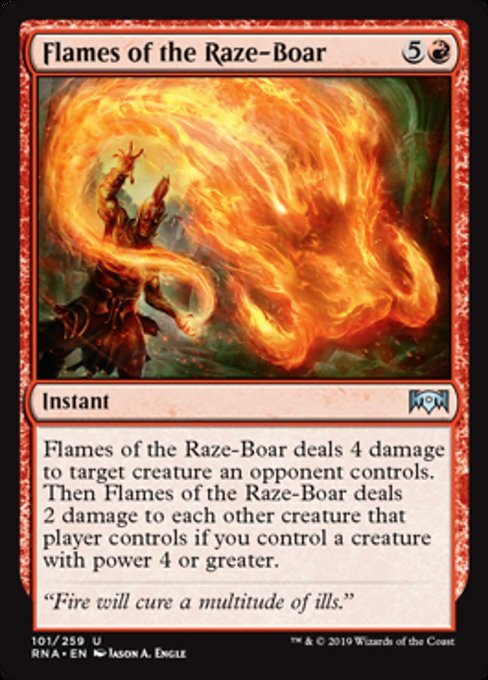
Flames of the Raze-Boar
AI Rating: 3.7Pro Rating: 3.0
6 mana to do 4 to a creature isn’t great, but if you have a 4+ power creature, this can turn into a pretty impressive sweeper, taking down multiple things! Its expensive, and the set up is real – but its upside is massive.
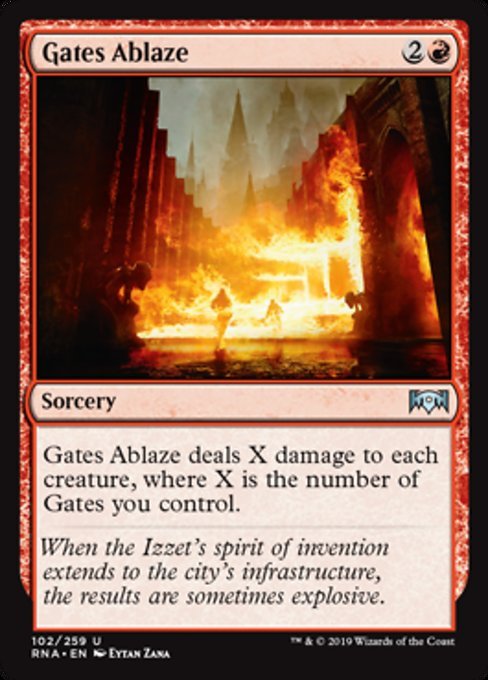
Gates Ablaze
AI Rating: 3.9Pro Rating: 1.0 // 3.5
Gate control decks are definitely a thing in this format, and this is a card that can enable them, since it can often sweep the board in the early game, allowing you to get to the point where you can cast your Archway Angels and the like.
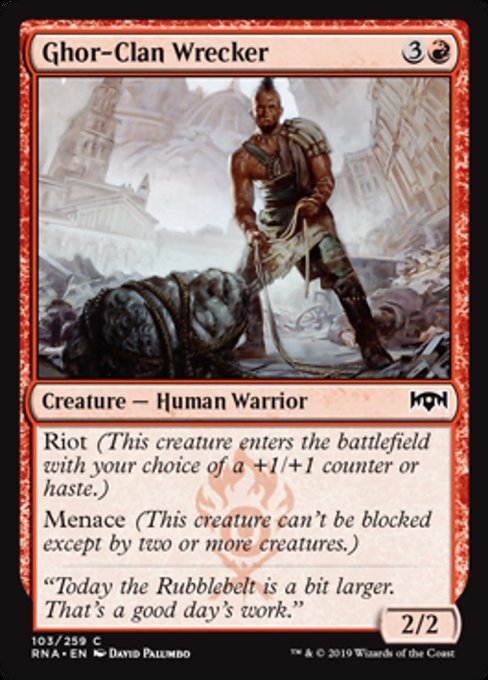
Ghor-Clan Wrecker
AI Rating: 1.5Pro Rating: 1.5
Neither option here is fairly appealing, but the flexibility isn’t too bad.
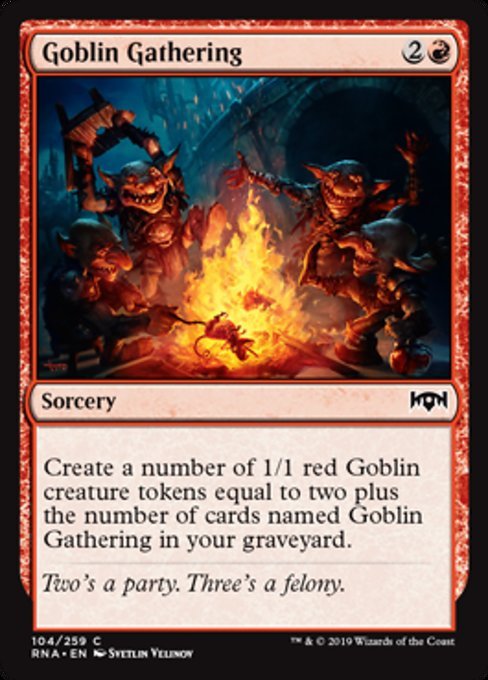
Goblin Gathering
AI Rating: 1.9Pro Rating: 1.0 // 3.0
If you just have one of these, it is playable – but just barely. Once you have multiples, though, it can be a pretty impressive way to go wide.
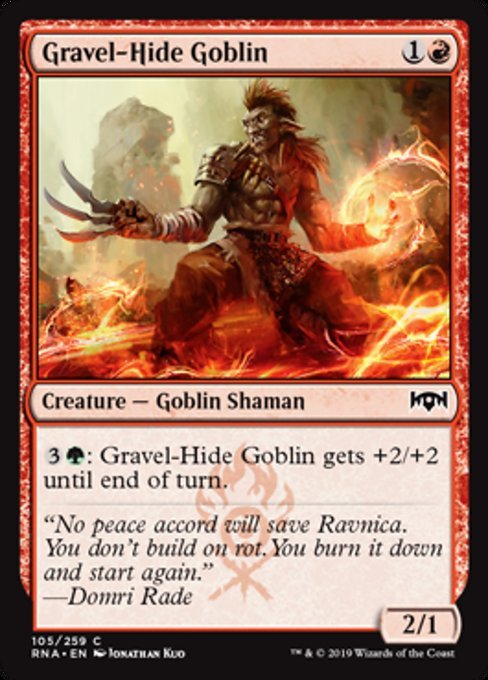
Gravel-Hide Goblin
AI Rating: 1.9Pro Rating: 2.5
This has decent starting stats and an ability that can allow it to attack pretty much all game long, even if the ability is a little costly.
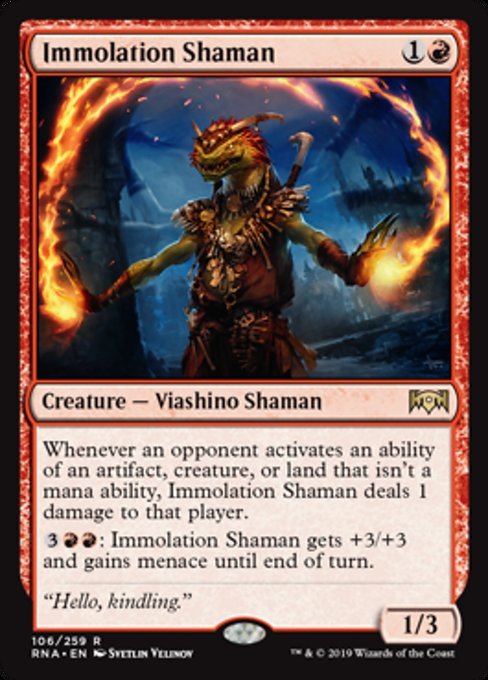
Immolation Shaman
AI Rating: 3.9Pro Rating: 3.0
This is a two mana 1/3 with some pretty nice upside. First, it punishes the opponent using activated abilities. That’s…not a huge deal, but it isn’t unusual for it to chip in 1-3 damage as a result. Its activated abilities is what really makes it interesting, because making it a 4/6 with Menace in the later part of the game is pretty nice.
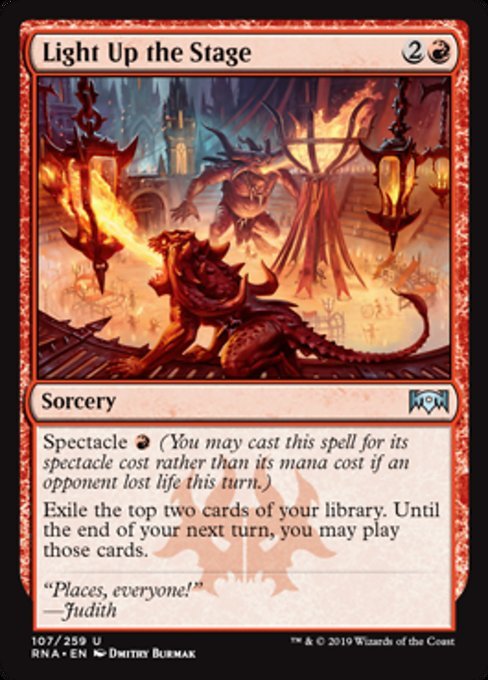
Light Up the Stage
AI Rating: 3.2Pro Rating: 3.5
This jus tends up feeling like a one mana Divination a huge chunk of the time, and even casting it for three isn’t a disaster. The card advantage it grants you is just great.
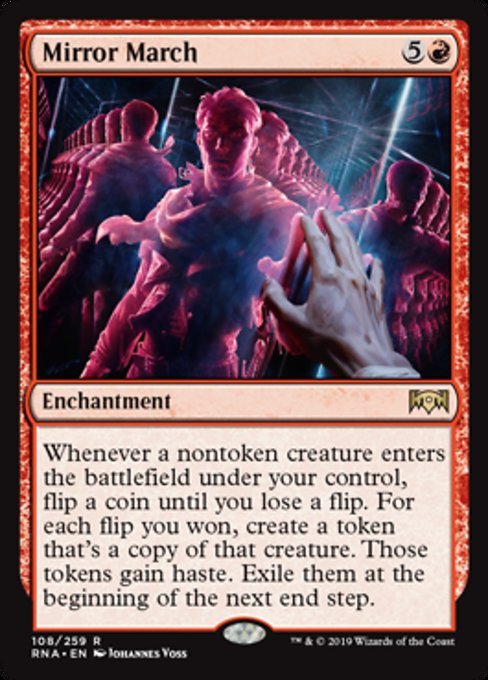
Mirror March
AI Rating: 2.9Pro Rating: 0.0
Yeah, you don’t want to put your games in the hands of a coin-flipping Enchantment that costs 6 mana and likely won’t do anything until you untap the next turn anyway.
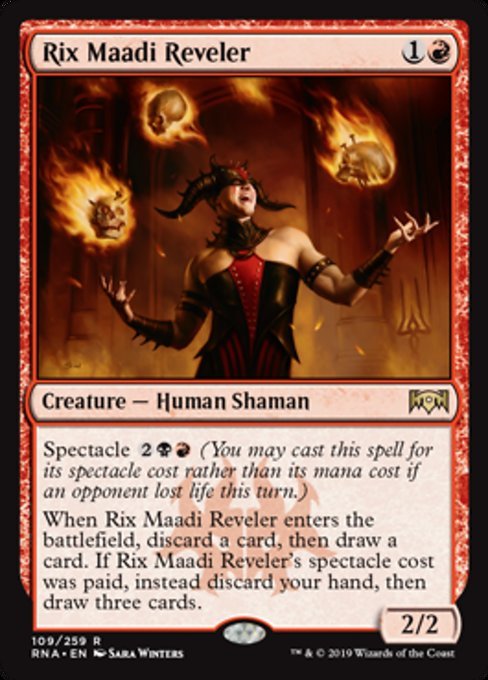
Rix Maadi Reveler
AI Rating: -0Pro Rating: 4.0
If this were just a two mana 2/2 that let you rummage when it entered the battlefield, you would pretty much always play that card – so the Spectacle upside here is massive. Sure, it becomes a 4-mana 2/2, but it also allows you to completely reload your hand with three cards. If you cast this for its Spectacle cost and effectively just draw 3 cards with it, you’re going to have a hard time winning the game.
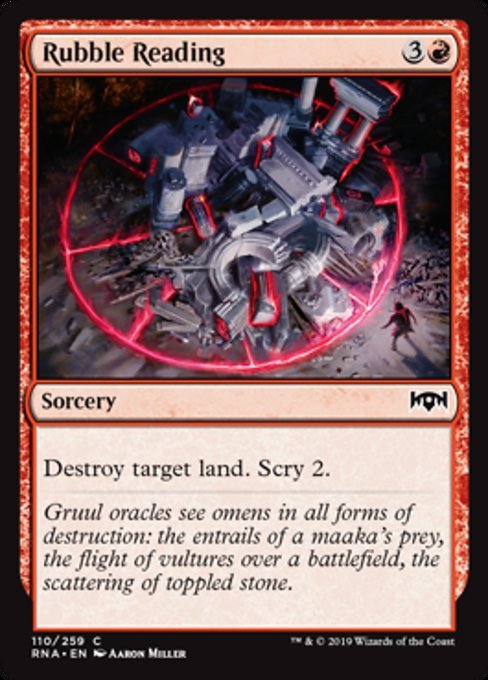
Rubble Reading
AI Rating: 0.5Pro Rating: 0.5
People play some ambitious mana bases in this format, but even then, this isn’t a great sideboard card.
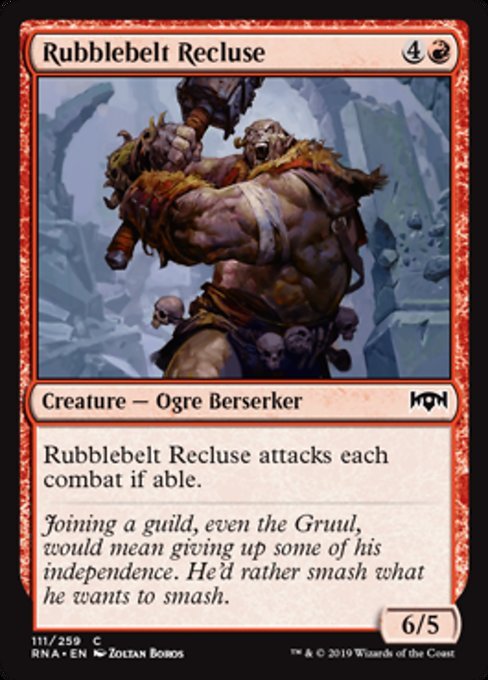
Rubblebelt Recluse
AI Rating: 2Pro Rating: 2.0
This is pretty big for the cost. And…well, yeah that’s pretty much all it has going for it! But that kind of size is a decent thing to have around in some decks.
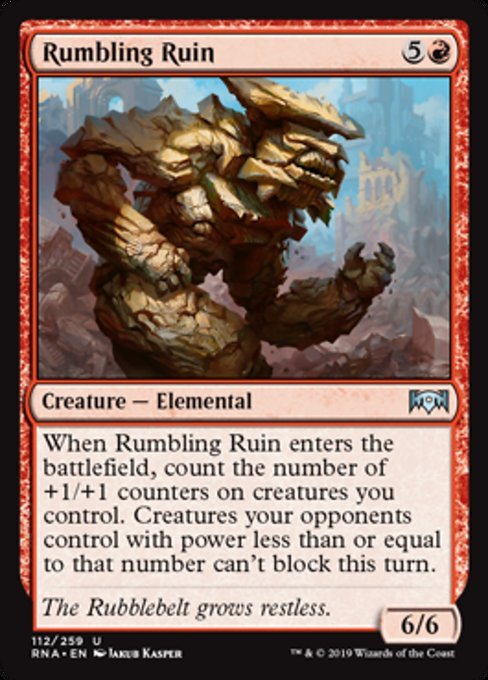
Rumbling Ruin
AI Rating: 2.8Pro Rating: 3.5
If you’re in Gruul, this 6-mana 6/6 can often come down and turn off a number of blockers, which will often allow your creatures who already in play to get in for some significant damage. It won’t always get to do its thing, but this has a floor of a vanilla 6-mana 6/6 and a very impressive ceiling.
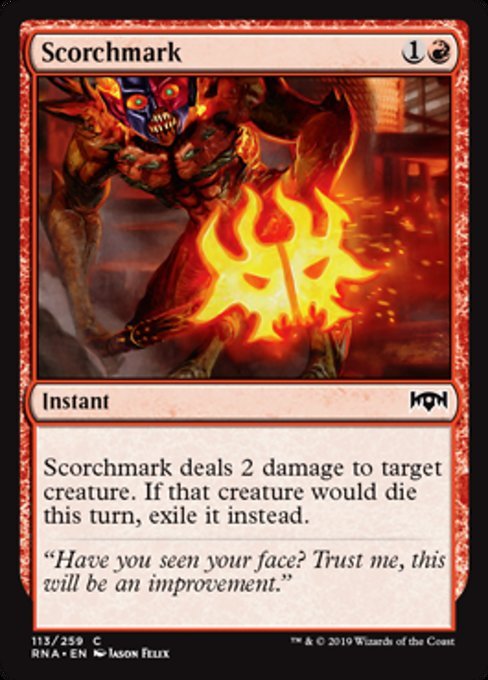
Scorchmark
AI Rating: 2.9Pro Rating: 2.5
Two mana for two damage at instant speed isn’t quite premium removal – but it is solid -- and the fact that this can exile stuff does come up sometimes.
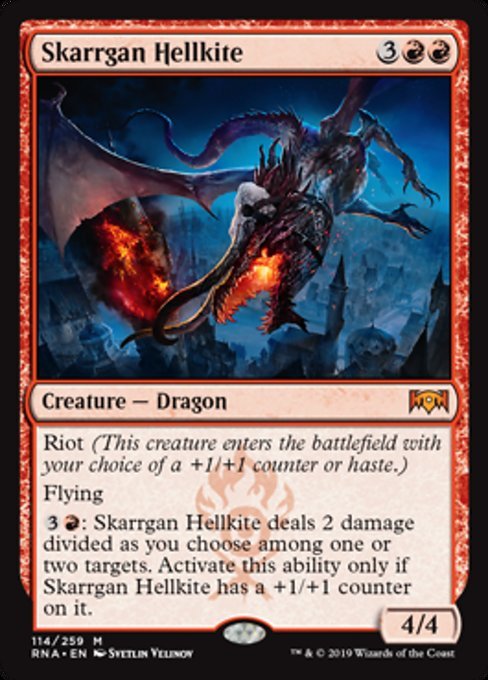
Skarrgan Hellkite
AI Rating: 4.4Pro Rating: 5.0
This is obviously a bomb. Whichever option you choose, you’re getting an impressive creature. If you’re wanting to play a long game, going with the +1/+1 counter is best, since you can use its ability to really decimate the opposing board, but if you’re looking to win within a turn or two, then going with Haste is the better option.
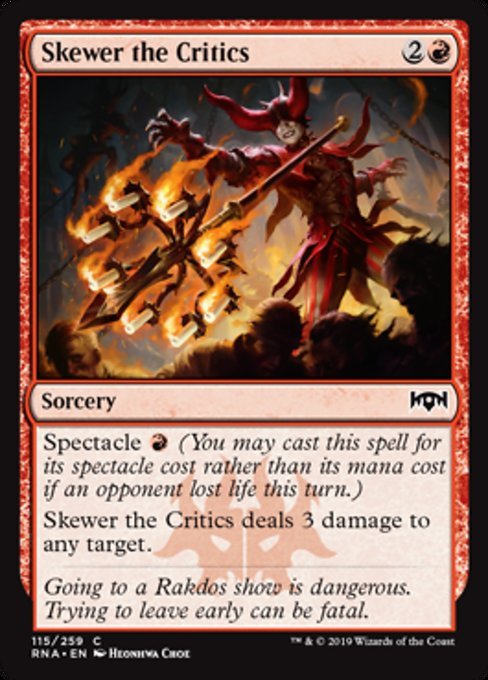
Skewer the Critics
AI Rating: 3.7Pro Rating: 4.0
This is often just one Red mana for a Sorcery-speed Lightning Bolt, and that’s amazing. Even if you could only ever pay 3 for this card, it would be premium removal, so the upside of only costing one Red really makes it an excellent card, and one of the best Commons in the set.
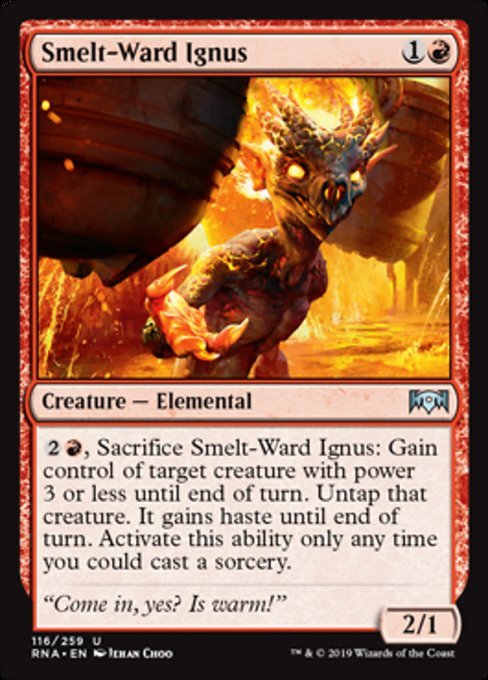
Smelt-Ward Ignus
AI Rating: 2.3Pro Rating: 1.5
This has mediocre stats and an ability that is just way too costly and narrow. But, it isn’t a complete disaster if you have to play it.
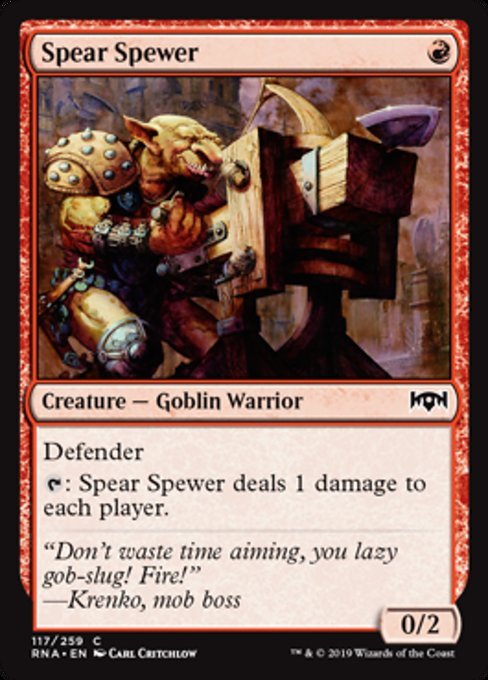
Spear Spewer
AI Rating: 1.5Pro Rating: 1.5
The idea here is that this can set up your cards that have Spectacle. And, it can do that for sure, but its body is otherwise a pretty big liability, and the Rakdos decks don’t have that hard of a time of making sure Spectacle is online anyway. If your deck is really leading hard into the mechanic, Spear Spewer is a worthy inclusion, but it is by no means a necessity for those types of decks.
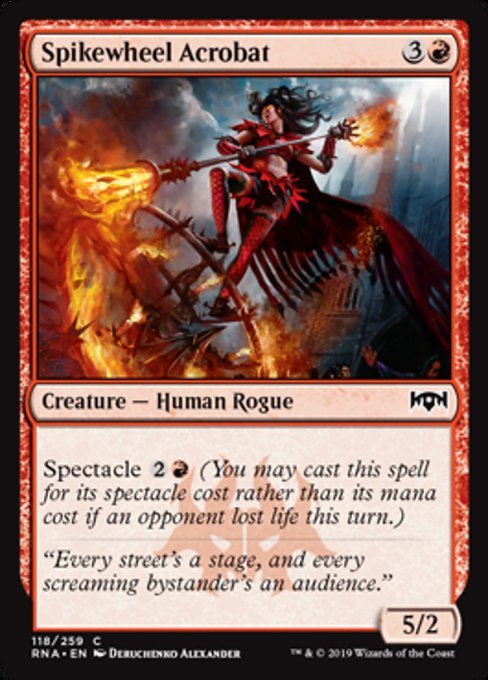
Spikewheel Acrobat
AI Rating: 1.3Pro Rating: 1.5
The idea here is that this can set up your cards that have Spectacle. And, it can do that for sure, but its body is otherwise a pretty big liability, and the Rakdos decks don’t have that hard of a time of making sure Spectacle is online anyway. If your deck is really leading hard into the mechanic, Spear Spewer is a worthy inclusion, but it is by no means a necessity for those types of decks. 118 - Spikewheel Acrobat – 1.5 This really only feels worth it if you get the Spectacle going, and even then it isn’t exactly amazing, as most 2 drops in the set can still trade for it.
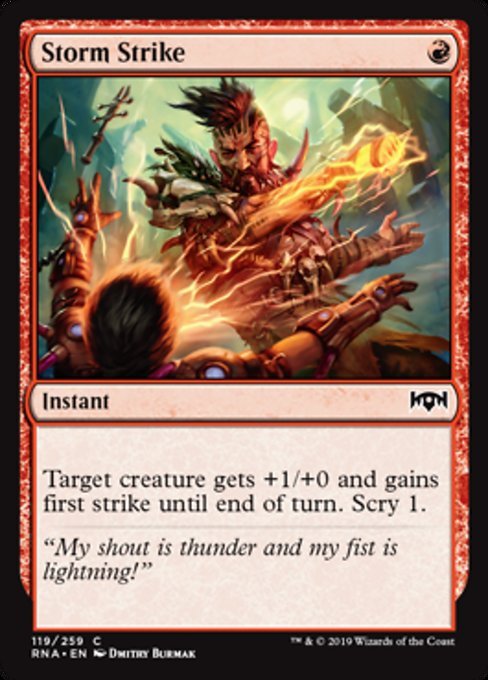
Storm Strike
AI Rating: 1Pro Rating: 1.5
This is a decent trick if you’re in the market. +1/+0 and First Strike always plays pretty well in terms of helping a creature win combat, and its nice to have Scry 1 tacked on.
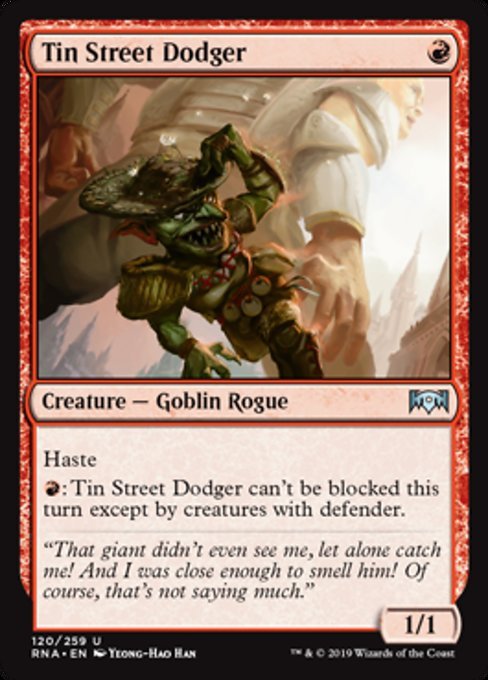
Tin Street Dodger
AI Rating: 2Pro Rating: 2.5
This is a decent creature for a few reasons. First, if you’re in Rakdos, it is a good spectacle enabler. Second, if you’re in Gruul, it’s a nice play to put +1/+1 counters because it is usually unblockable. It is a nice enabler/payoff for each of those decks.
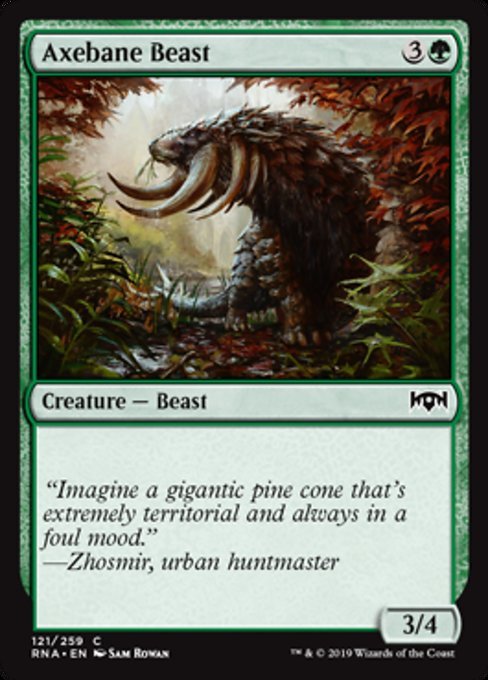
Axebane Beast
AI Rating: 1Pro Rating: 1.5
This has sort of passable stats. If you need a reasonably efficient medium-sized body, this is it.
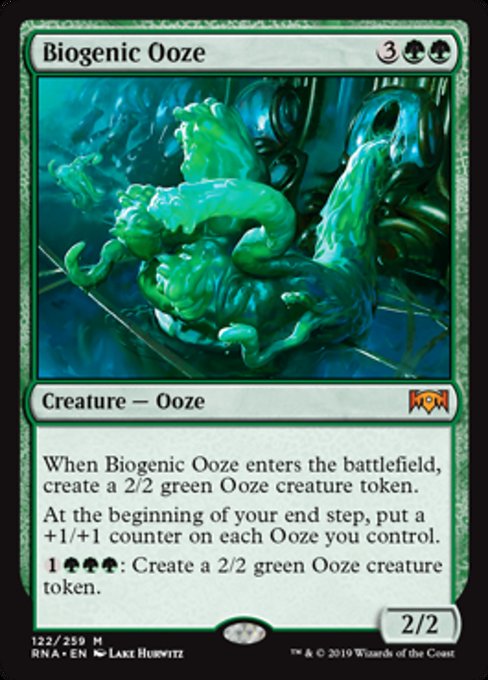
Biogenic Ooze
AI Rating: 5Pro Rating: 5.0
This is a great bomb. If it is allowed to come in play and is left unchecked, It will quickly populate the board with massive Oozes. What really makes it nice, though, is that no matter what you’re going to get at least some value out of it. Even if your opponent kills it right away, you’re going to have a single 2/2 Ooze – which usually means you’re looking at a 2-for-1. So, the floor here is that this is a nice 2-for-1, and the ceiling is that it wins you the game.
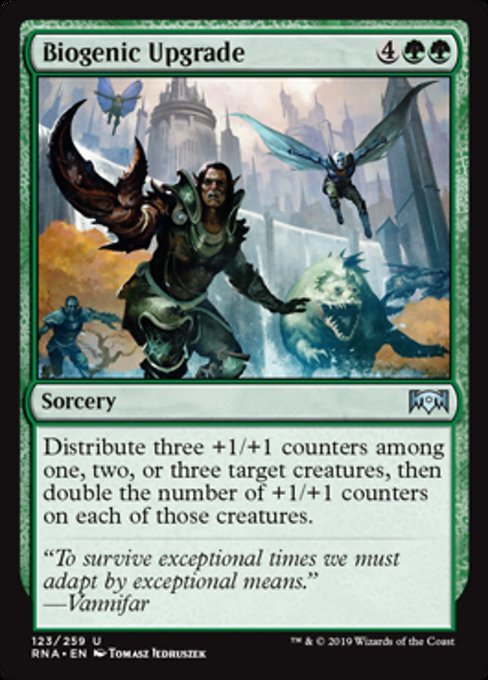
Biogenic Upgrade
AI Rating: 3Pro Rating: 2.5
This can really help you close out a game, and is even pretty nice at just upgrading your board. And that’s a big deal, because if it was only good at winning you the game the turn you cast it, it would be far too narrow. Having a single copy of this at the top of your curve in both Gruul and Simic decks is pretty solid, though you don’t want to have more than that.
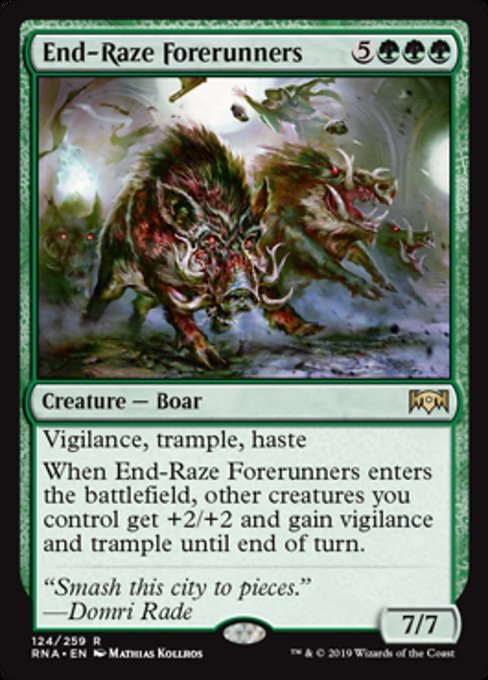
End-Raze Forerunners
AI Rating: 4.8Pro Rating: 2.0
This is sweet, but there isn’t really quite enough ramp in this format to reliably cast it. If you do end up with a deck that is good at making mana though, this is as good as it gets in this format.
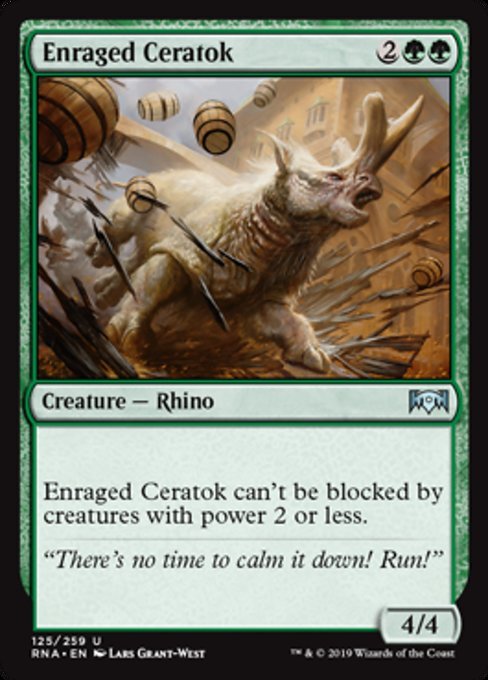
Enraged Ceratok
AI Rating: 4Pro Rating: 3.5
This has really nice stats and is surprisingly difficult to block easily.
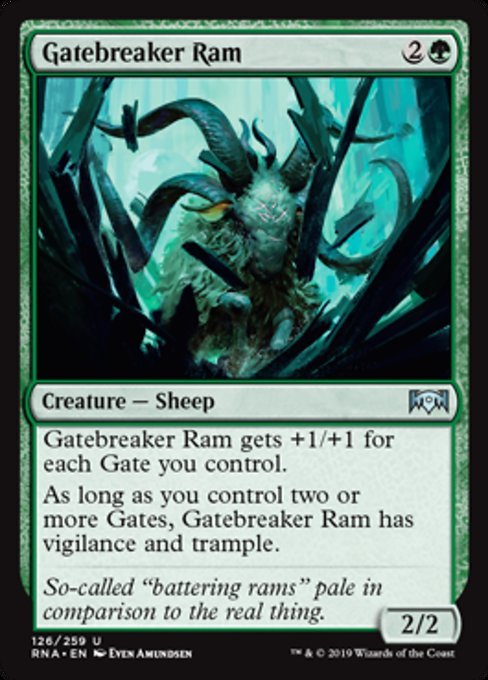
Gatebreaker Ram
AI Rating: 3.4Pro Rating: 1.5 // 4.0
This is one of the premier Gate payoffs in the format. If you end up with a critical mass of Gates, it will regularly be massive, evasive, and good at both attacking and blocking. Even if your deck has only 5 or so gates, it is a reasonable inclusion. While it is definitely a build around, it is a strong enough one that it is worth taking very highly.
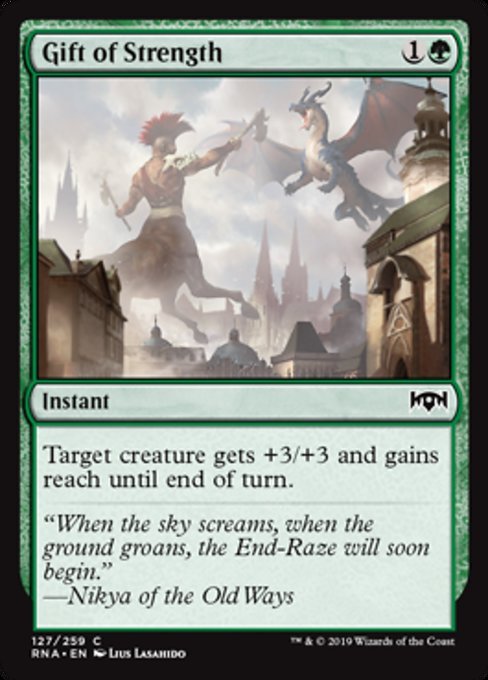
Gift of Strength
AI Rating: 1.3Pro Rating: 1.5
This trick is always fine. It allows a creature to win combat, but like all tricks it is a bit too situational.
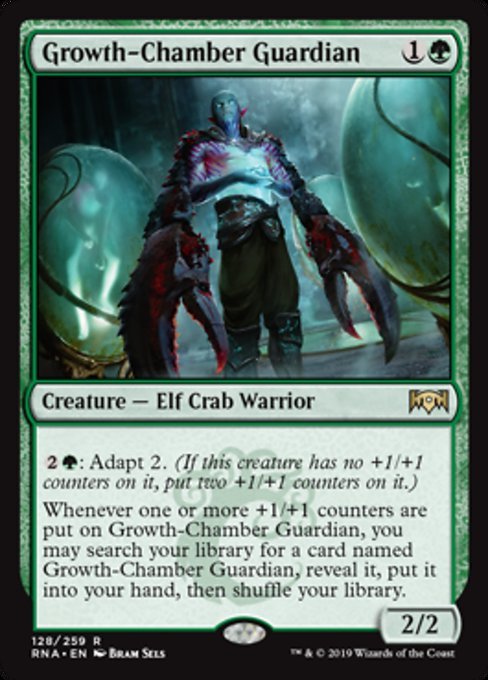
Growth-Chamber Guardian
AI Rating: 4.4Pro Rating: 3.0
You probably won’t have a second Growth-Chamber Guardian, but that’s okay, because a two mana 2/2 that can become a 4/4 later on in the game is a good Limited card anyway! If you do have more than one, it gets really silly.
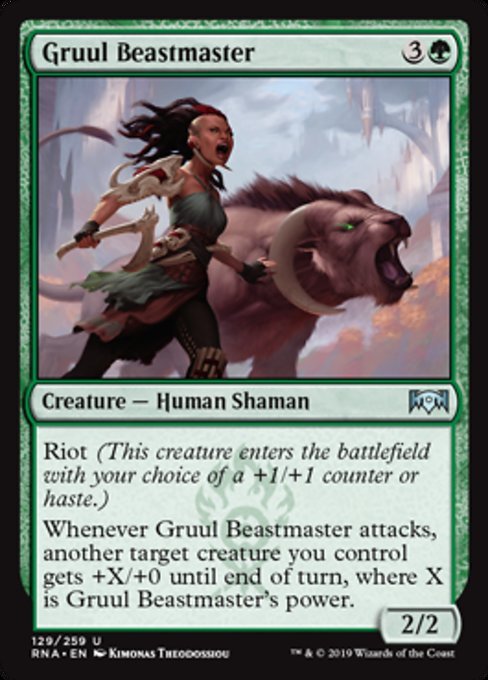
Gruul Beastmaster
AI Rating: 3.2Pro Rating: 2.5
This can add a bunch of damage to the board out of nowhere if you choose Haste. And, that’s what you’ll be choosing when your opponent’s shields are down. If your opponent is able to block more effectively, you can just go with the counter, and wait until your next turn to attack. Both occurrences are solid.

Guardian Project
AI Rating: 4.9Pro Rating: 3.5
Any time you play a 4-mana Enchantment that doesn’t do anything right away, you’re putting yourself behind the 8-ball, but this is a powerful card-drawing engine that really makes it worth it. Your deck does need a lot of creatures, and ideally not too many that are duplicates, so that this effectively makes a huge chunk of your deck into 2-for-1s. The downside of having to wait is real, but the card advantage this can grant you is worth it.
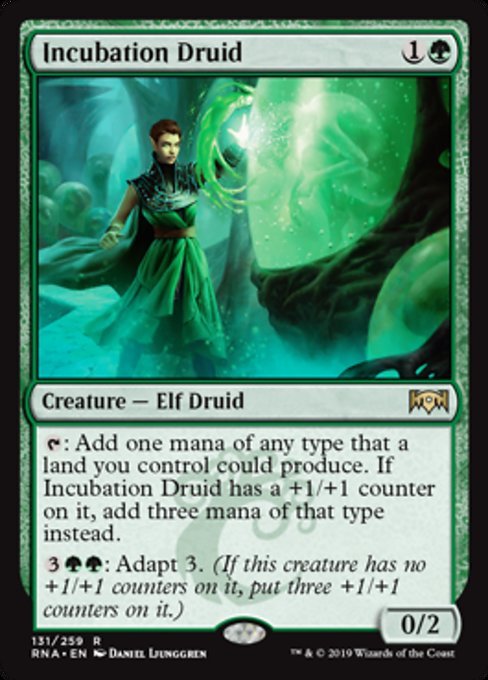
Incubation Druid
AI Rating: 4.9Pro Rating: 3.5
Even without Adapt, you’d be all over playing this card. Its just a great mana dork, especially for Limited! So, the fact that in the late game, you can make it bigger – and capable of producing more mana – is pretty great.
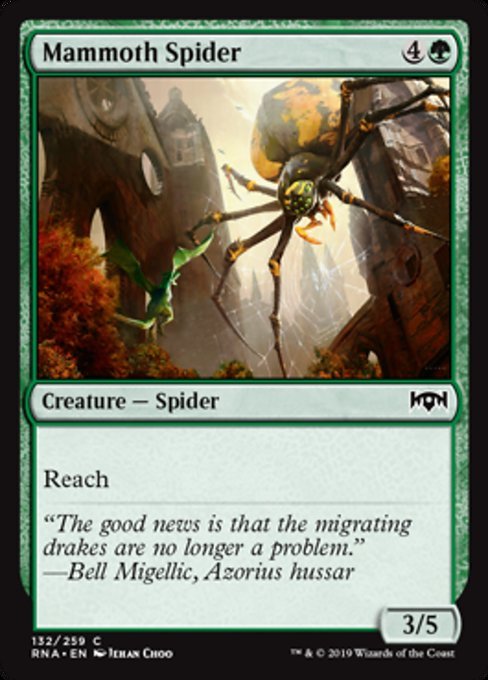
Mammoth Spider
AI Rating: 1.7Pro Rating: 2.0
This is a nice defensive creature if you’re in the market for one, and Green really does have a hard time with Flyers in this set, so having one of these around isn’t too bad.

Open the Gates
AI Rating: 1.9Pro Rating: 2.5
This can be some pretty nice fixing if you’re in the market for that, and you often are in this format because the mana – and the Gate decks – are so good.
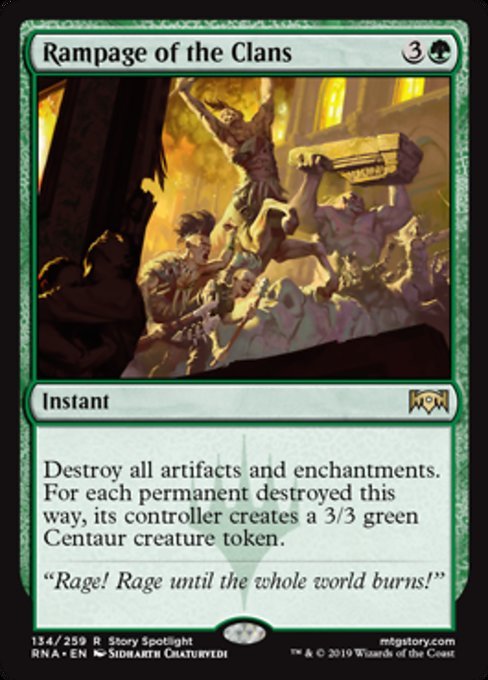
Rampage of the Clans
AI Rating: 2.4Pro Rating: 0.0
This is the kind of card that was designed with EDH in mind. It isn’t here for Limited players. You have way too little control over what this ends up doing.
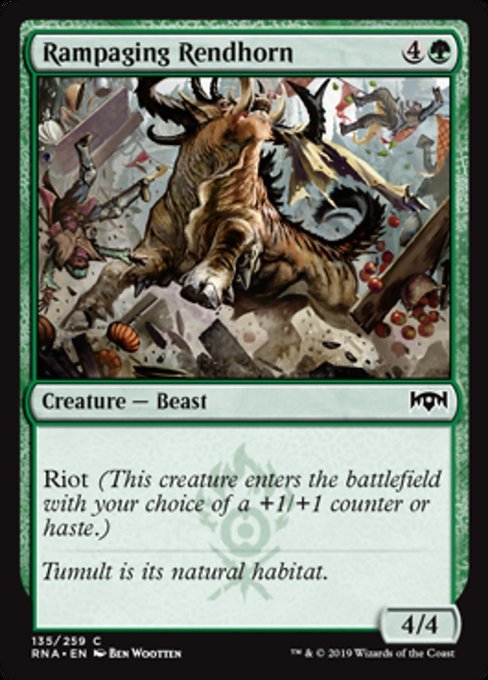
Rampaging Rendhorn
AI Rating: 2.6Pro Rating: 2.5
This is a solid 5-drop with two pretty decent options. You know, like most Riot creatures.
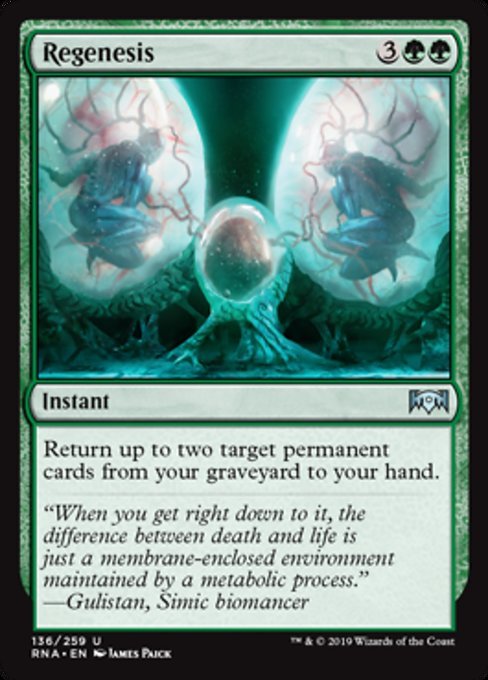
Regenesis
AI Rating: 1.3Pro Rating: 1.5
Getting two things back from your graveyard can be nice, but 5 mana is a big cost to pay, even at Instant speed.
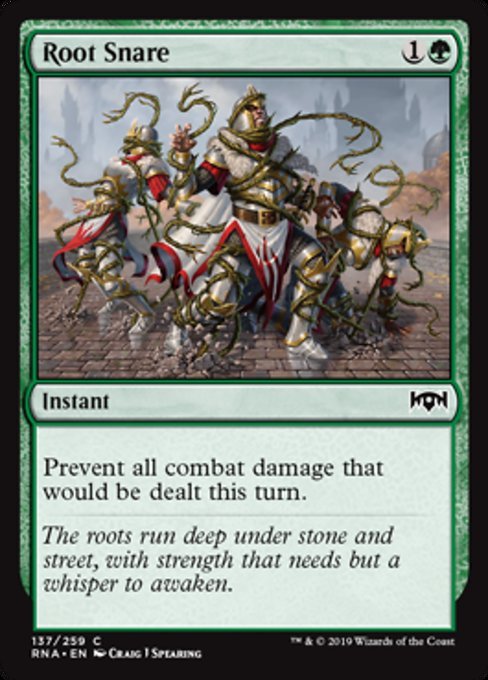
Root Snare
AI Rating: 0.2Pro Rating: 0.0
As usual, fogs are bad in Limited.
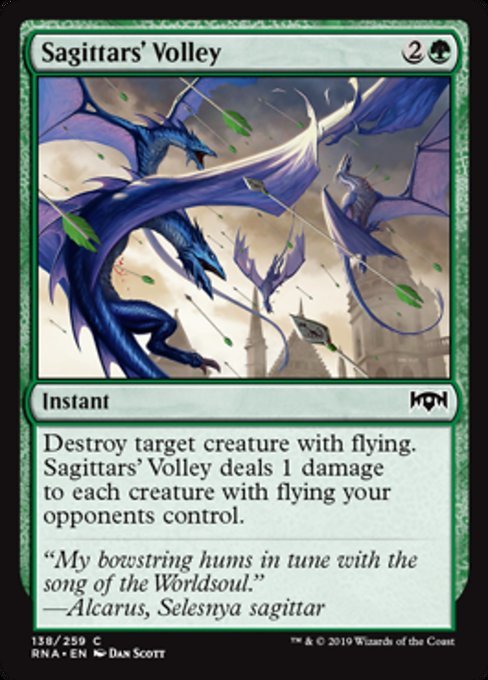
Sagittars' Volley
AI Rating: 0.8Pro Rating: 0.5
This is a solid sideboard card, but there aren’t really enough flyers to justify sticking this in your main deck.
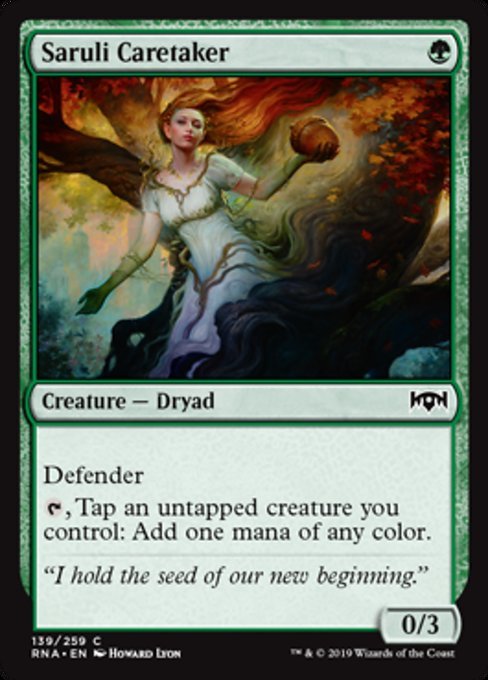
Saruli Caretaker
AI Rating: 1.3Pro Rating: 1.5
The cost of tapping both the Caretaker and another creature for mana ends up being pretty real, but if you are interested in fixing and ramp, this can certainly do it.
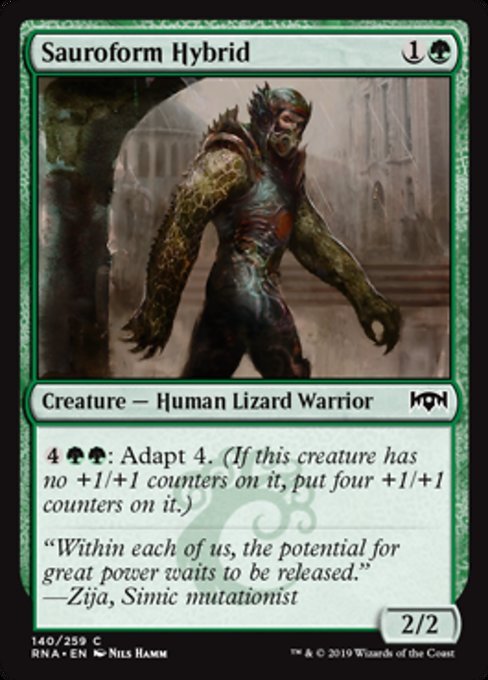
Sauroform Hybrid
AI Rating: 3.7Pro Rating: 3.5
This is one of Green’s best Commons. It starts out as a 2-mana 2/2, and then in the late game it can become a formidable 6/6 that gets all kinds of +1/+1 countery payoffs.
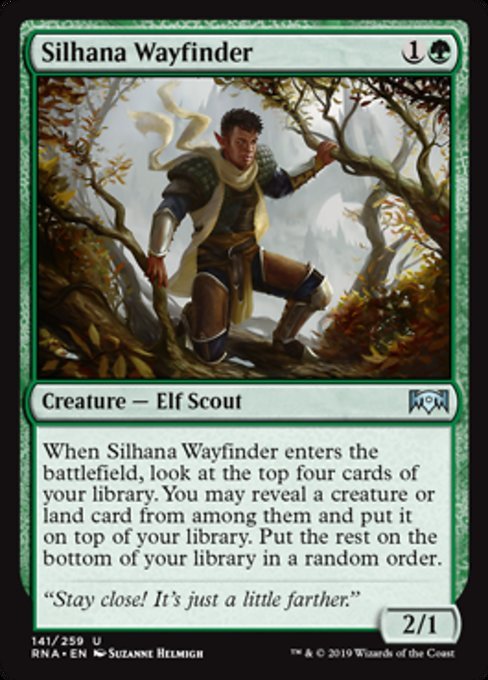
Silhana Wayfinder
AI Rating: 3.2Pro Rating: 2.0
This just give you some card selection. And, that’s nice – but it is something people tend to overrate. The difference between drawing a card and putting one on top of your library is massive. This is a fine card, but don’t overrate it.
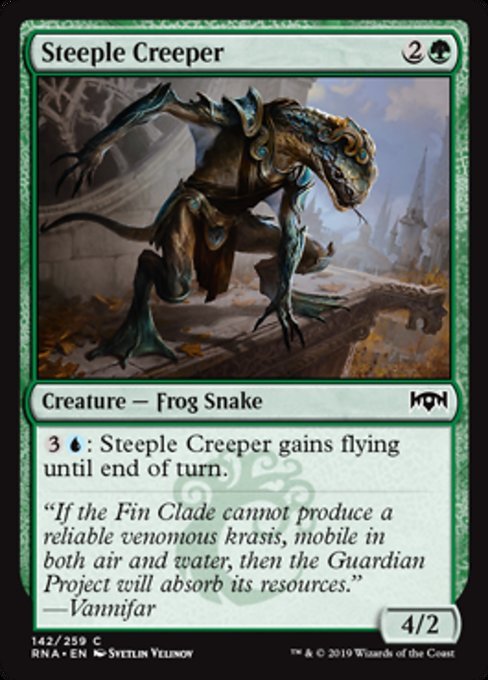
Steeple Creeper
AI Rating: 2.2Pro Rating: 2.5
This might be the best of this cycle of Commons. A 3-mana 4/2 is already almost passable, so the ability to gain flying in the mid-to-late game is pretty nice.
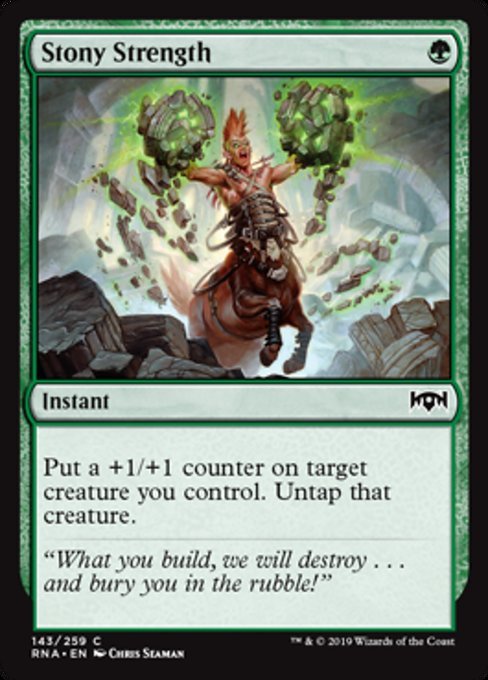
Stony Strength
AI Rating: 1.4Pro Rating: 1.5
This kind of trick is almost never worth it. That’s even true in a set with some +1/+1 counter stuff going on. The stats boost isn’t enough, even if it is permanent.
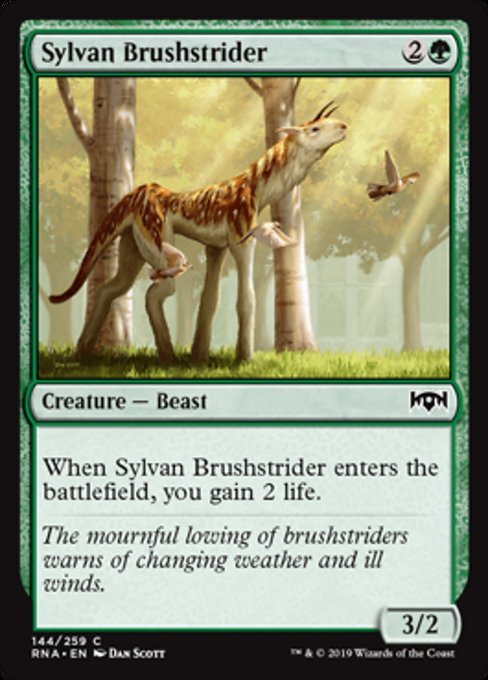
Sylvan Brushstrider
AI Rating: 1.3Pro Rating: 2.0
This is an alright 3-drop. The stats are pretty mediocre, but the 2 life helps off-set that a little bit.
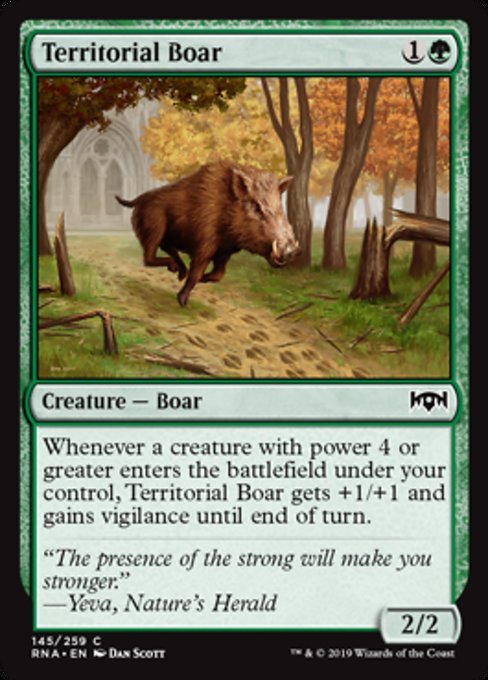
Territorial Boar
AI Rating: 2.1Pro Rating: 3.0
This ends up attacking as a 3/3 with Vigilance pretty often, and while that’s not the kind of size that is relevant all game long, it end sup being able to attack effectively for quite a while in most decks.
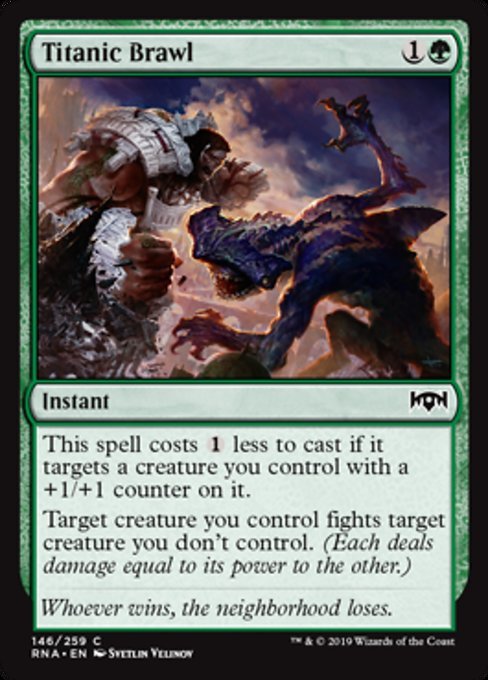
Titanic Brawl
AI Rating: 2.7Pro Rating: 3.5
Your creature doesn’t get any sort of boost out of Titanic Brawl, but the fact that you can play this for only a single Green is pretty nice – especially because both Simic and Gruul are so into +1/+1 counters that already increase the size of your creatures anyway.
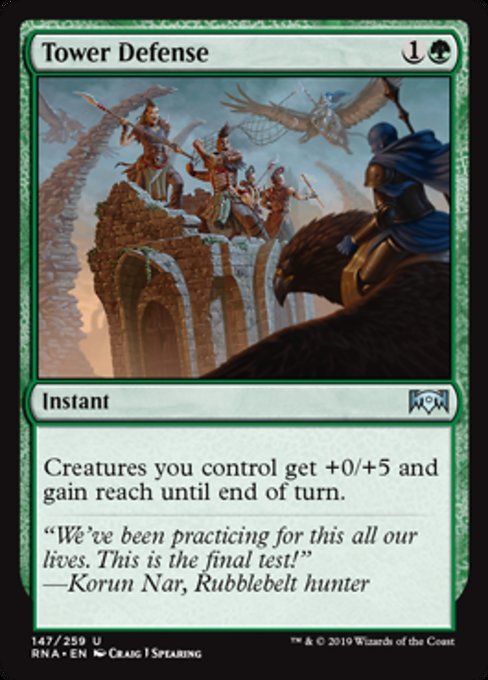
Tower Defense
AI Rating: 1.4Pro Rating: 0.0
This is mostly just a really fancy version of Fog, something that is just never worth it in Limited. You don’t want to go down a card just to buy yourself a single turn in this format.
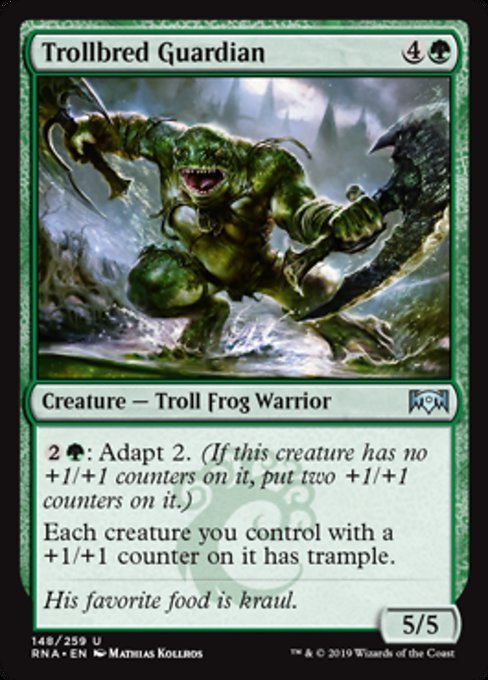
Trollbred Guardian
AI Rating: 4.2Pro Rating: 4.0
This thing is a monster. It starts out with good stats, and then gets bigger and gains Trample – while also granting trample to a significant portion of your board. It is an excellent Uncommon for all Green decks.
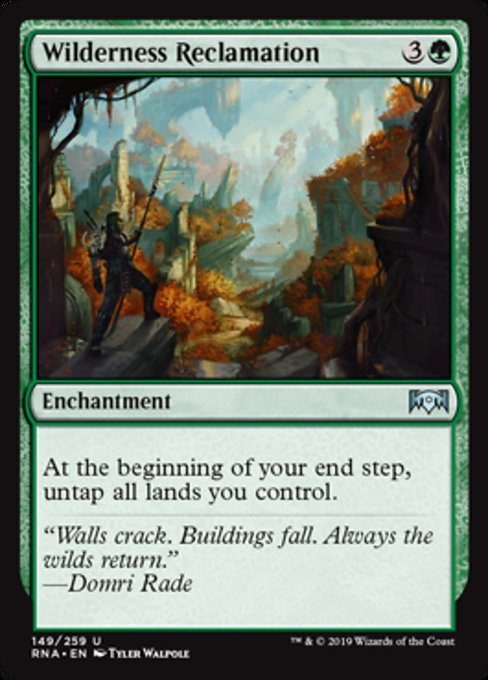
Wilderness Reclamation
AI Rating: 1.5Pro Rating: 0.0
This was a famously powerful card in constructed – in Limited, it is pretty much unplayable. You just won’t have anything to do with all the mana it gives you, even in a format with Adapt. Basically, you end up going down a card for no effect at all if you play this.
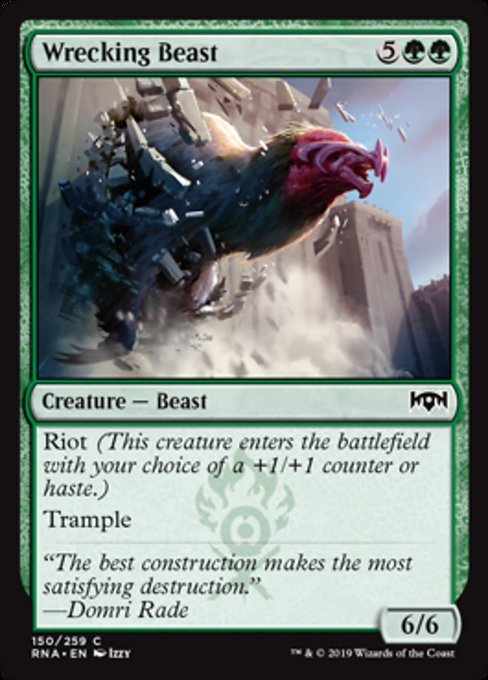
Wrecking Beast
AI Rating: 2.1Pro Rating: 2.0
This is some fine top-curve to have in both Simic and Gruul decks. It hits hard whichever option you choose.
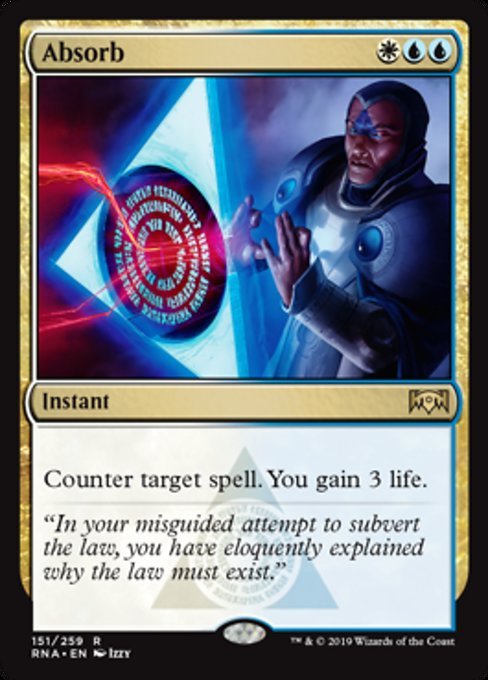
Absorb
AI Rating: 2.3Pro Rating: 2.0
Three mana counterspells don’t tend to be great in Limited, and while it is nice this give you some life, it is also pretty challenging to cast. And sure, you’ll get the mana for it eventually, but you want to be able to cast this as soon as possible in most cases, and that just won’t happen.
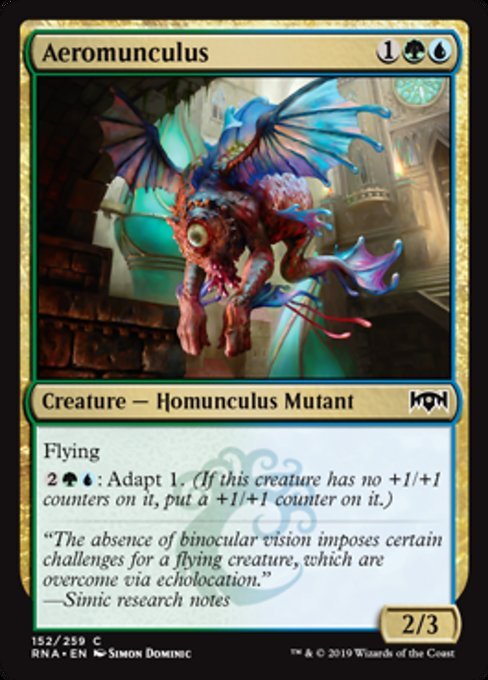
Aeromunculus
AI Rating: 3.7Pro Rating: 3.5
This starts with solid stats, so the fact that the amplify ability only grants a single counter isn’t a big deal. It has a great baseline and comes with the upside of getting bigger later in the game.
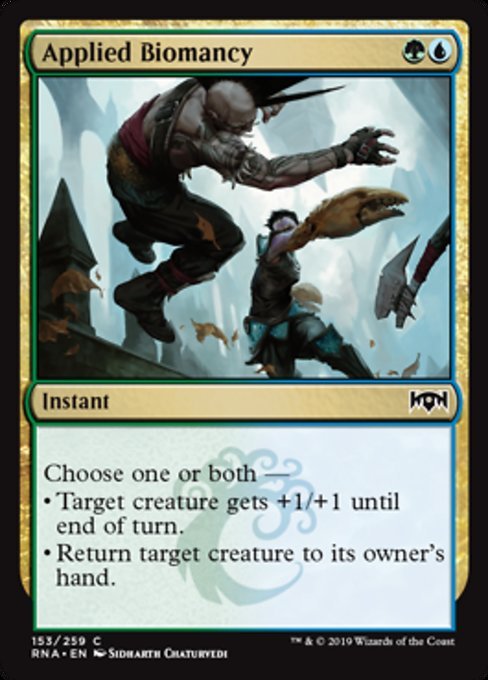
Applied Biomancy
AI Rating: 2.6Pro Rating: 2.5
This can generate some serious blowouts on occasions when both options are useful, and on most boards it is at least capable of doing something for you.
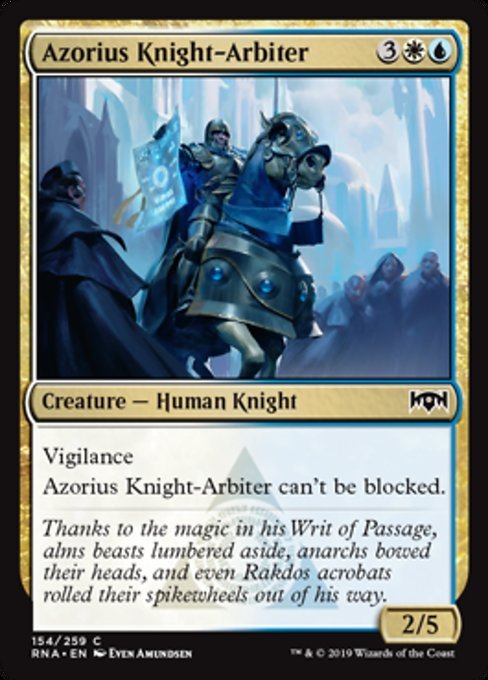
Azorius Knight-Arbiter
AI Rating: 3.3Pro Rating: 2.5
This isn’t a bad win condition for Azorius control decks in this format. It is an excellent blocker that can give you inevitability while chipping away at the opponent’s life total.
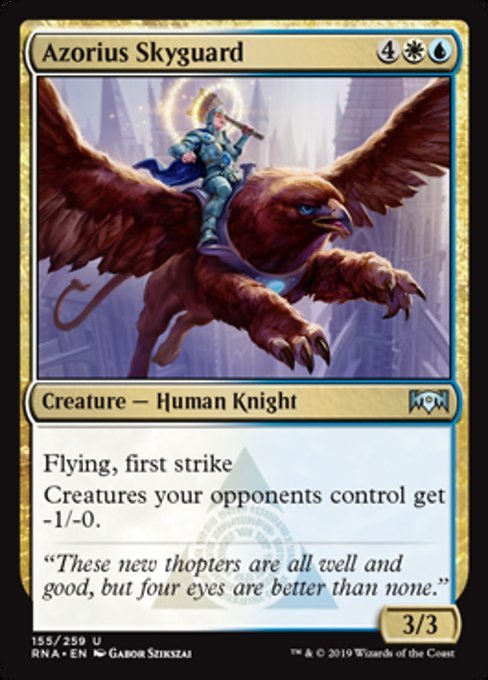
Azorius Skyguard
AI Rating: 3.6Pro Rating: 3.0
This has mediocre stats for the cost, even with First Strike in the mix, but its ability does have an immediate impact on the board, sometimes even making your attacks better, and usually making it harder for your opponent to attack you on their turn. There is one pretty big downside here, though – the Skyguard dies to a whole lot of very cheap removal in the format. Its not uncommon to pay 6 for this and have it blanked by something that costs 3 or less.
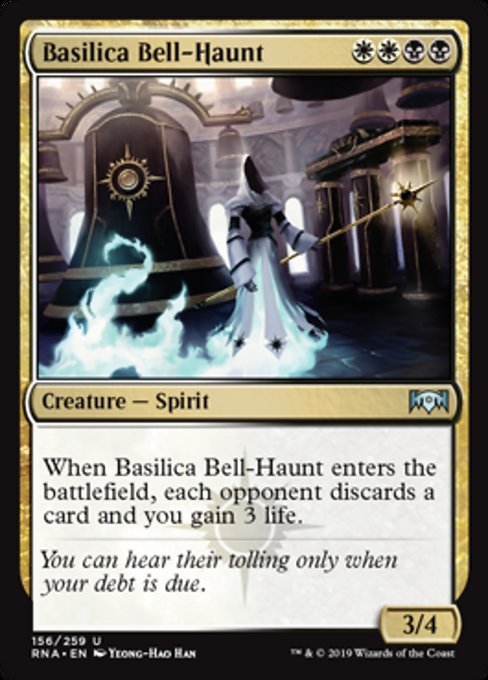
Basilica Bell-Haunt
AI Rating: 4.3Pro Rating: 3.5
This whole cycle is pretty powerful, and that’s certainly the case here! This gives you a solid body, usually nets you a 2-for-1, and even gives you some life! The one downside is the mana cost, which even in an Orzhov deck won’t always be easy to produce. Still, you’ll usually be able to hit a card when it ETBs.
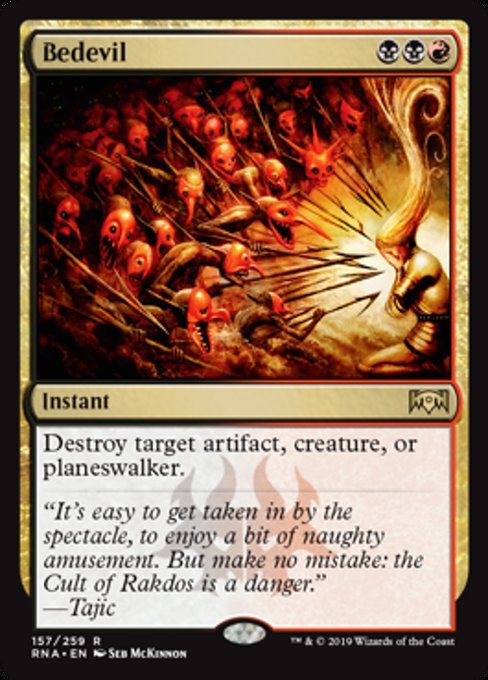
Bedevil
AI Rating: 4.6Pro Rating: 3.5
This is just great removal. This format doesn’t have very many artifacts or planeswalkers, so it often feels like a hard-to-cast Murder, but its still pretty good.
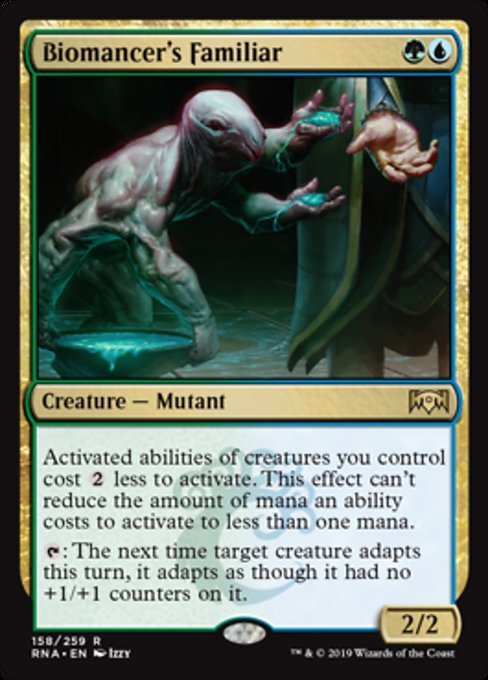
Biomancer's Familiar
AI Rating: 2.9Pro Rating: 2.5
You will actually end up being able to set this up to use its abilities on occasion, but not nearly often enough for this to be anything more than solid.
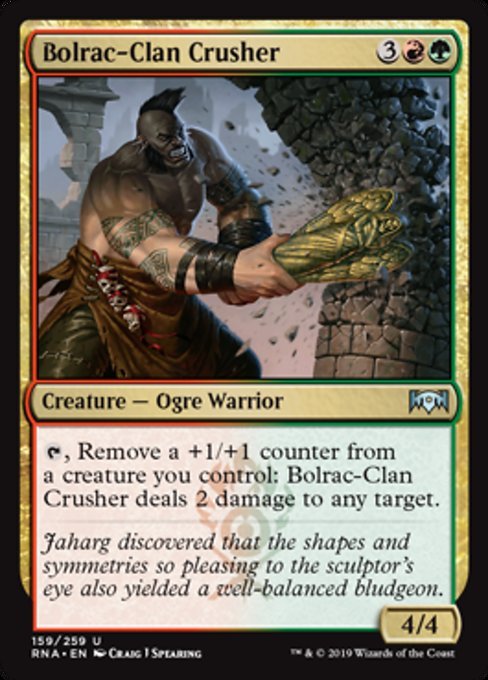
Bolrac-Clan Crusher
AI Rating: 3.3Pro Rating: 2.5
Turning counters into damage is nice, but this card’s clunky stats aren’t, and you’ll often find yourself in situations where just keeping your counters around is better!
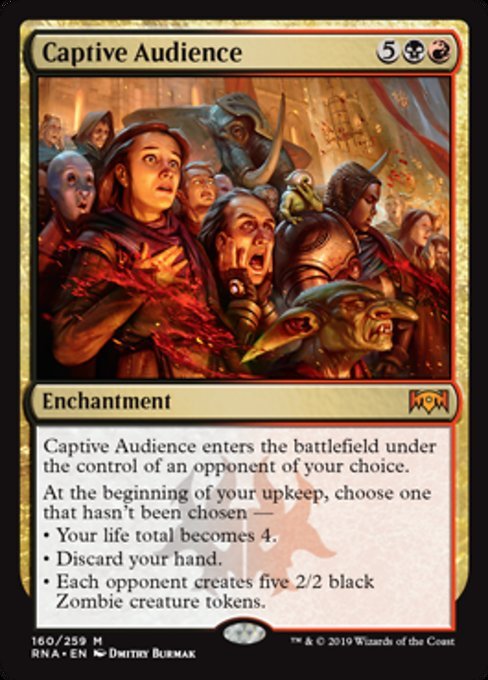
Captive Audience
AI Rating: 4.5Pro Rating: 2.5
This is a very fun card – but not an amazing one. It costs a massive amount of mana, and your opponent will often be able to make the first two choices not really impact them in the immediate future. By the time they get to third choice, though, they are usually going to be in some trouble one way or another. Captive Audience is pretty nice if you’re already ahead or parity, but not that great if you’re behind, and it often feels like it doesn’t do anything for the first turn or two, and that hurts for 7 mana.
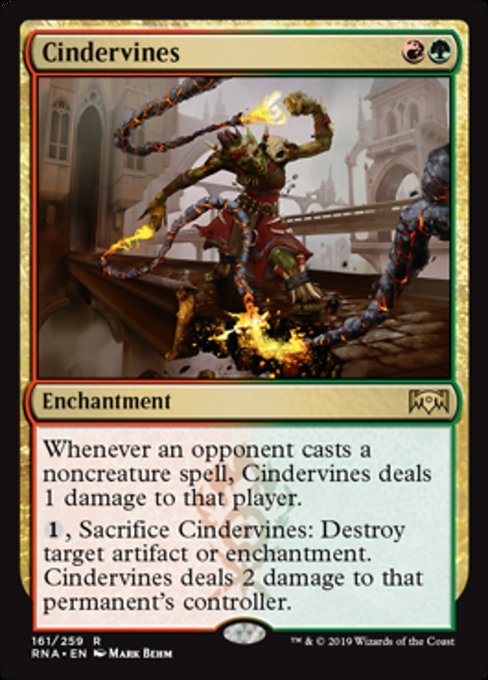
Cindervines
AI Rating: 3.2Pro Rating: 0.5
This is a decent sideboard card. You’re really only going to want to bring it in against decks with artifacts and enchantments worth targeting, though. The other ability isn’t enough on its own.
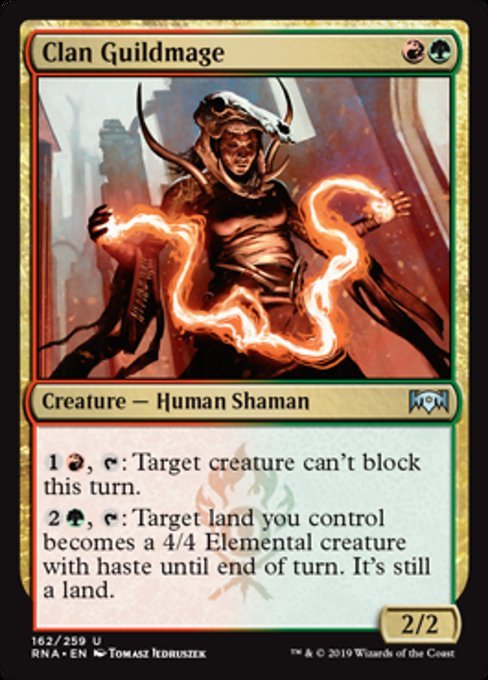
Clan Guildmage
AI Rating: 2.4Pro Rating: 3.0
This guildmage might be the most underwhelming of the group, but its still pretty good! One problem is that both of the abilities kind of do the same thing, so it isn’t as flexible as the others. Turning off a blocker can really allow you to get in for huge damage, and animating a land for a turn can do that too.
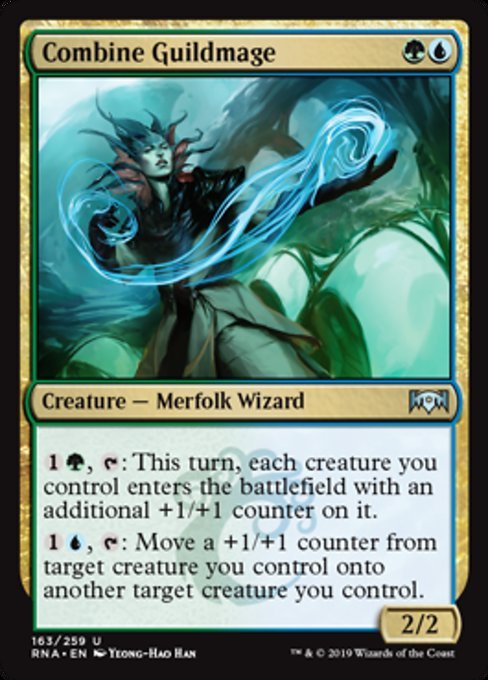
Combine Guildmage
AI Rating: 3.7Pro Rating: 3.5
There are a whole lot of counters in this set, so both abilities on the Guildmage end up coming up a lot in the mid-to-late game, and its pretty powerful to threaten to move counters around, or add additional counters to your creatures.
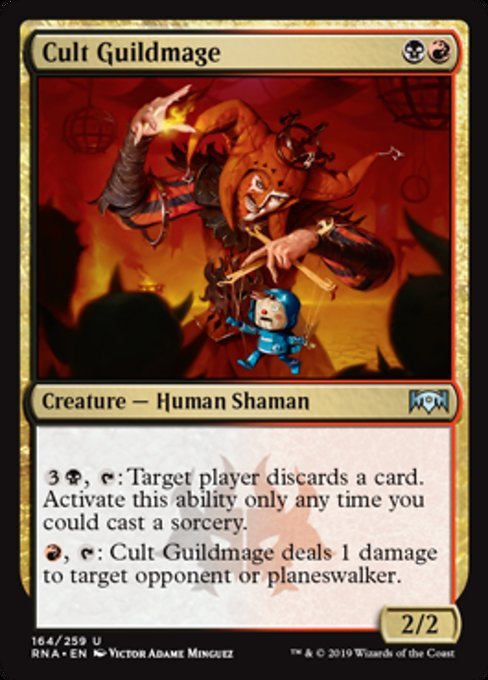
Cult Guildmage
AI Rating: 3.4Pro Rating: 3.5
The second ability is where most of the value is on this one, since pinging your opponent for only a single Red is a pretty darn good deal, and also sets up all of your Spectacle. Its nice you can disrupt your opponent’s hand in the late game too.
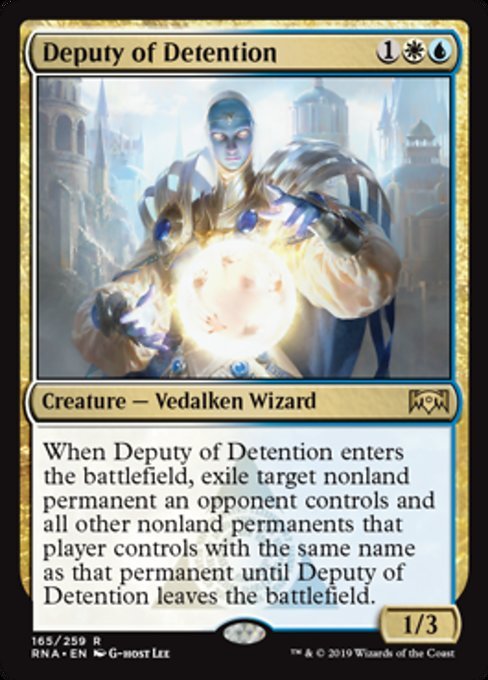
Deputy of Detention
AI Rating: 4.4Pro Rating: 4.0
Like always, these “Banisher Priest” type creatures are excellent, since they can remove virtually any creature while adding to the board. And yeah, your opponent could find a way to get the creature back, but even if they do you will usually have disrupted their plans significantly.
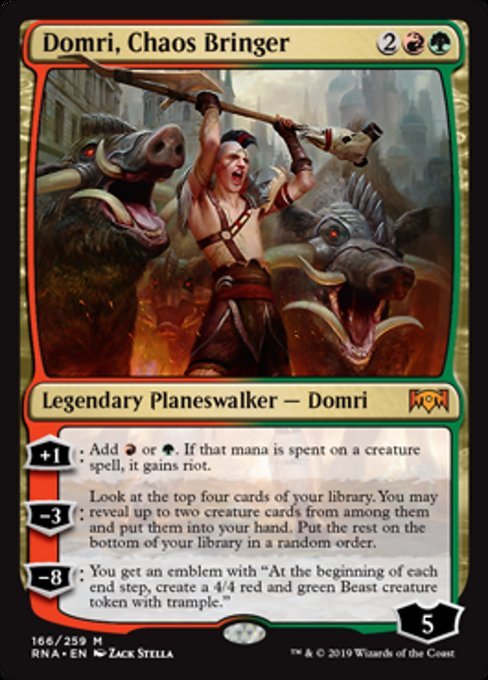
Domri, Chaos Bringer
AI Rating: 4.5Pro Rating: 3.5
This Domri doesn’t do a very good job of protecting himself, and that’s always a pretty big liability in a Limited planeswalker and keeps him from being even close to a bomb. He does synergize with himself pretty well, though. If you play him and use his -3, and then use his +1 a couple of times, you’re going to feel pretty good, as you can play the cards you drew with his ability and give them Haste. One problem, though, is that his -3 won’t always hit you two creatures, since you’re only looking at four cards.
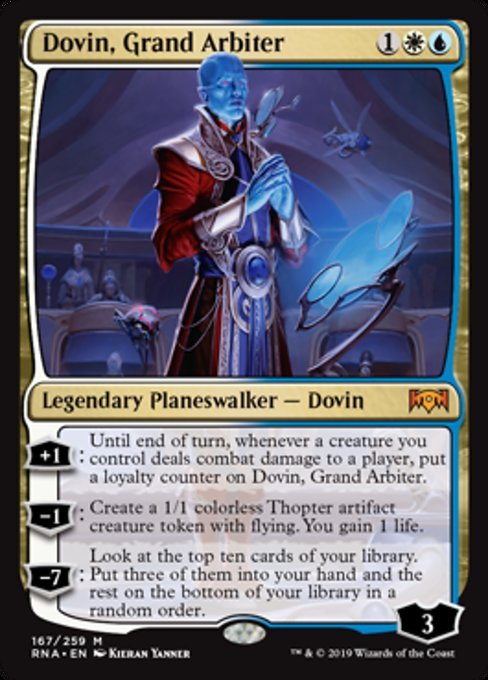
Dovin, Grand Arbiter
AI Rating: 3.9Pro Rating: 3.5
Dovin’s best ability is his -1, which can protect him while also pressuring the opponent with flying tokens. His +1 is pretty interesting, and if you have enough evasive creatures using it can be a good idea, especially if you can quickly reach his ultimate, but most of the time you’ll find yourself just using his -1 a few times, but that’s a pretty good deal for the very low mana investment.
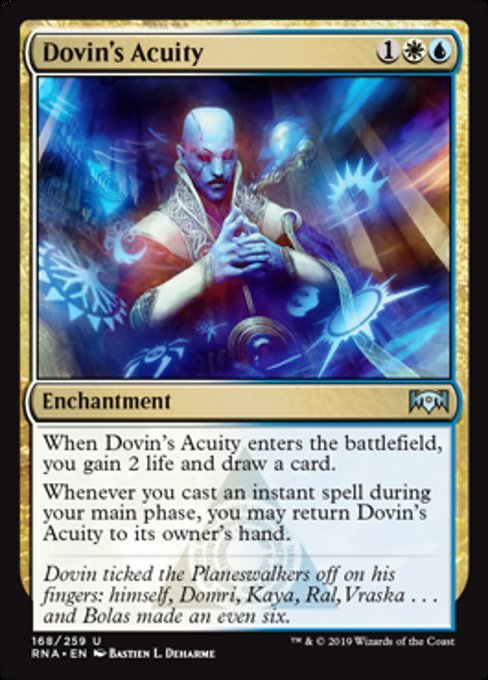
Dovin's Acuity
AI Rating: 4.2Pro Rating: 3.5
This is a very real card in the format, and it generates some insane value that really makes Azorius control decks into monsters in the late game. Sure, casting your Instants like they are Sorceries isn’t always ideal, but the cards and life you get from this really pay you off for going for the significantly clunkier play. The format is slow enough that Dovin’s Acuity is a very real card that will win you the game in the long run.
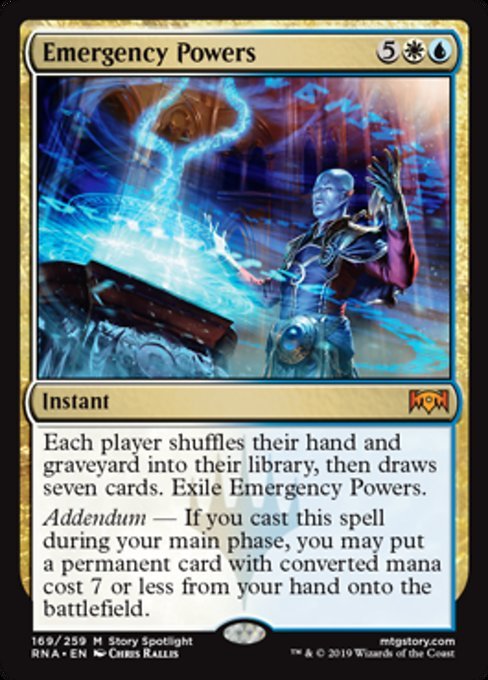
Emergency Powers
AI Rating: 3.5Pro Rating: 1.5
This is a really interesting design, though it isn’t particularly good! You have two options here. You can use this on your opponent’s end phase to reload both of your hands, and then get the first chance at playing some of the new cards you draw when you untap. That can feel pretty good, and is honestly sometimes better that going the Addendum route here. Getting one 7 mana permanent into play for free is nice of course, but then your opponent gets to untap and play everything in their hand. Either way, the card is pretty awkward if you’re already behind, and isn’t really guaranteed to get you ahead at parity either.
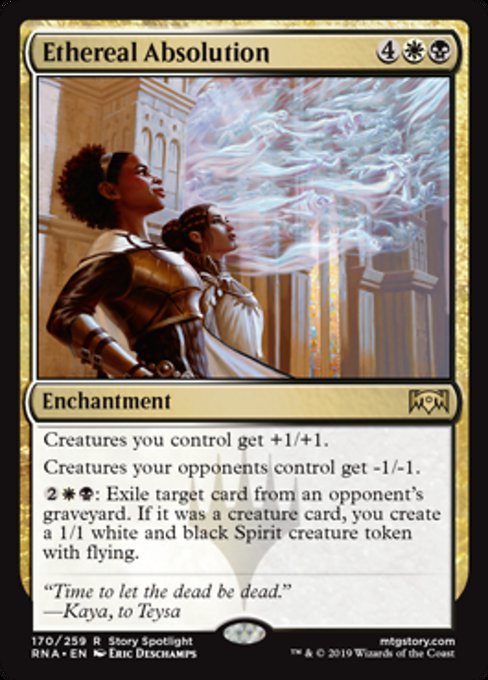
Ethereal Absolution
AI Rating: 4.8Pro Rating: 5.0
This is probably the biggest bomb in the format. Pumping your whole board and weakening your opponent’s is absolutely massive, especially because you can also generate 1/1 flying tokens with it. Oh, and obviously they will be 2/2s if the Absolution is in play. This has a major impact on the board immediately, and then generates a ton of creatures. It is tough to beat.
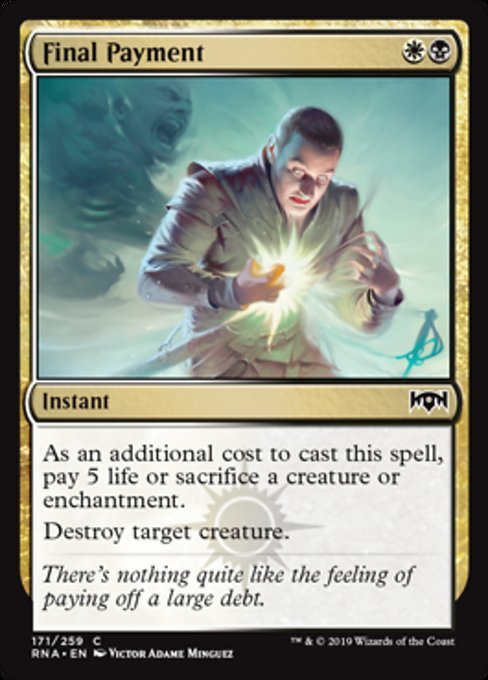
Final Payment
AI Rating: 3.6Pro Rating: 3.0
Two mana to destroy a creature is a great rate, and I love the options that you get here. Paying 5 life is often the preferable one, but you can also find ways to sacrifice stuff for value. It is difficult to run more than one of these, because you can’t be paying 5 life multiple times in most games, but the first copy is great.
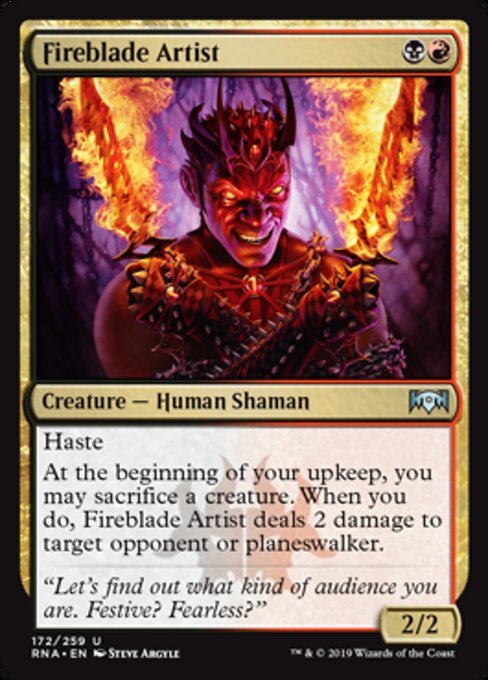
Fireblade Artist
AI Rating: 3.5Pro Rating: 4.0
This is one of the most aggressive cards in the format, and it can generate massive amounts of damage. A lot of the decks in the format are very slow, and this can really devastate most of those decks if it comes down early. Rakdos has enough sacrifice fodder that this can really work out, and it of course also gets Spectacle going.
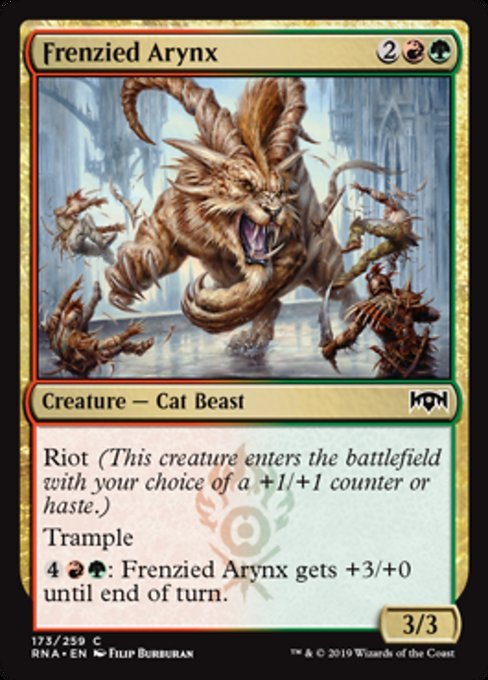
Frenzied Arynx
AI Rating: 2.9Pro Rating: 3.5
Whichever option you choose here, you end up with a very effective creature. I think that the +1/+1 counter option is typically the one you choose, but sometimes getting it with this right away is well worth it. The ability makes sure that by the late game, this is still a formidable attacker.
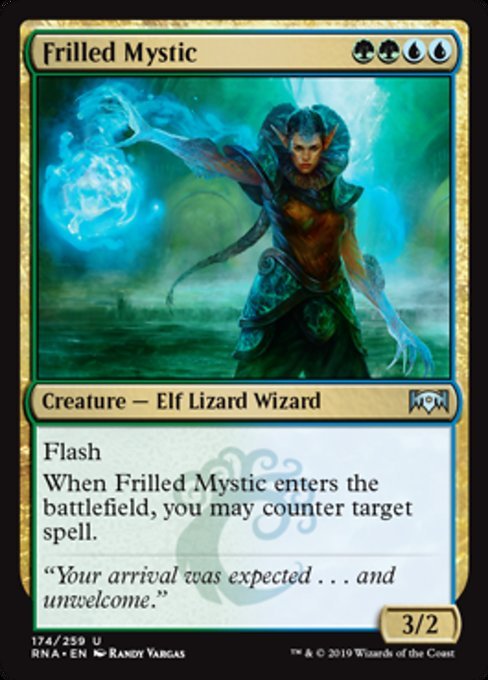
Frilled Mystic
AI Rating: 4Pro Rating: 3.5
If you pull this off, you end up netting a nasty 2-for-1. There are few things better than countering a spell and adding to the board at the same time! There will be times where you leave mana up and don’t get to use it, so be careful about how you’re using your mana in general. One nice thing is your plan B can be to Adapt a creature, so you don’t end up leaving up your mana for nothing.
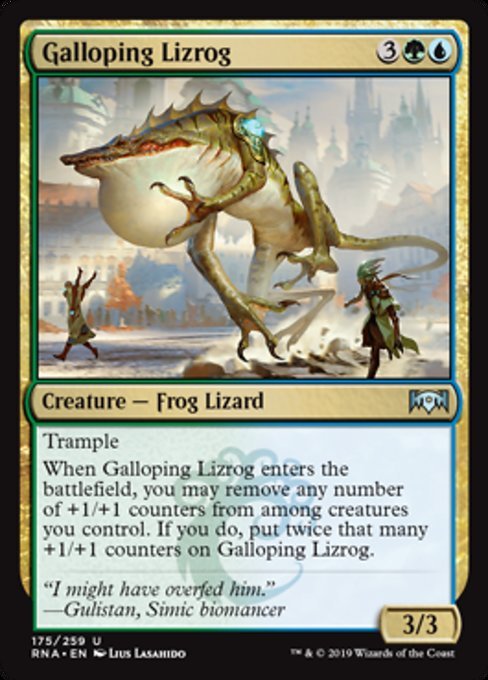
Galloping Lizrog
AI Rating: 3.8Pro Rating: 3.0
The base stats here are pretty bad, so if you don’t have a board with a decent number of counters it feels absolutely terrible. Additionally, you don’t usually want to be putting all of your eggs in one basket in Limited, so be cautious about how you use the Lizrog. It is usually just going to be better to leave counters on multiple creatures, rather than move them to all to the Lizrog. But yeah, it is nice that you can just remove a single counter from something and that makes it a 5-mana 5/5 trampler.
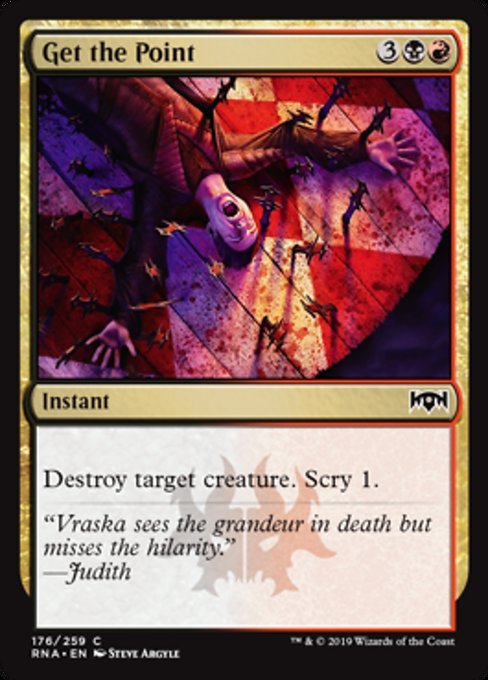
Get the Point
AI Rating: 3Pro Rating: 3.5
This is great removal, kills everything no questions asked, and increases the chance that the card you’re going to draw will be what you want!
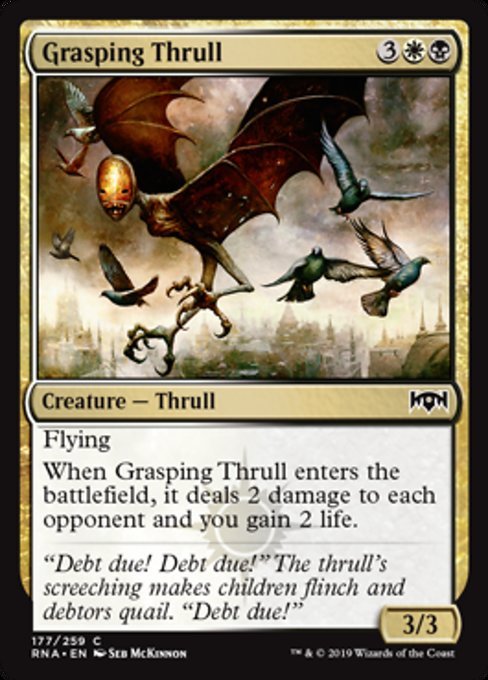
Grasping Thrull
AI Rating: 3.5Pro Rating: 3.5
This is a really great common for Orzhov decks. It is sort of a mini-Siege Rhino with Flying. And yeah, obviously it isn’t quite that good, but it is a very real flyer that immediately generates a 4-point life swing, and it turns out that’s a big deal.
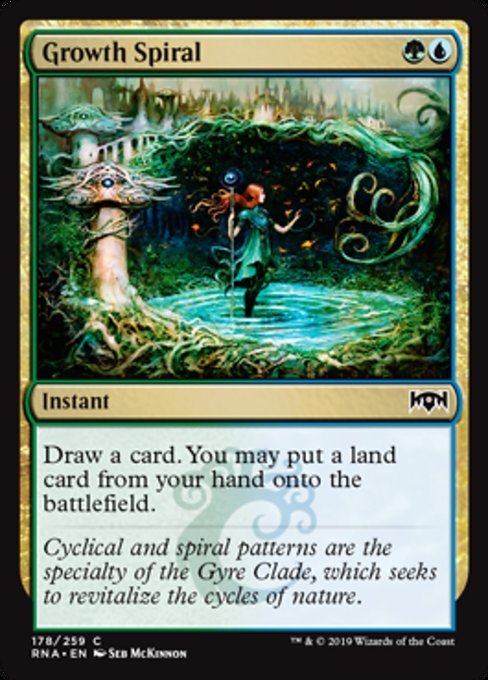
Growth Spiral
AI Rating: 2.7Pro Rating: 2.0
This is nice in Limited, but not the busted thing it is in constructed. You won’t always be able to take advantage of the extra land effect after the early game, but that still means it’s a cantrip, which isn’t too shabby.
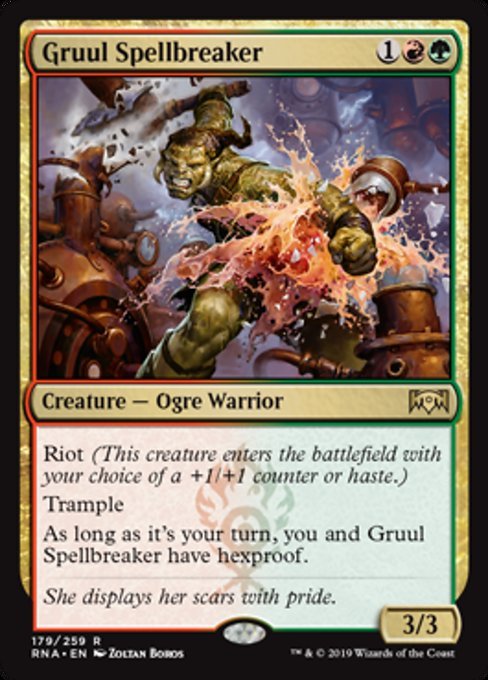
Gruul Spellbreaker
AI Rating: 4.7Pro Rating: 4.0
This is an excellent and efficient creature, and one that your opponent has no hope of interacting with on your turn. Its nice to know that you can use tricks and stuff on the Spellbreaker and know with certainty things will go your way!
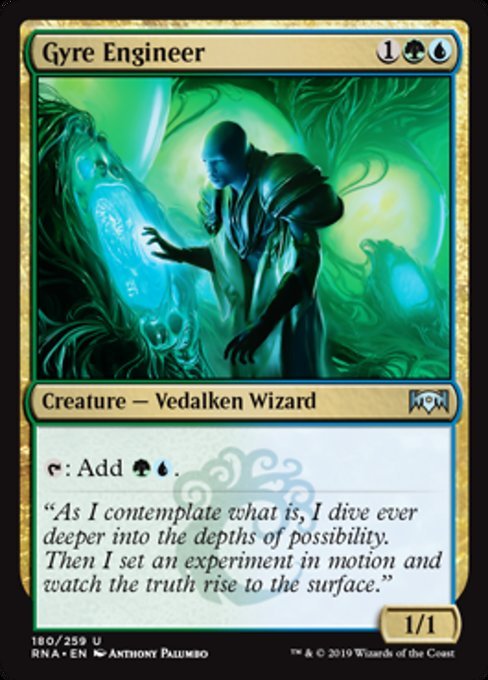
Gyre Engineer
AI Rating: 3.8Pro Rating: 3.0
This is incredibly fragile, and you’ll find it often dies to a very cheap removal spell before you untap with it. But if you do untap, you get a pretty nice mana boost.
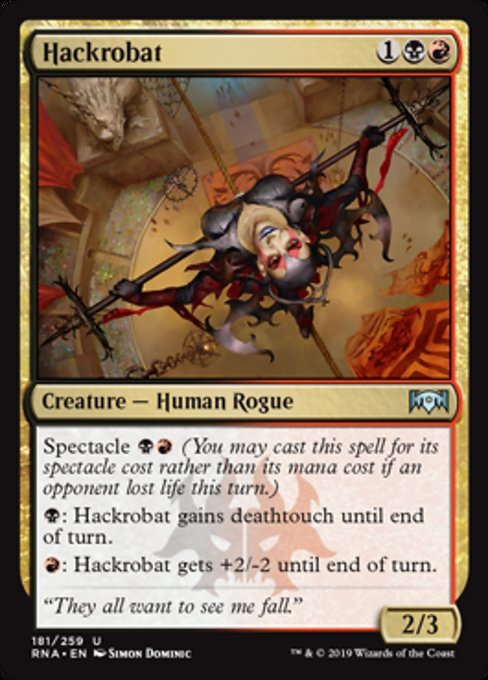
Hackrobat
AI Rating: 3.6Pro Rating: 3.5
This is a really nice creature, whether or not you manage to cast it for Spectacle. It is a real challenge to block thanks to death touch, and it can hit really hard. If you do cast it on turn two it feels pretty insane!
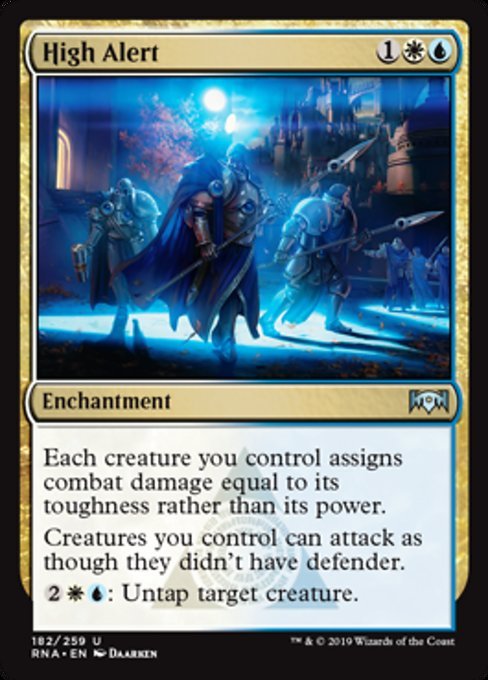
High Alert
AI Rating: 1.1Pro Rating: 0.0 // 3.0
Obviously enough, this is a build around, but it is one that its possible to make work in the format. There are enough defensive creatures in the format, and this combines particularly well with the unblockable 2/5 with Vigilance. It is going to be terrible in most Azorius decks, though.
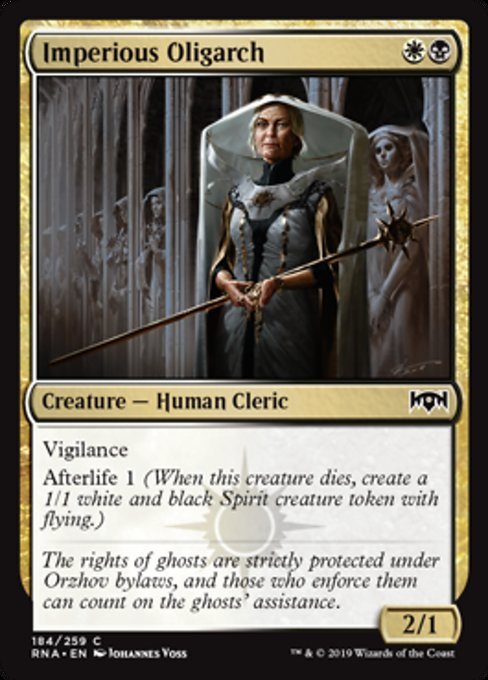
Imperious Oligarch
AI Rating: 3.1Pro Rating: 3.5
This has nice base stats and comes with the very nice Afterlife mechanic. Two mana for a 2/1 with Vigilance and a 1/1 Flyer is a pretty great deal, even if you aren’t getting them both at the same time.
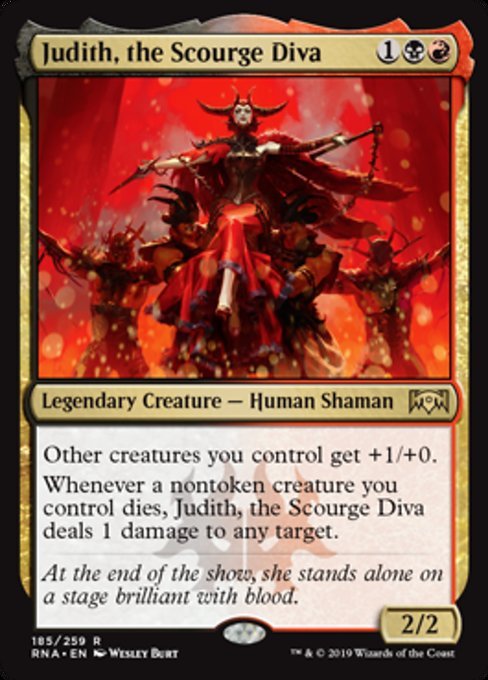
Judith, the Scourge Diva
AI Rating: 4.4Pro Rating: 4.5
Judith comes down and drastically improves just about any board state. The power boost can make a big difference, but what really pushes her into the bomb range is the fact that she let you ping anything when one of your nontoken creatures dies. This really messes with how combat is going to go for your opponent. Simply playing her and attacking with your board is often going to end the game in your favor in the mid to late game, and in the early game she also causes all kinds of problems.
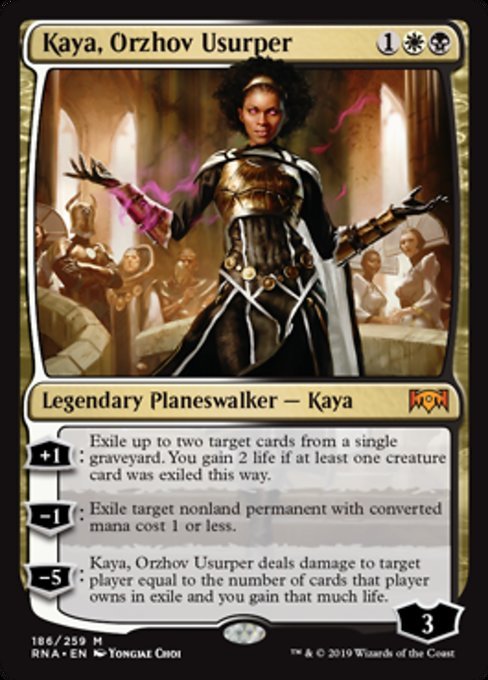
Kaya, Orzhov Usurper
AI Rating: 4.3Pro Rating: 0.0
This isn’t the kind of planeswalker that works out in Limited. Her +1 and -1 are both far too narrow to do something meaningful consistently, and while it is fun to imagine using her +1 a few times and then firing off her ultimate, you just won’t be able to do it since she has no good way to protect herself, and you can’t even guarantee that you will have the cards to exile in the first place!
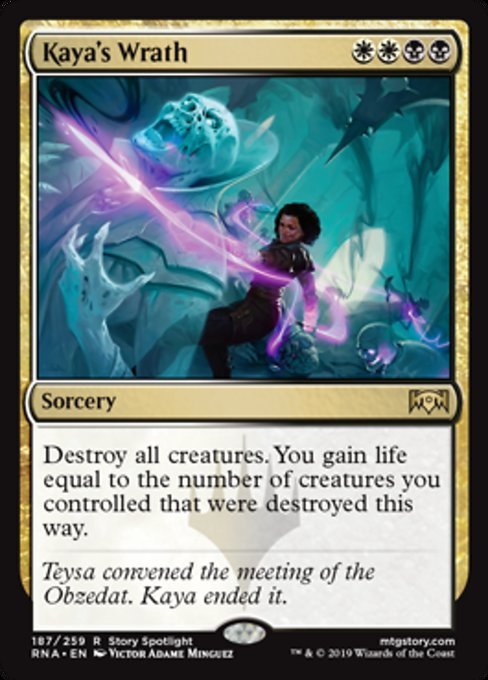
Kaya's Wrath
AI Rating: 4.7Pro Rating: 4.5
Wrath effects are pretty much irreplaceable. They have an impact on the board that virtually no other card can. They can be a bit awkward too, like in situations where you’re ahead and you’d rather have a card that allows you to press your advantage rather than a reset button. But still, if you end up behind, this card can really solve that problem for you in a way nothing else can! Gaining life off of casting it also can really give you a better chance at turning the game around. Notably, this also combines pretty well with the Orzhov mechanic of Afterlife, as you can nuke the whole board and still have a few flyers left behind, which will pretty much always mean you win the game.
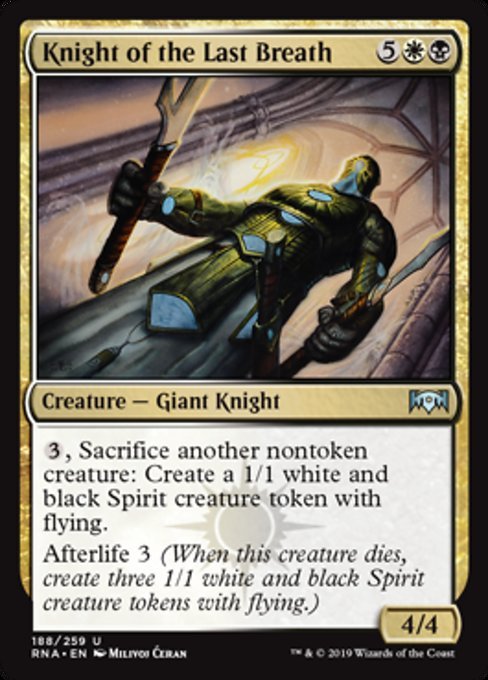
Knight of the Last Breath
AI Rating: 2.4Pro Rating: 2.0
This is mostly too clunky. A 7-mana 4/4 is just bad, even if it does leave behind three 1/1 tokens and the ability to generate more tokens. It isn’t unplayable, but you’ll find yourself cutting it a lot.
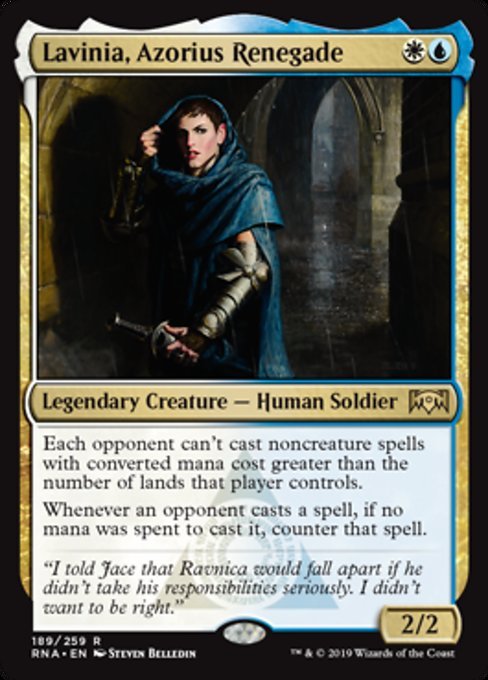
Lavinia, Azorius Renegade
AI Rating: 2.3Pro Rating: 1.0
In Limited, this is mostly a hard-to-cast 2/2, and you don’t really need that.
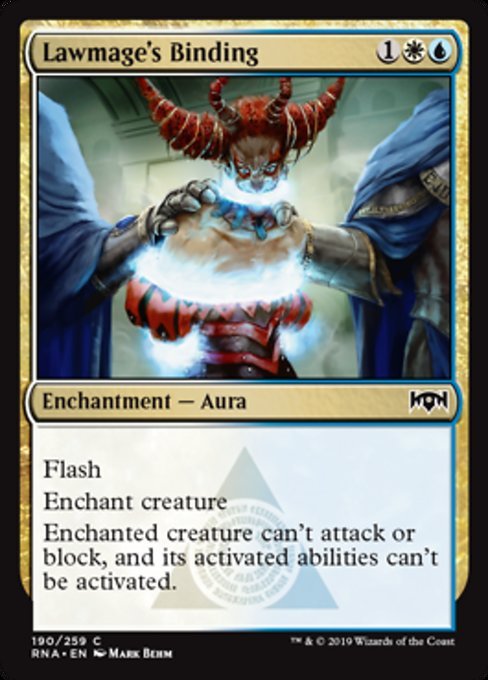
Lawmage's Binding
AI Rating: 4Pro Rating: 4.0
This is an excellent Common that lets you completely shut down just about any creature in the format, and Flash means you can do it at instant speed!
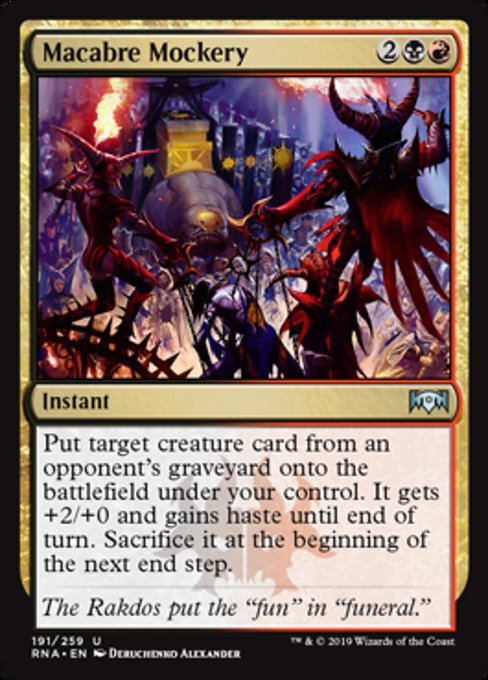
Macabre Mockery
AI Rating: 1.7Pro Rating: 1.5
Most cards that are just temporary reanimation spells don’t tend to be very good, and that’s pretty much the case here. Sure, you can get something back and get a big swing in sometimes, but what you get often isn’t worth the card you spend.
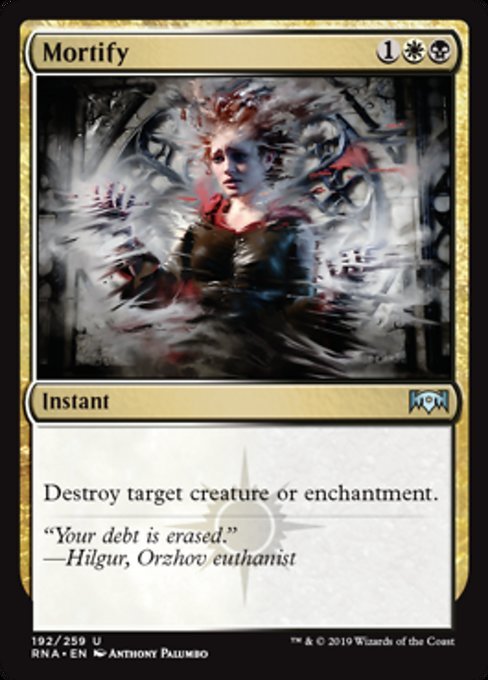
Mortify
AI Rating: 4.4Pro Rating: 4.0
This is obviously great, as it can very efficiently destroy two different permanent types.
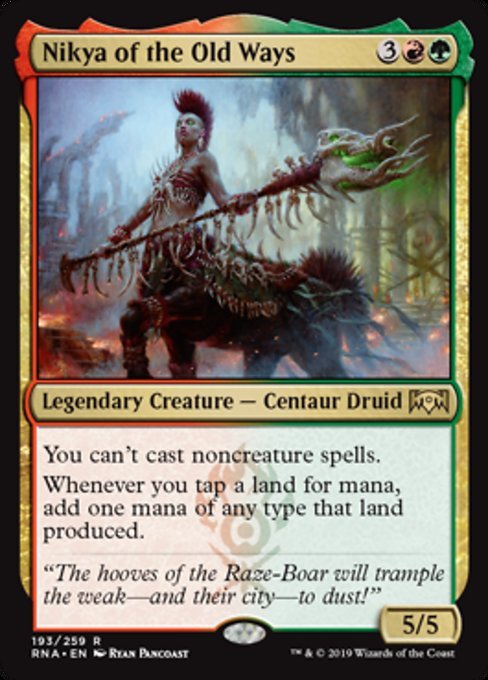
Nikya of the Old Ways
AI Rating: 3.6Pro Rating: 4.0
This card is surprisingly good. The downside is pretty real, but if you’re drafting Gruul you’ll find yourself in decks with 18+ creatures pretty often, and if that’s the case this is an excellent inclusion. You can usually drop it on turn 5, and then untap and play your hand on the next turn. Nikya gets even better if you make sure to include some activated abilities that you can sink your massive amounts of mana into. Drawing your noncreature spells when Nikya is in play can feel rough, but you can also just send in the big 5/5 and offer trades when that situation happens.
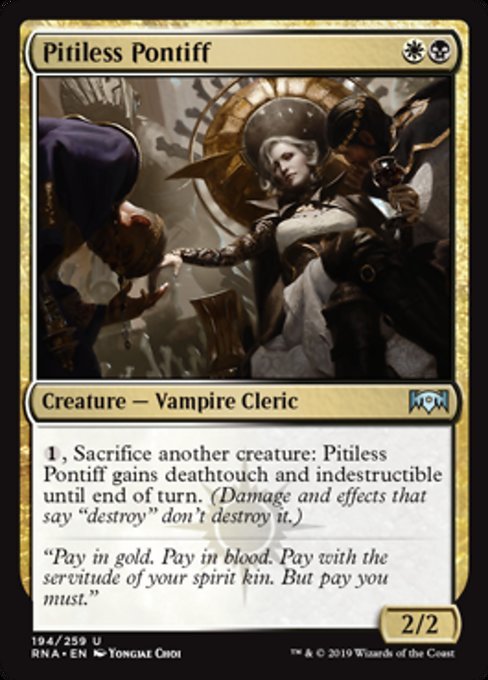
Pitiless Pontiff
AI Rating: 3.6Pro Rating: 4.0
This thing is a nightmare to play against if you don’t have any Flyers. It will kill virtually anything it tangles with in combat. Deathtouch and indestructible is a nasty combination. And yeah, you do have to give up a creature to make that happen, but Orzhov has plenty of expendable creatures thanks to Afterlife.
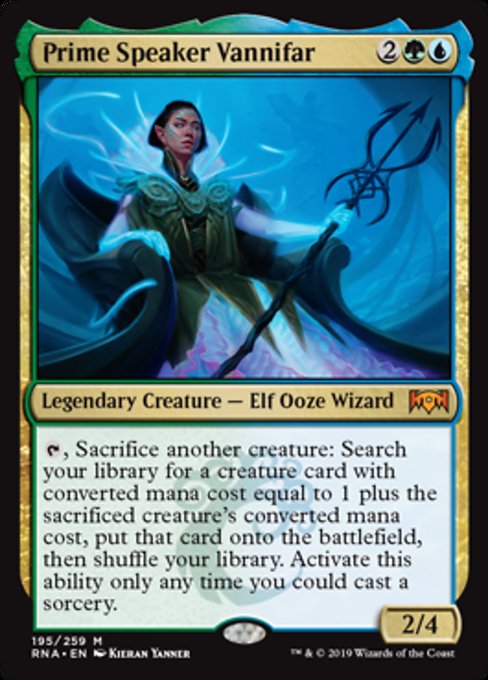
Prime Speaker Vannifar
AI Rating: 4.5Pro Rating: 2.0
It is pretty difficult to make this work in Limited – and it takes some significant work too! If you draw her, you need to make sure you know what your deck’s curve looks like, so that you know what you can search up at any given time. Most of the time, though, giving up a creature for one with a mana value of one higher isn’t a big game in Limited. It does get better if you have more expendable creatures, and creatures with ETB abilities.
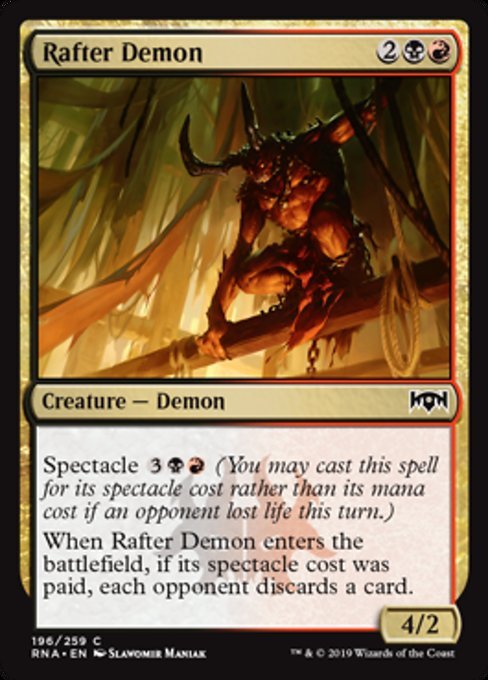
Rafter Demon
AI Rating: 1.1Pro Rating: 2.0
This is less impressive than most of the Spectacle cards. Without Spectacle, it is a horrendous 4-mana 4/2. It does get a pretty real upgrade if you do get Spectacle going, as a 5-mana 4/2 that forces a discard isn’t too bad, but it has some diminishing values as the game goes on.
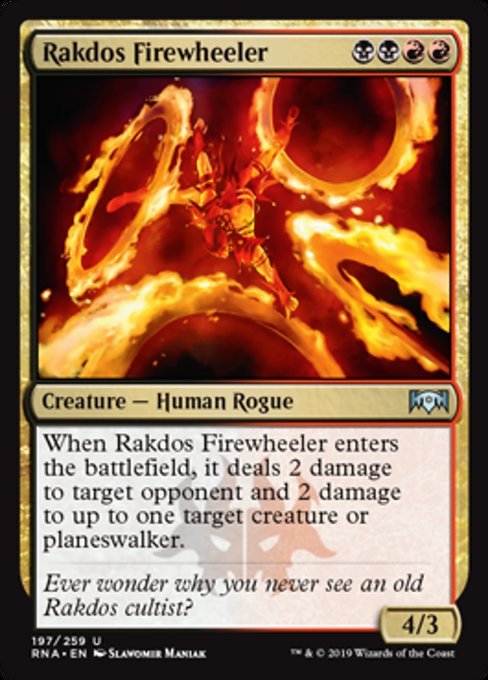
Rakdos Firewheeler
AI Rating: 3.4Pro Rating: 3.5
A 4-mana 4/3 that kills a small creature and shocks the opponent is always a great deal!
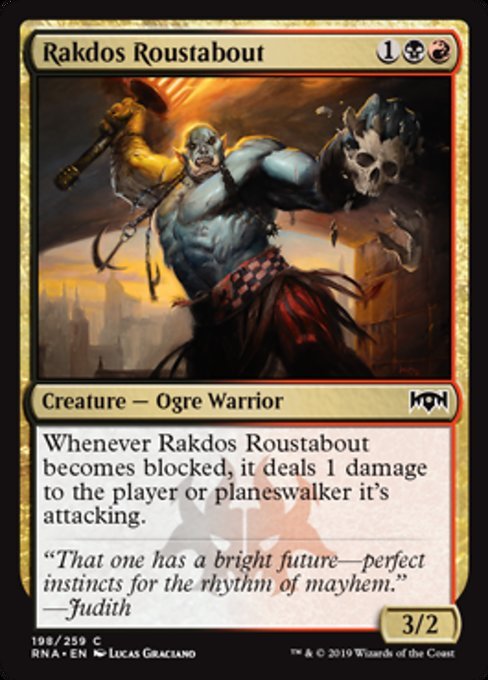
Rakdos Roustabout
AI Rating: 2Pro Rating: 2.0
The upside this card has doesn’t really do enough to overcome the bad stat-line. It does help you get Spectacle going, but so does just attacking with a more efficient creature!
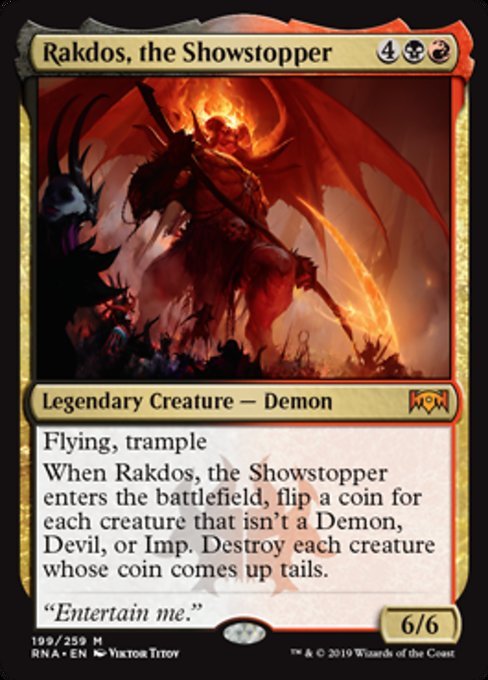
Rakdos, the Showstopper
AI Rating: 4.2Pro Rating: 4.5
This is a bomb, even if you do have to hold your breath a little bit when it comes to the coin flips. You’ll almost always come out ahead, since you’re adding a massive Flyer to the board at the same time, and your opponent doesn’t have that luxury. You can make it work a little more in your favor by playing other Demons, Devils, or Imps – and they are around, but you don’t really need to build around this for it to be good.
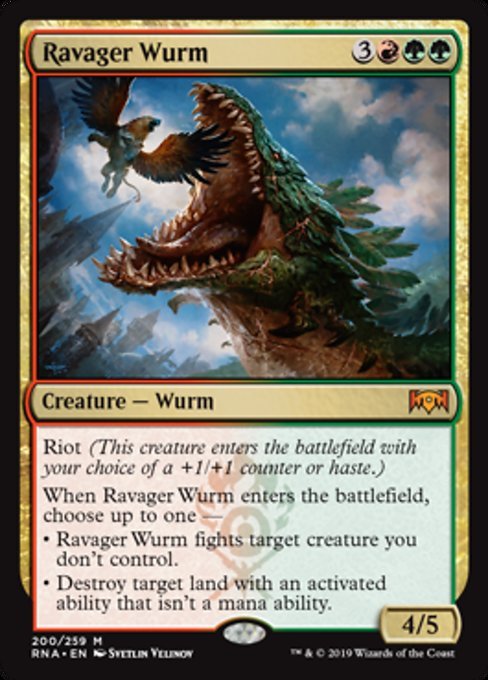
Ravager Wurm
AI Rating: 4.8Pro Rating: 5.0
This is a bomb. As usual with Riot, the +1/+1 counter option tends to be the better one, but its nice having the Haste option! It also has the modal ETB ability, and the obvious choice there most of the time is to go with the fight effect, as it allows you to kill something and add to the board at the same time. If you go with the +1/+1 counter, you’ve got a 5/6, and that can fight and kill almost anything in the format while also surviving! The other ability will almost never come up in Limited, but that doesn’t matter!
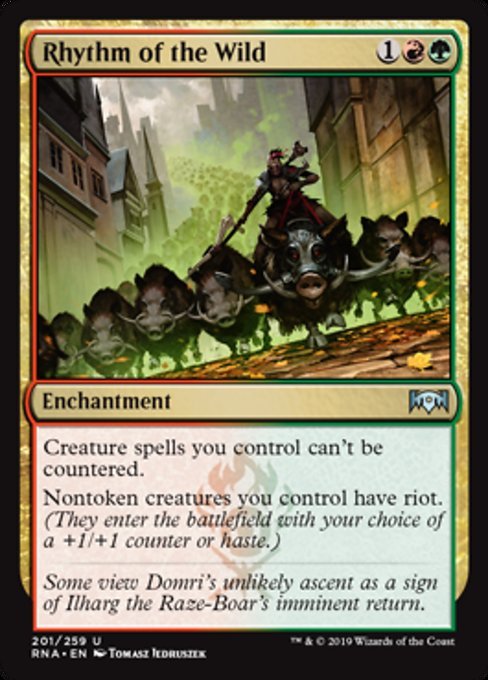
Rhythm of the Wild
AI Rating: 3.8Pro Rating: 2.5
This is powerful if you drop it on turn three, but significantly less impressive when you get it in the late game. It doe still upgrade all future creatures you draw, but when you are drawing one card a turn and not hitting creatures, it can be pretty rough.
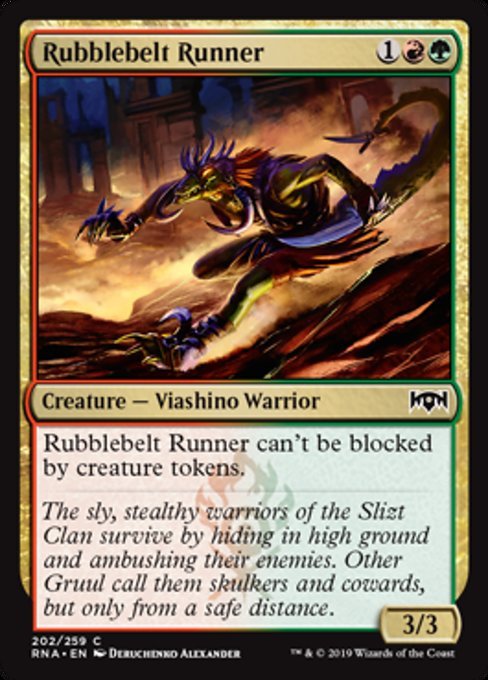
Rubblebelt Runner
AI Rating: 2.4Pro Rating: 2.5
This has decent stats and evasion that actually comes up sometimes.
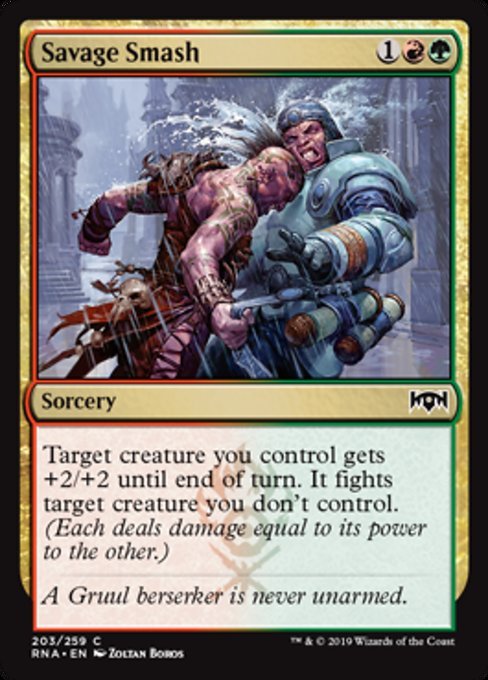
Savage Smash
AI Rating: 3.2Pro Rating: 3.5
The stats boost plus the Fight is massive, especially in situations where you can use this to kill a blocker and swing the thing you fought with. As always with Fight spells, you need to be a little bit cautious about when you cast it, since your opponent doing something in response often wrecks you.
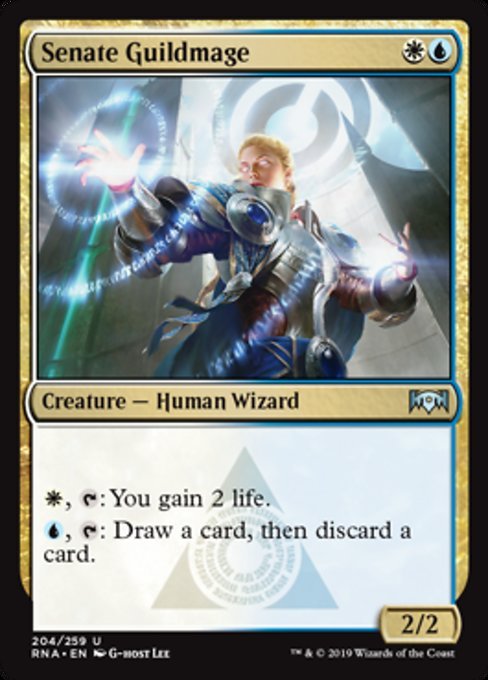
Senate Guildmage
AI Rating: 3.9Pro Rating: 4.0
I think this is the best of the Guildmages in this set. Both of its abilities are pretty nice, and easily usable. You end up just having a random mana around a lot in Limited! You can gain life if you really need to stabilize, or you can dig deeper in your deck if you need to find removal or press your advantage.
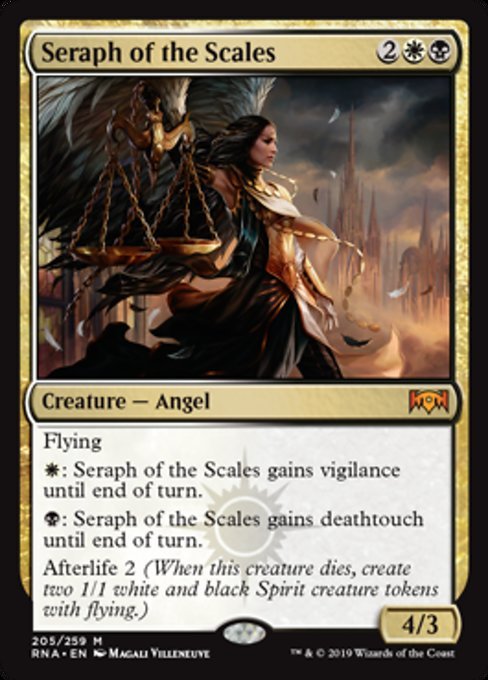
Seraph of the Scales
AI Rating: 5Pro Rating: 5.0
If your opponent can’t deal with this big flyer, it is going to quickly kill them. Even if they do kill it, you get two 1/1 Flyers. Basically, the upside here is that your opponent dies to a flyer, and the floor is that you get a 2-for-1. Yeah, that’s a bomb.
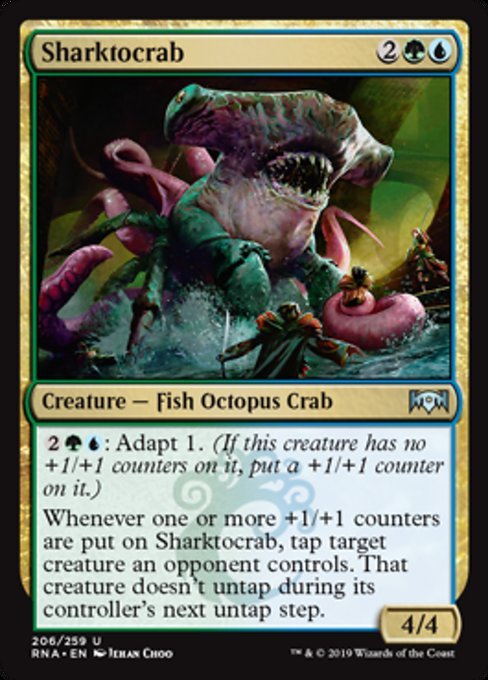
Sharktocrab
AI Rating: 3.9Pro Rating: 4.5
This is an Uncommon, but its also a bomb. You have a very efficient creature to start with, and then it comes with an incredible +1/+1 counter payoff – and it’s a payoff that it can generate all on its own thanks to Adapt. Freezing creatures down is a huge deal, especially when you have a big Fish Octopus Crab that can now get in there thanks to tapping something down. It gets really insane if you find a way to put counters on it even after you adapt!
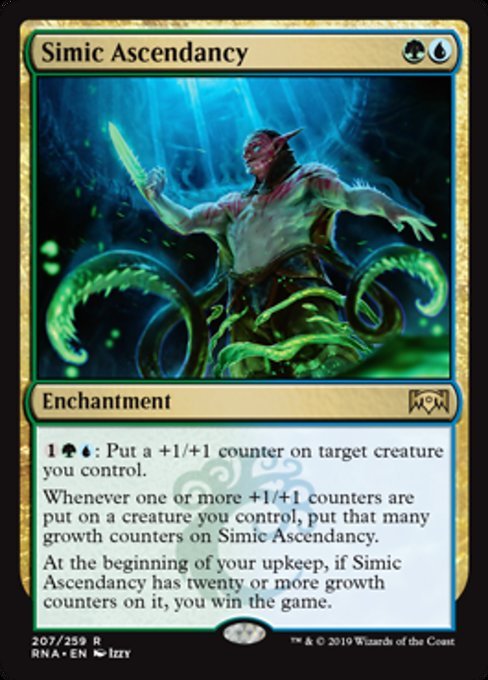
Simic Ascendancy
AI Rating: 2.3Pro Rating: 1.5
You shouldn’t ever expect to trigger the alternate win condition on this card, since if you have 20 counters you probably already won! The Ascendancy is pretty much only worth it in a deck that has lots of +1/+1 counter payoffs – like Sharktocrab. Otherwise, it is pretty clunky and inefficient.
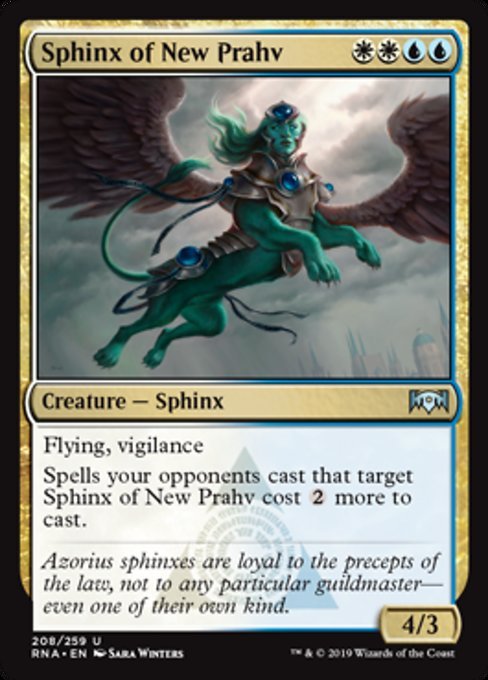
Sphinx of New Prahv
AI Rating: 3.9Pro Rating: 3.5
This has nice stats that can win the game on its own, and it is a little harder to kill than it looks at first glance thanks to its ability.
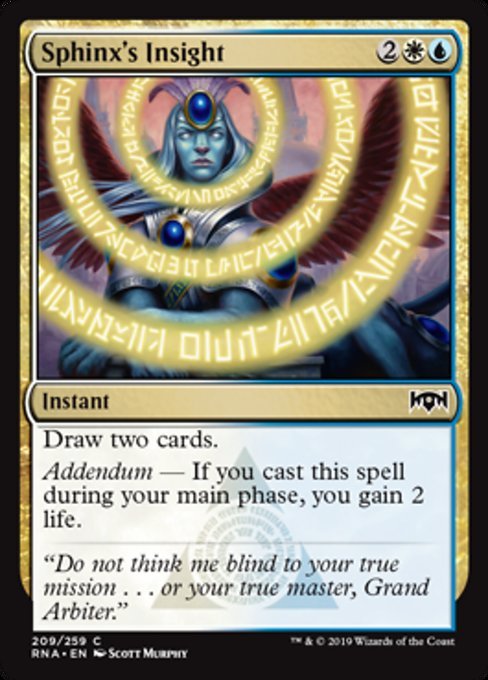
Sphinx's Insight
AI Rating: 3.4Pro Rating: 2.5
Both options on this have their place. Sometimes you want to cast it during your opponents turn so that you can untap and play the new things you drew, but sometimes that additional life is great.
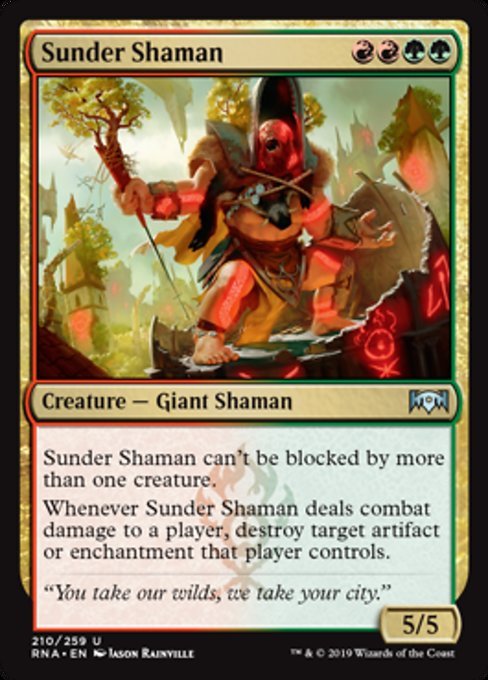
Sunder Shaman
AI Rating: 3.7Pro Rating: 3.5
This is hard to block effectively, and this format has enough artifacts and enchantments around that its ability to threaten those is a pretty big deal.
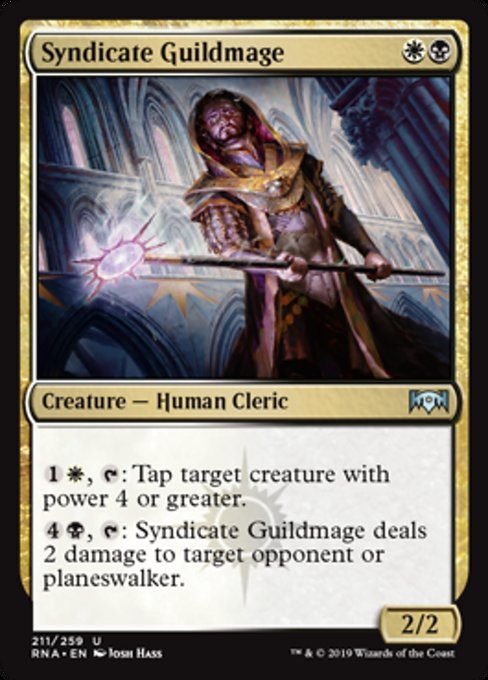
Syndicate Guildmage
AI Rating: 2.9Pro Rating: 3.5
This has two pretty nice abilities! The cheaper one can shut down big boys, which you can use either defensively or offensively. The second ability is the sort of thing you can use in the late game when the board is clogged up, and it can really help you get there.
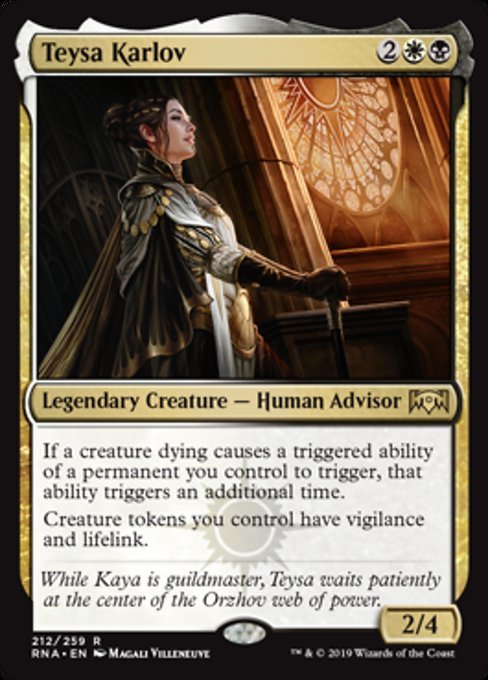
Teysa Karlov
AI Rating: 4.6Pro Rating: 3.0
In this format, this mostly will just make your cards with Aferlife better – but that’s pretty nice, since you’re going to end up with several cards featuring the mechanic in just about any Orzhov deck. You can find some other ways to abuse Teysa’s two abilities too!
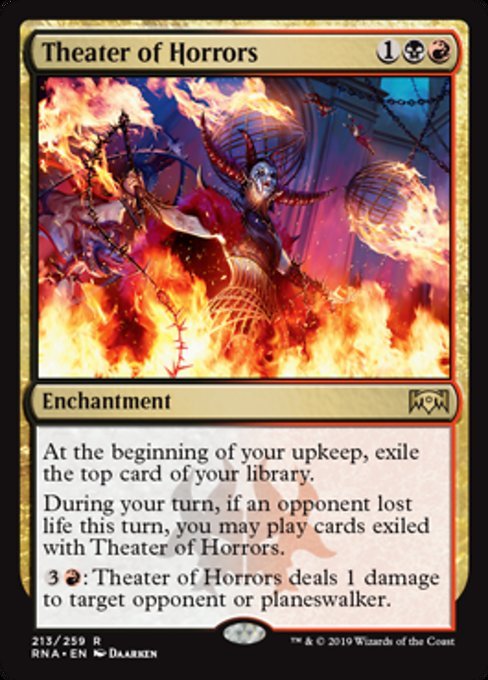
Theater of Horrors
AI Rating: 4.5Pro Rating: 4.5
This can generate a ton of card advantage, and can really allow you to snowball your opponent. It makes sure that your aggressive Rakdos decks will virtually never run out of gas, and it can even do damage to the opponent all on its own! Sometimes it ends up feeling like a bad draw when you can’t damage your opponent – but you were probably going to lose that game anyway!
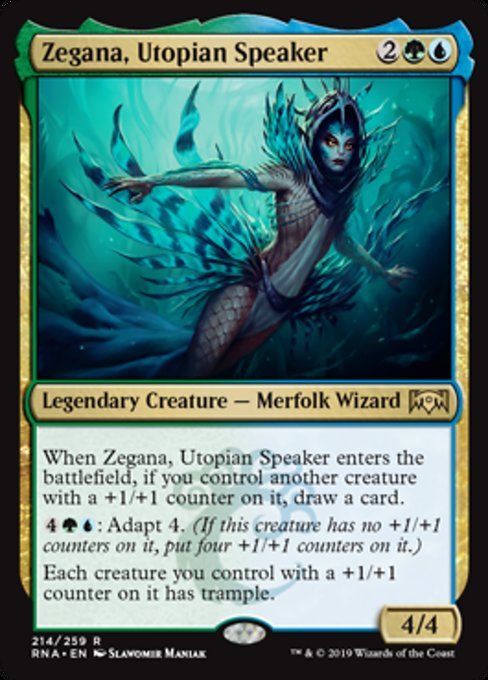
Zegana, Utopian Speaker
AI Rating: 4.6Pro Rating: 4.5
In a lot of Simic decks, Zegana just feels like a 4-mana 4/4 that draws you a card when it ETBs. Even if you can’t draw a card with her when she comes down, she comes with the ability to become absolutely massive. Keep in mind, she will gain trample when she gets counters, as will all of your other creatures.
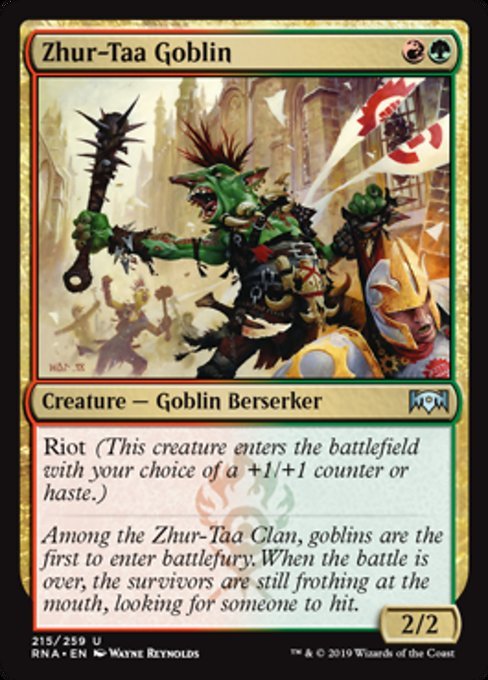
Zhur-Taa Goblin
AI Rating: 3.8Pro Rating: 3.5
This is either a two mana 3/3, or a two mana 2/2 with Haste, and both options are very appealing.
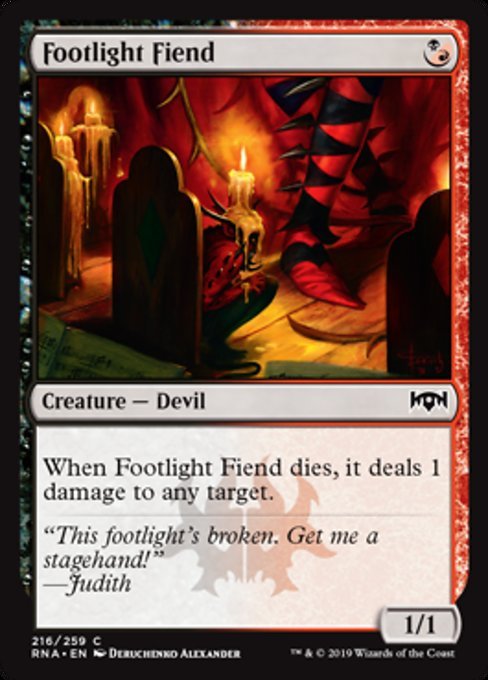
Footlight Fiend
AI Rating: 2.5Pro Rating: 2.0
This can sometimes generate a 2-for-1, and at the very least it really makes life difficult for any opponent that has an X/1 in play. It is also pretty good sacrifice fodder, and gets Spectacle going. It is a surprisingly effective one drop!
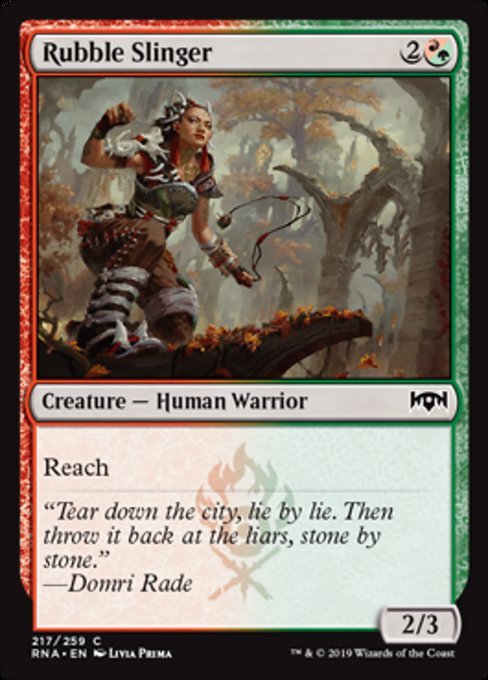
Rubble Slinger
AI Rating: 1.7Pro Rating: 2.0
If you don’t have any good ways to block flyers – this can certainly do it, though it isn’t exactly efficient.
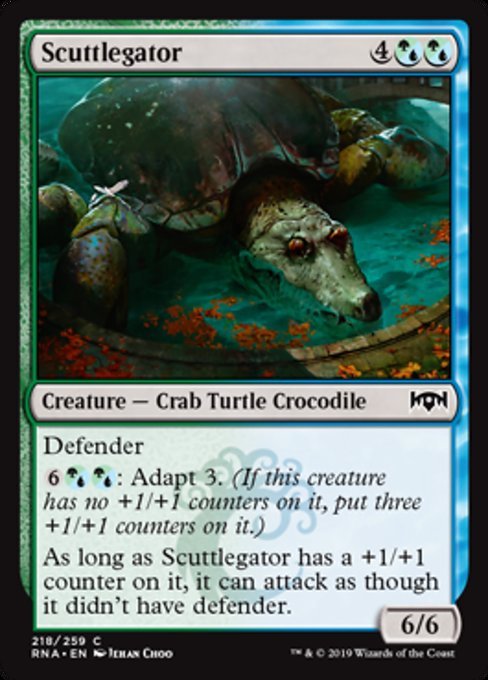
Scuttlegator
AI Rating: 1.6Pro Rating: 1.5
This isn’t very good. A 6-mana 6/6 with Defender can block pretty well, but you need your six drop to do more than that! It can eventually adapt into a huge creature that can attack, but it still feels too clunky most of the time.
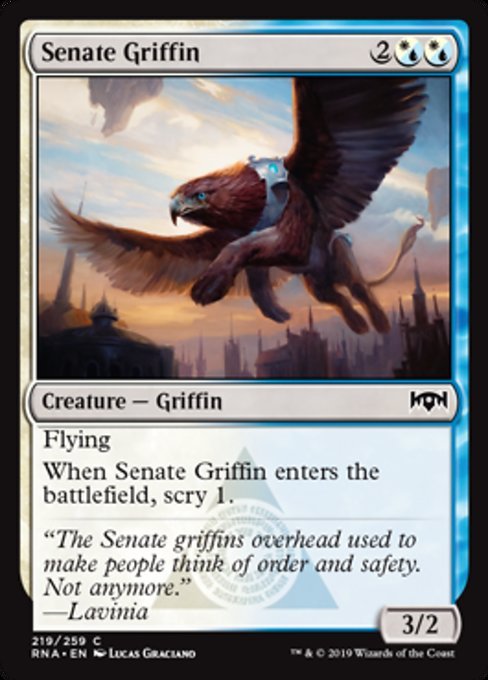
Senate Griffin
AI Rating: 3.1Pro Rating: 2.5
This is a nice little flyer. The stats are fine, and Scrying is always a good way to smooth out your draws.
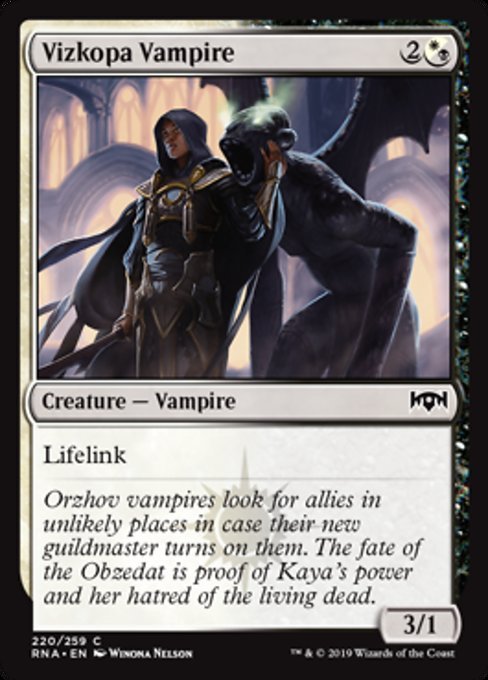
Vizkopa Vampire
AI Rating: 2.4Pro Rating: 2.0
This often just ends up trading for something and gaining you some life, which is fine, but not exactly exciting either.
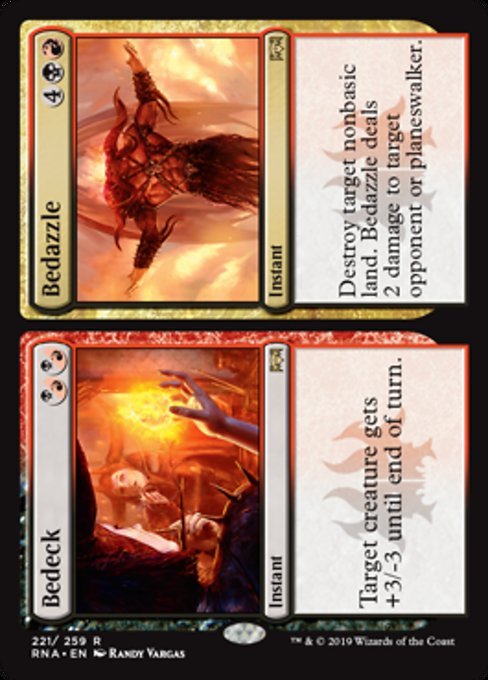
Bedeck
AI Rating: 4.9Pro Rating: 3.5
You mostly only care about the Bedeck option here, which is a very efficient removal spell that also has a little bit of upside as a combat trick. The Bedazzle option doesn’t come up a ton, but people do play greedy mana bases in this format, and sometimes your opponent is also at 2 or less life, in which case you want to use Bedazzle.
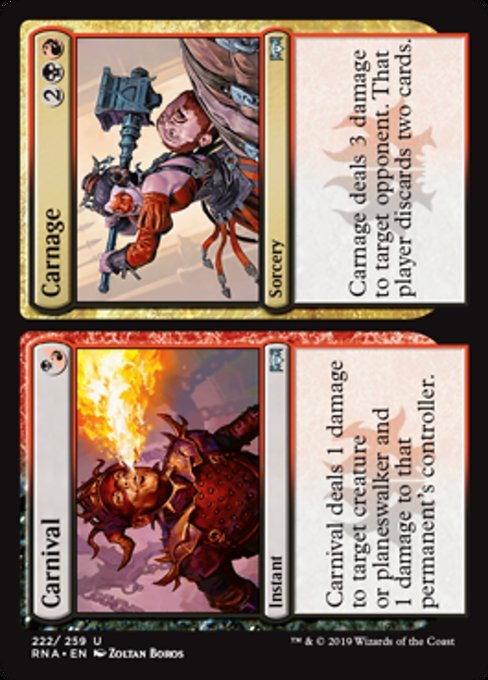
Carnival
AI Rating: 3.7Pro Rating: 2.5
There are enough X/1s in the format that Carnival can do some stuff. Carnage can be pretty nice when your opponent has the cards to hit with it.
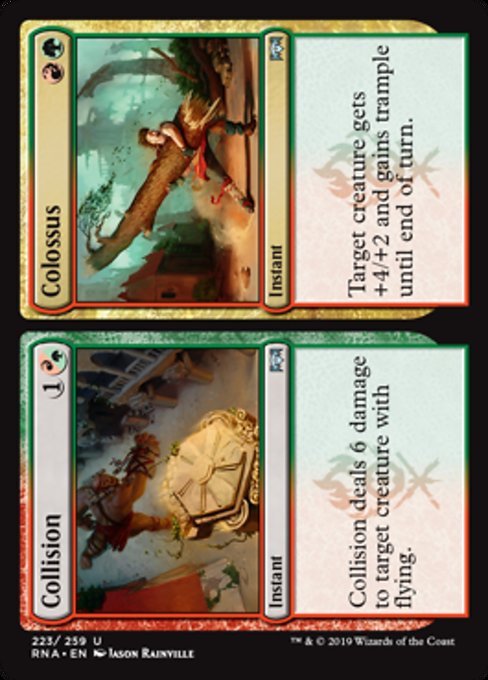
Collision
AI Rating: 4.1Pro Rating: 3.5
This card is a great example of how nice flexibility is! Being able to play a main deck Plummet effect is pretty sweet, and you definitely can here because the Colossus side is a pretty impressive combat trick that can allow for massive amounts of damage while also allowing your creature to win combat.
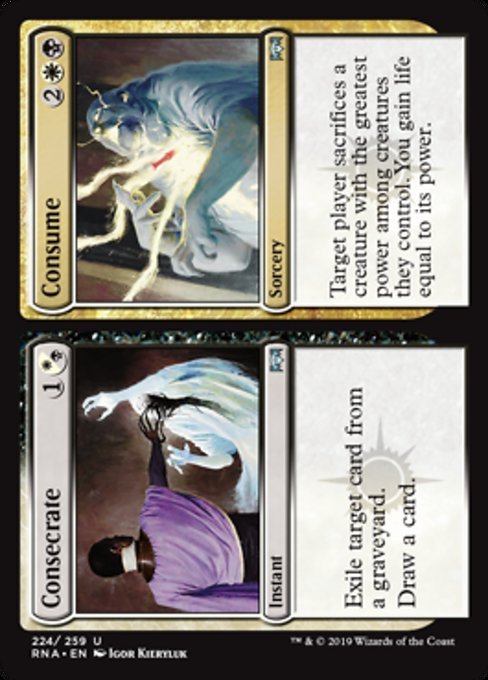
Consecrate
AI Rating: 3.9Pro Rating: 3.0
Consecrate is pretty situational and won’t come up a ton, but Consume is pretty nice most of the time. Your opponents’ creature with the highest power won’t always be their best, but it will be often enough that Consume ends up feeling pretty amazing most of the time.
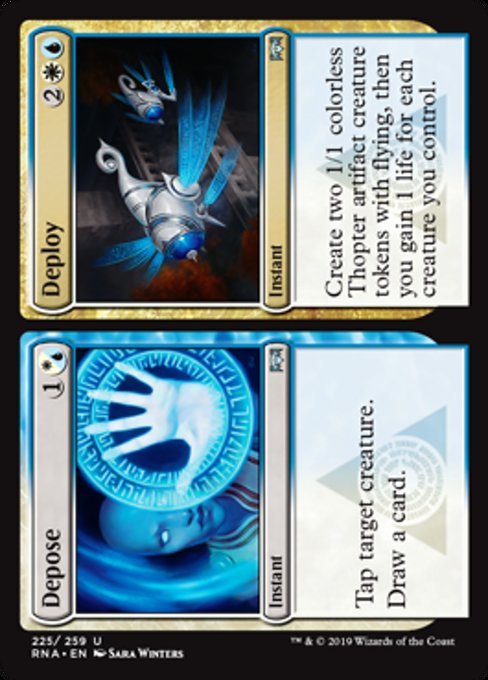
Depose
AI Rating: 4.1Pro Rating: 3.5
The Deploy side here is where most of the value is – and boy, it end sup being a lot of value! At worst, you get two 1/1 flyers and gain 2 life – and that’s about a 2.5, and this often ends up gaining you significantly more life. Having the Depose option is nice too, as sometimes you can use it to find a way to get through for lethal.
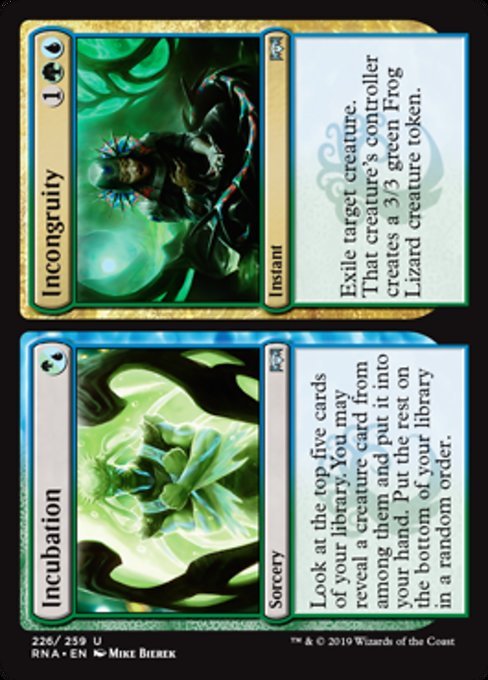
Incubation
AI Rating: 1.8Pro Rating: 2.0
This isn’t as impressive as the rest of this cycle. Both sides can be nice in certain situations, but even when you have both options, neither ends up feeling too great a big chunk of the time. Paying one to get a bit of card selection isn’t great, and neither is paying 3 to kill something and give its controller a 3/3. This is certainly playable, but not remotely impressive.
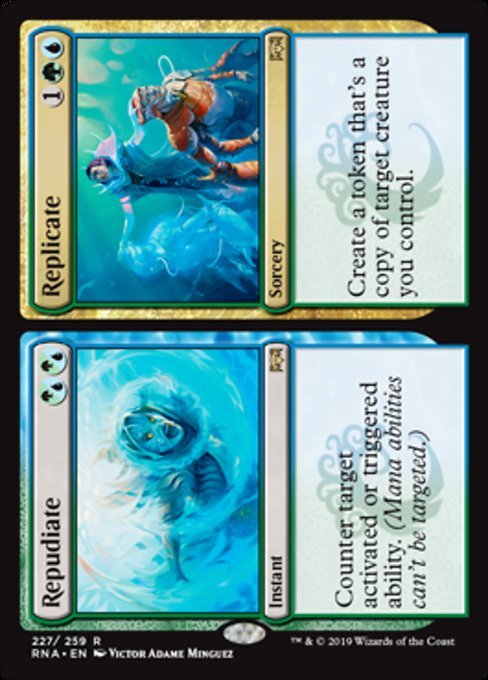
Repudiate
AI Rating: 4.2Pro Rating: 2.5
The Repudiate side doesn’t come up a ton, but there are lots of boards where Replicate is pretty solid, though obviously you need something worth copying!
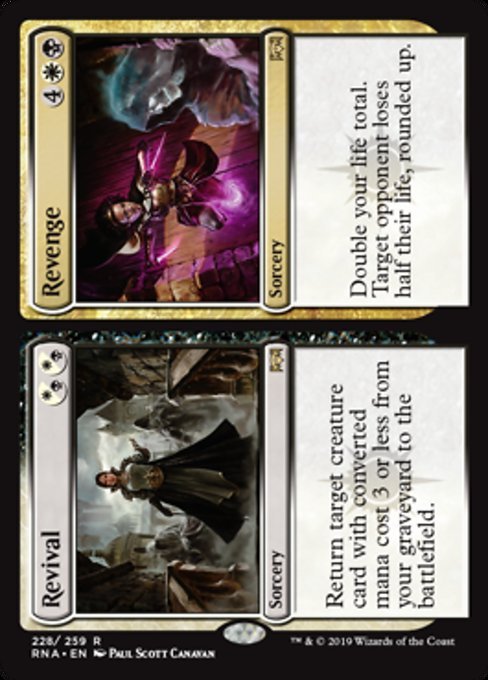
Revival
AI Rating: 3.8Pro Rating: 2.5
Both sides of this are pretty narrow effects. If you have something worth reanimating, Revival is fine. Revenge, meanwhile, can be an effect to really shift the momentum of a game in your favor, but there are plenty of life totals for both you and your opponent where it doesn’t really net you very much value.
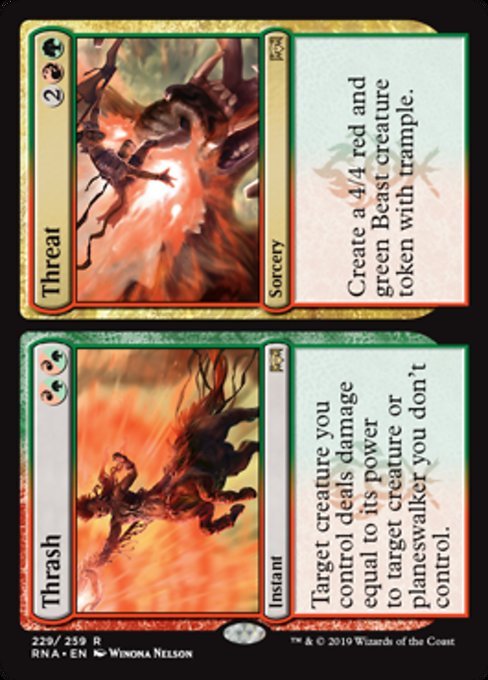
Thrash
AI Rating: 4.5Pro Rating: 4.0
This is great. The Thrash side is the best side, as its just a great removal spell. But the downside with that type of removal is that you need to have a creature – and if you don’t have one of those, you can get a 4-mana 4/4 with Trample which isn’t bad either.
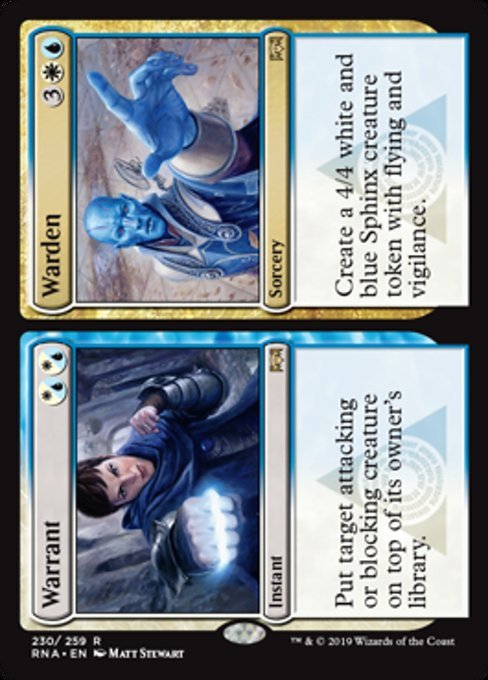
Warrant
AI Rating: 4.9Pro Rating: 4.0
This gives you a choice between a pretty nice removal spell and a very efficient creature that can close out the game in the air. Those are great options!
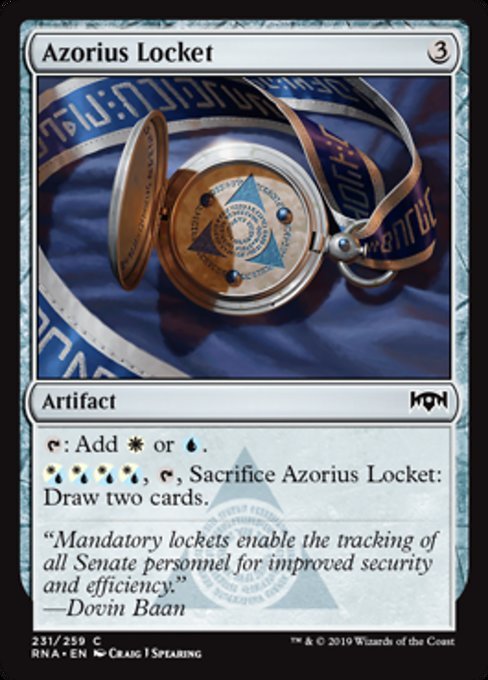
Azorius Locket
AI Rating: 1.4Pro Rating: 2.0
If you need fixing, these are fine. Some mana rocks are pretty big duds once you have enough mana or the mana that you need, but its nice you can throw these away to get some cards.
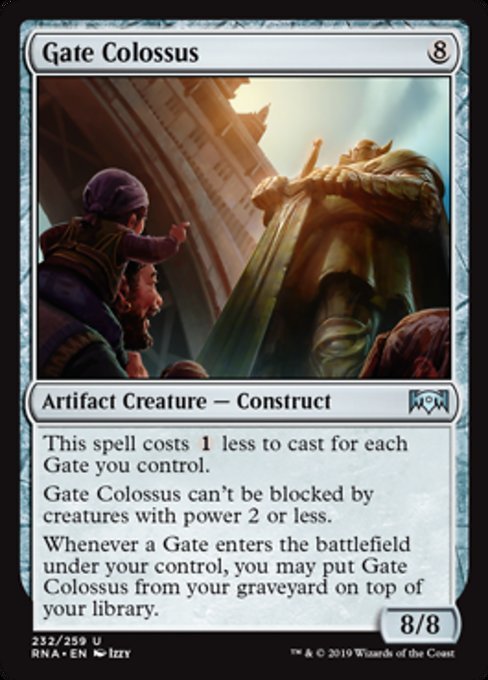
Gate Colossus
AI Rating: 4.1Pro Rating: 4.0
This thing is an absolute monster in this format. Obviously you need some gates, but you can get those easily enough, and when you do, it end sup being a heavily discounted 8/8 that can’t be chump blocked by little guys. And then, if your opponent does deal with it, you will ultimately get it back later in the game and star the whole thing over. This is worth taking very highly, and it really feels like an absolute bomb in the right deck.
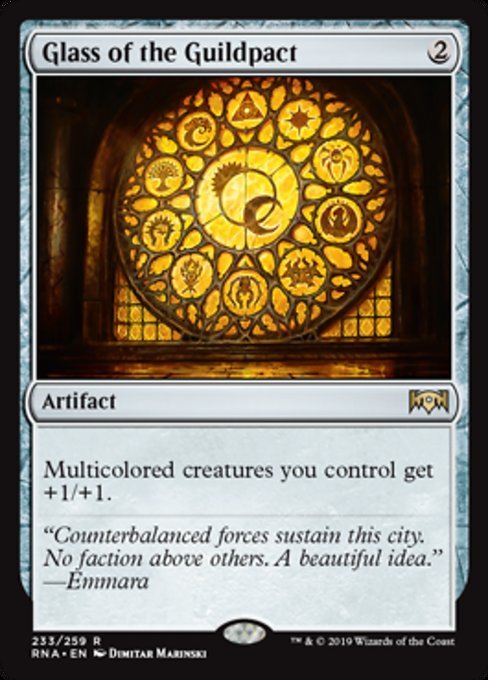
Glass of the Guildpact
AI Rating: 3.8Pro Rating: 0.0 // 2.5
This format has enough multicolored creatures that sometimes you’ll end up in a deck where it is worth running, but it won’t happen super often.
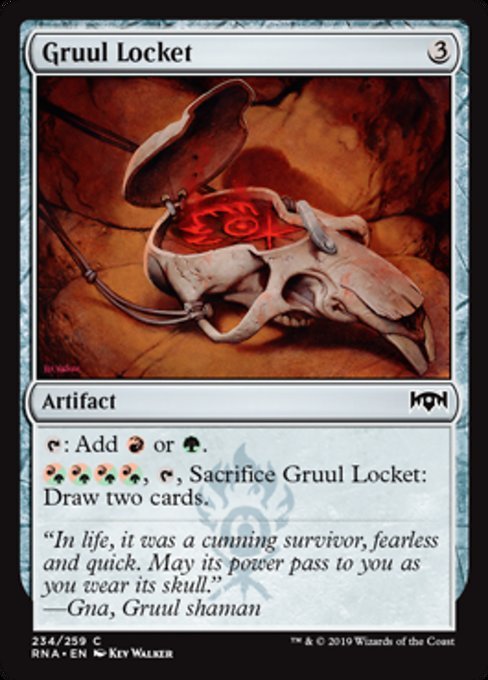
Gruul Locket
AI Rating: 1Pro Rating: 2.0
If you need fixing, these are fine. Some mana rocks are pretty big duds once you have enough mana or the mana that you need, but its nice you can throw these away to get some cards.
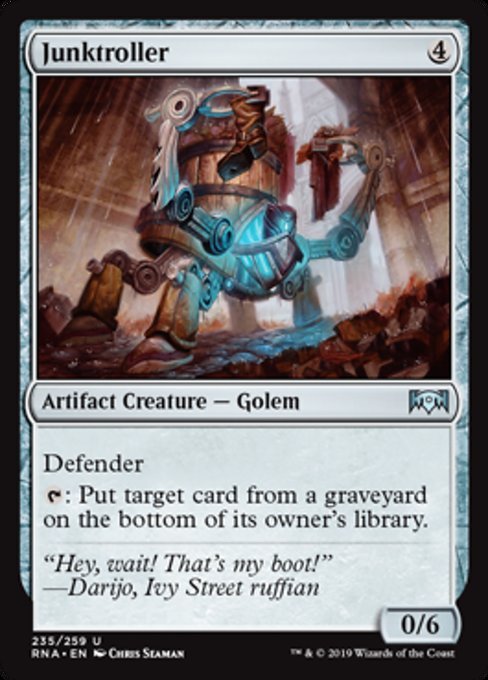
Junktroller
AI Rating: 0.9Pro Rating: 1.0
This format can do some grindy stuff, but Junktroller still isn’t something you should be interested in. The idea is that in the extreme late game you can choose what you draw every turn, but it just won’t work out that way very often.
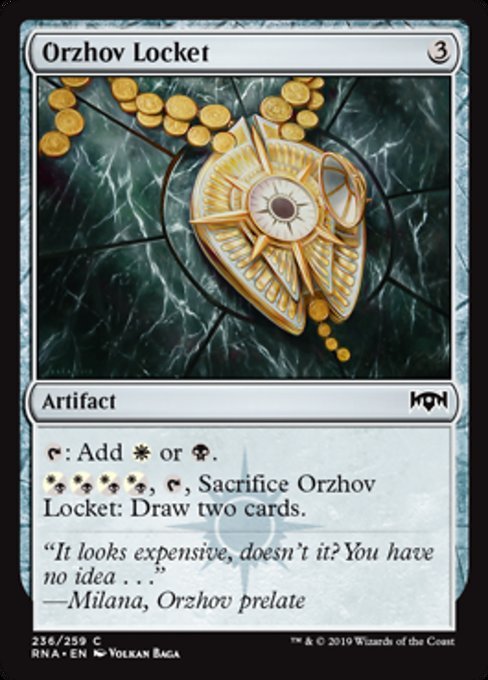
Orzhov Locket
AI Rating: 1.3Pro Rating: 2.0
If you need fixing, these are fine. Some mana rocks are pretty big duds once you have enough mana or the mana that you need, but its nice you can throw these away to get some cards.
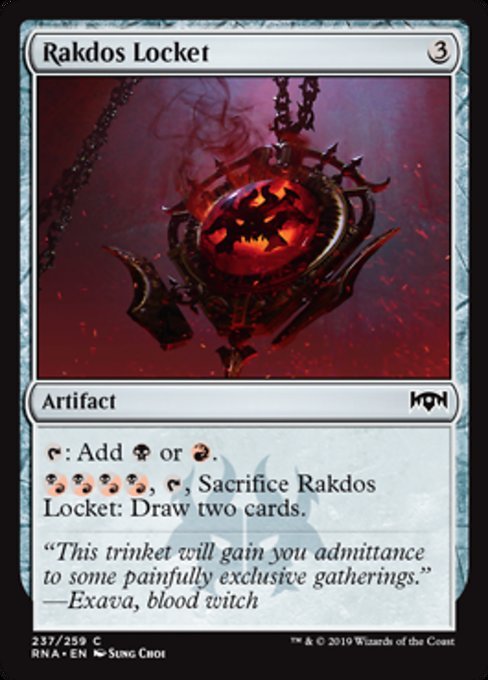
Rakdos Locket
AI Rating: 1.3Pro Rating: 2.0
If you need fixing, these are fine. Some mana rocks are pretty big duds once you have enough mana or the mana that you need, but its nice you can throw these away to get some cards.
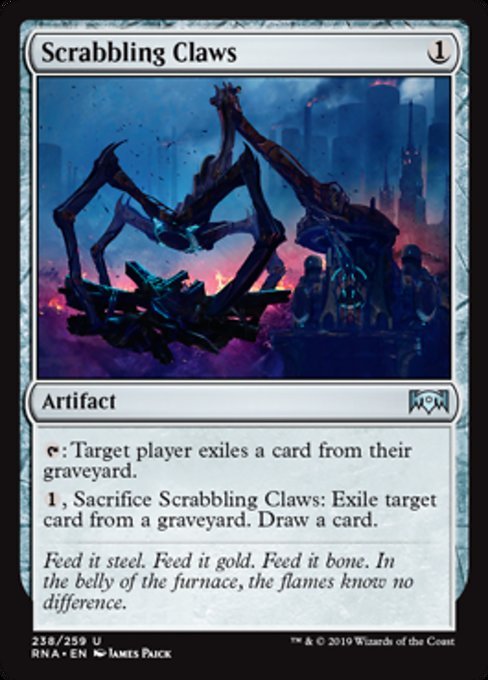
Scrabbling Claws
AI Rating: 0.8Pro Rating: 0.5
This is mostly a sideboard card to bring in against graveyard decks, and there aren’t really that many of those in this format anyway.
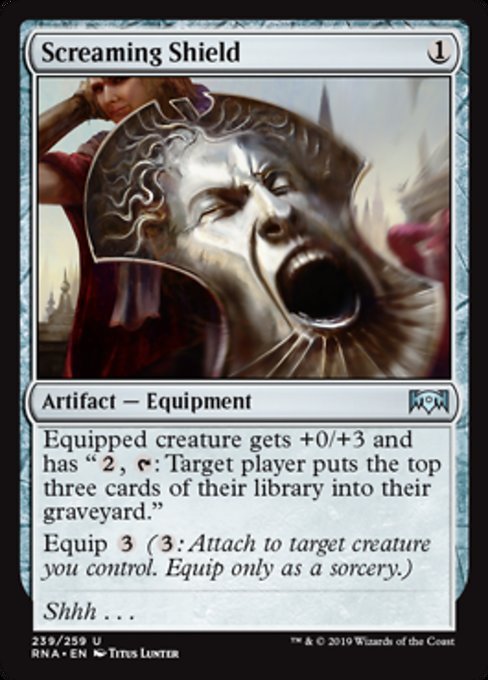
Screaming Shield
AI Rating: 0.8Pro Rating: 0.0
Mill sometimes work as a strategy in this format, but this is a really clunky way to go about it.
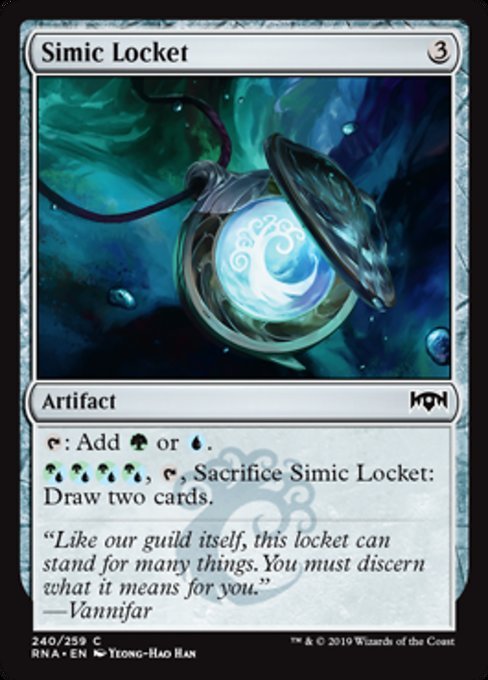
Simic Locket
AI Rating: 1.6Pro Rating: 2.0
If you need fixing, these are fine. Some mana rocks are pretty big duds once you have enough mana or the mana that you need, but its nice you can throw these away to get some cards.
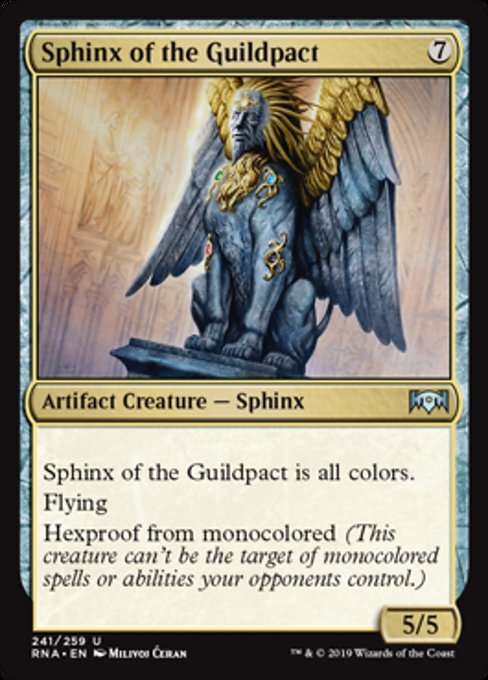
Sphinx of the Guildpact
AI Rating: 2.9Pro Rating: 2.0
You’re usually hoping for more than a 5/5 Flyer when you spend 7 mana, and luckily this does come with a fairly useful ability. It can blank a significant number of removal spells in the format. Of course, this format also has lots of multicolored removal spells, so it isn’t exactly unkillable either.
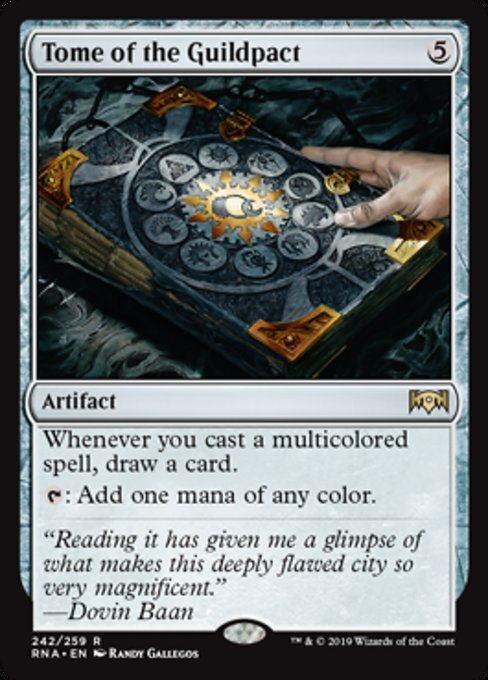
Tome of the Guildpact
AI Rating: 4.4Pro Rating: 3.5
This can be really powerful. Obviously you need a decent number of multicolored cards, but that’s very doable in the format. This will net you a ton of cards in most decks. The main downside is the fact that you have to play this clunky 5-mana artifact and hope that you get to untap and start getting those cards.
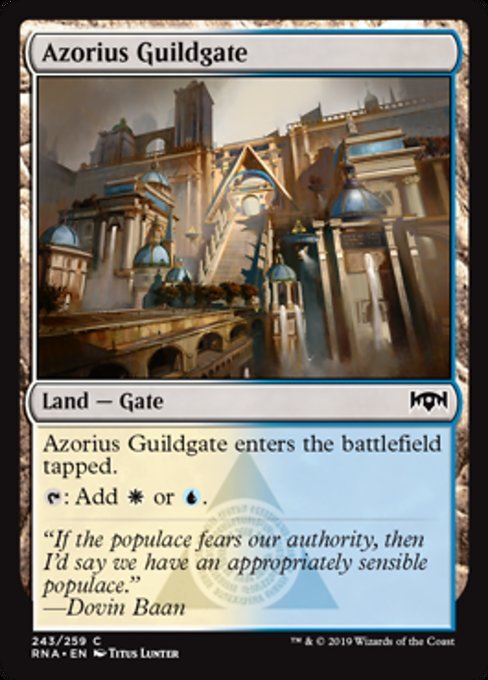
Azorius Guildgate
AI Rating: 2.6Pro Rating: 2.5
These are pretty important in this format. As usual fixing is always nice, but this format also has a ton of excellent gate payoffs. Its kind of funny, but in this Limited format, the Gates are actually a little better than Shocklands, since the payoffs you can get for playing Gates are so good.
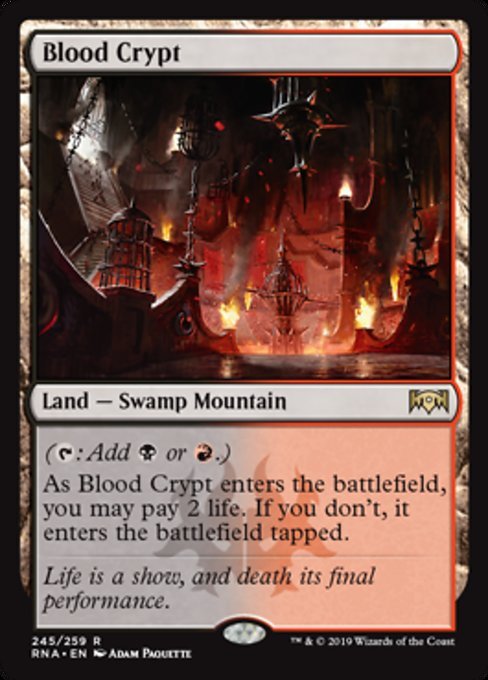
Blood Crypt
AI Rating: 3.9Pro Rating: 2.5
This offer some very nice fixing, and if you’re in the market for that they are definitely nice. They are worth taking any time you are splashing a color or they are in both of your colors.
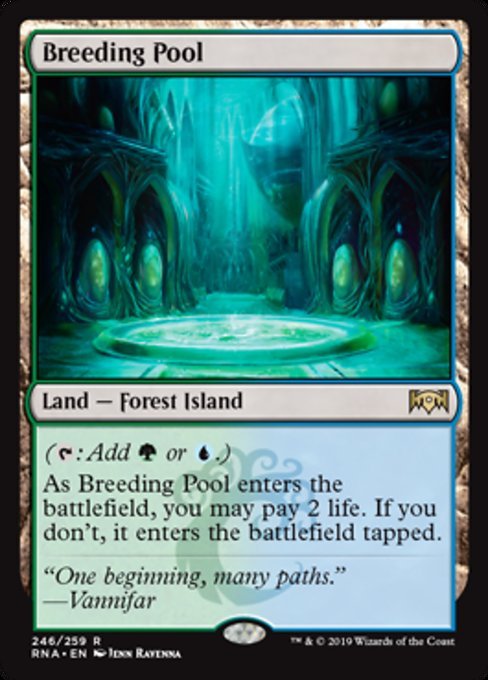
Breeding Pool
AI Rating: -0Pro Rating: 2.5
This offer some very nice fixing, and if you’re in the market for that they are definitely nice. They are worth taking any time you are splashing a color or they are in both of your colors.
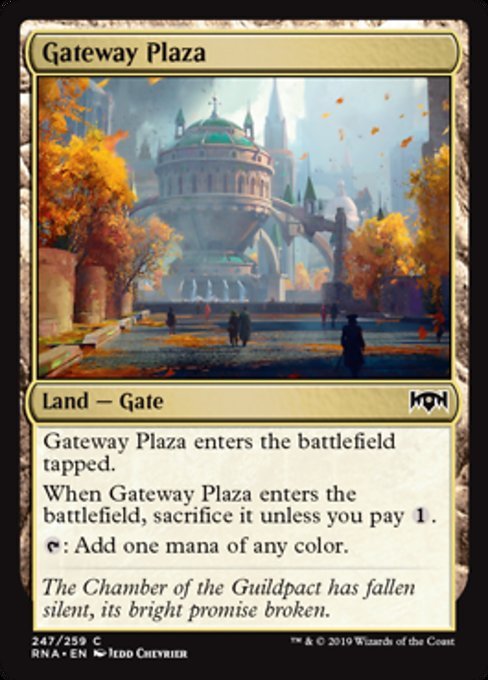
Gateway Plaza
AI Rating: 2.1Pro Rating: 2.5
This comes with the “Gate” type, which means you’ll want it in many decks, and it also does a decent job of fixing.
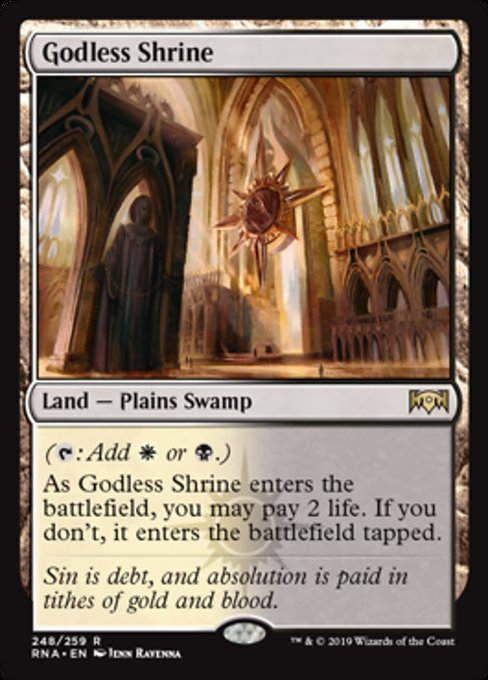
Godless Shrine
AI Rating: -0Pro Rating: 2.5
This offer some very nice fixing, and if you’re in the market for that they are definitely nice. They are worth taking any time you are splashing a color or they are in both of your colors.
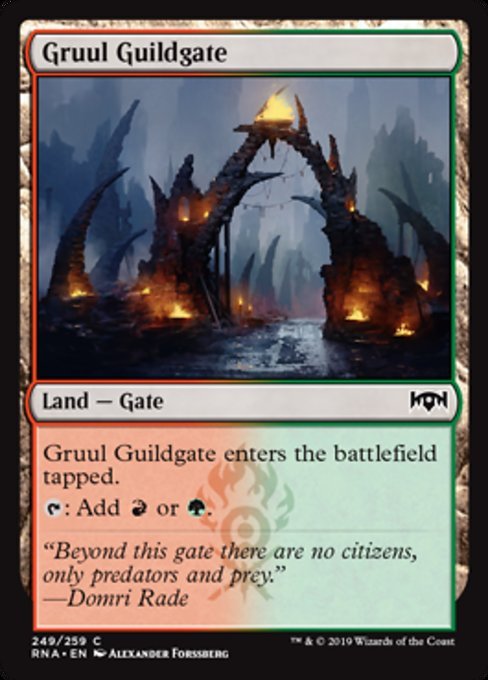
Gruul Guildgate
AI Rating: 2.5Pro Rating: 2.5
These are pretty important in this format. As usual fixing is always nice, but this format also has a ton of excellent gate payoffs. Its kind of funny, but in this Limited format, the Gates are actually a little better than Shocklands, since the payoffs you can get for playing Gates are so good.
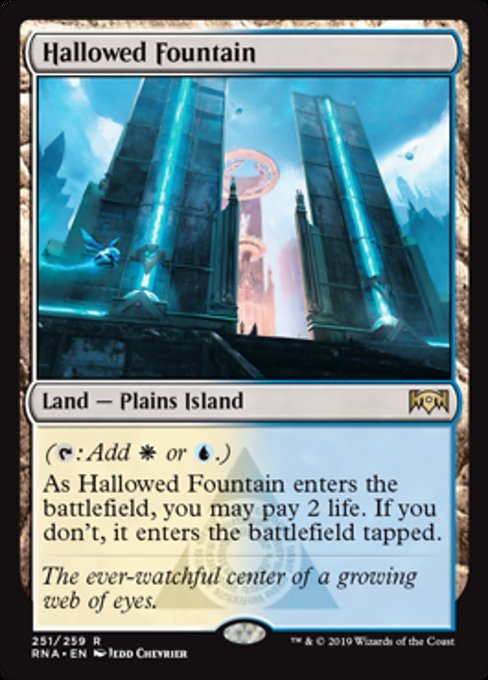
Hallowed Fountain
AI Rating: 3.9Pro Rating: 2.5
This offer some very nice fixing, and if you’re in the market for that they are definitely nice. They are worth taking any time you are splashing a color or they are in both of your colors.
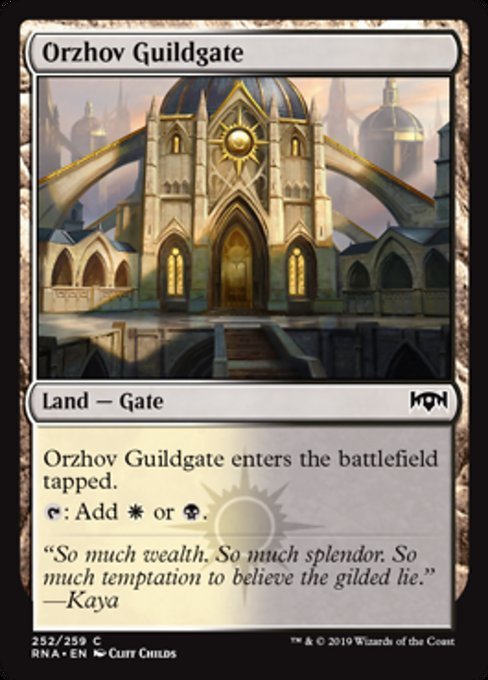
Orzhov Guildgate
AI Rating: 2.6Pro Rating: 2.5
These are pretty important in this format. As usual fixing is always nice, but this format also has a ton of excellent gate payoffs. Its kind of funny, but in this Limited format, the Gates are actually a little better than Shocklands, since the payoffs you can get for playing Gates are so good.
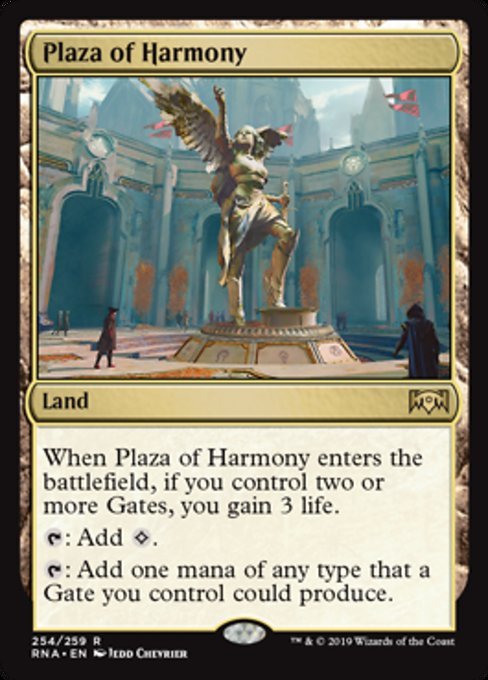
Plaza of Harmony
AI Rating: 2.5Pro Rating: 0.0 // 2.5
If your deck has enough gates in it, this is a pretty reasonable land, as the 3 life is really helpful. But you probably need 7+ gates before you should consider playing it.
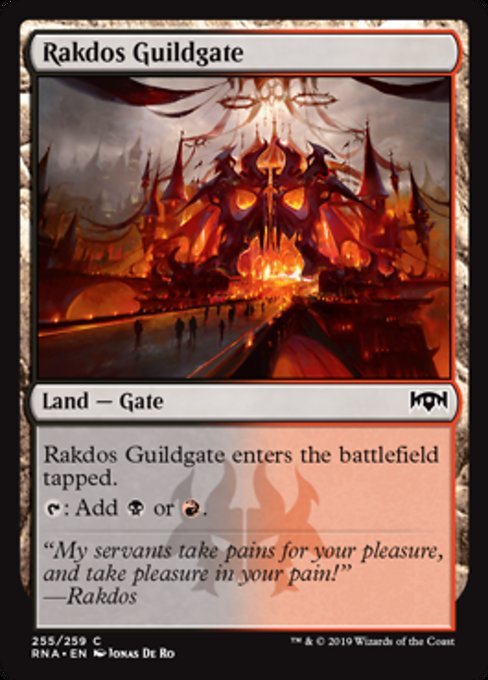
Rakdos Guildgate
AI Rating: 2.4Pro Rating: 2.5
These are pretty important in this format. As usual fixing is always nice, but this format also has a ton of excellent gate payoffs. Its kind of funny, but in this Limited format, the Gates are actually a little better than Shocklands, since the payoffs you can get for playing Gates are so good.

Simic Guildgate
AI Rating: 2Pro Rating: 2.5
These are pretty important in this format. As usual fixing is always nice, but this format also has a ton of excellent gate payoffs. Its kind of funny, but in this Limited format, the Gates are actually a little better than Shocklands, since the payoffs you can get for playing Gates are so good.
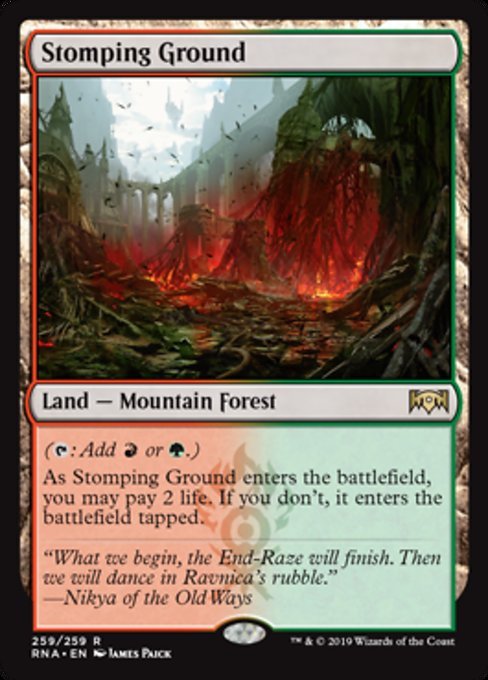
Stomping Ground
AI Rating: 3.9Pro Rating: 2.5
This offer some very nice fixing, and if you’re in the market for that they are definitely nice. They are worth taking any time you are splashing a color or they are in both of your colors.
|
|
Gruul | 278 matches | 33 decks |
|
|
Orzhov | 283 matches | 33 decks |
|
|
Azorius | 264 matches | 31 decks |
|
|
Rakdos | 209 matches | 25 decks |
|
|
Simic | 183 matches | 22 decks |
|
|
Esper | 113 matches | 13 decks |
|
|
Bant | 52 matches | 6 decks |
|
|
Golgari | 26 matches | 3 decks |
|
|
Izzet | 25 matches | 3 decks |
|
|
Temur | 15 matches | 2 decks |
|
|
Jund | 17 matches | 2 decks |
|
|
Boros | 18 matches | 2 decks |
|
|
Mardu | 18 matches | 2 decks |
|
|
Selesnya | 9 matches | 1 decks |
|
|
Dimir | 9 matches | 1 decks |
|
|
Sultai | 8 matches | 1 decks |

